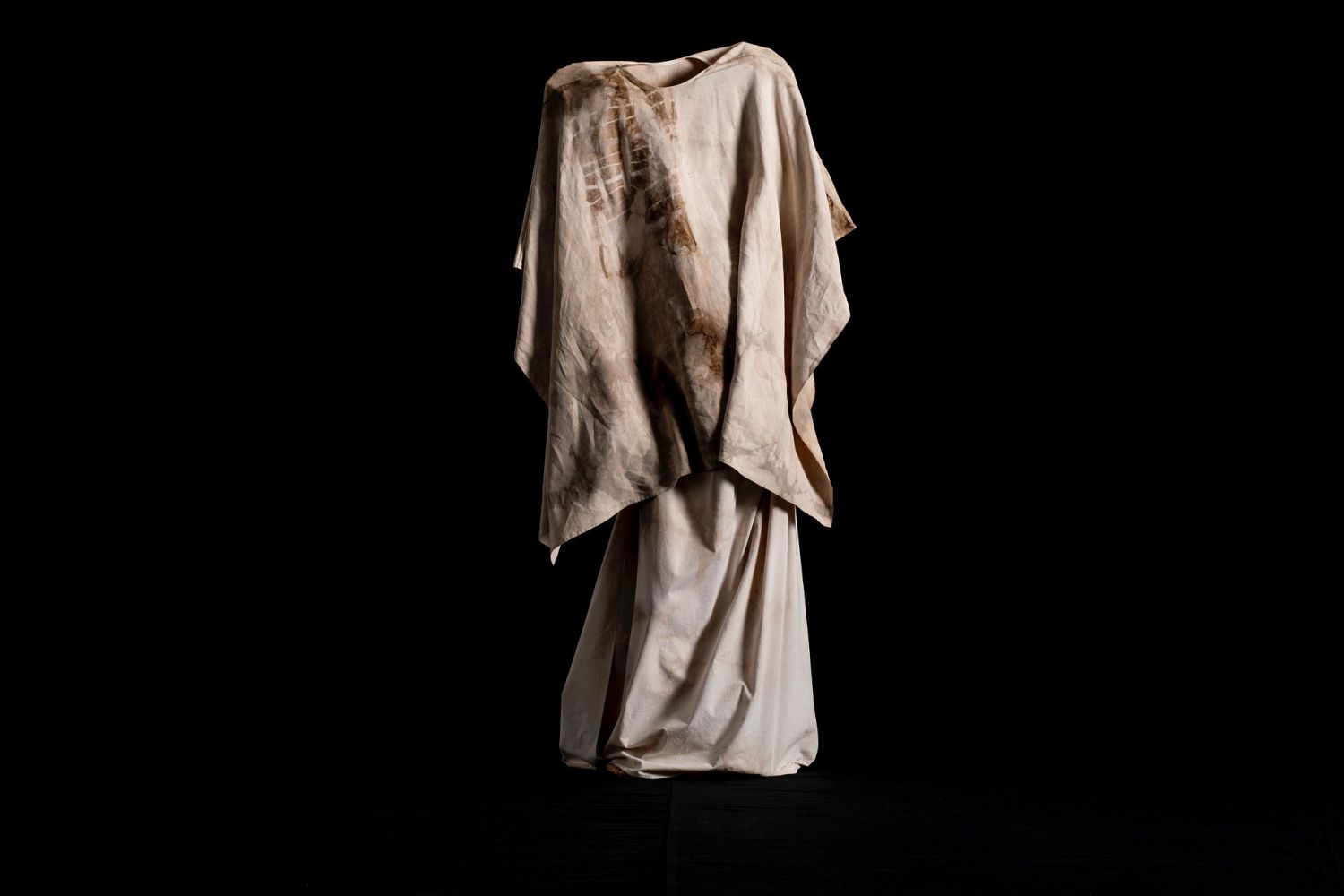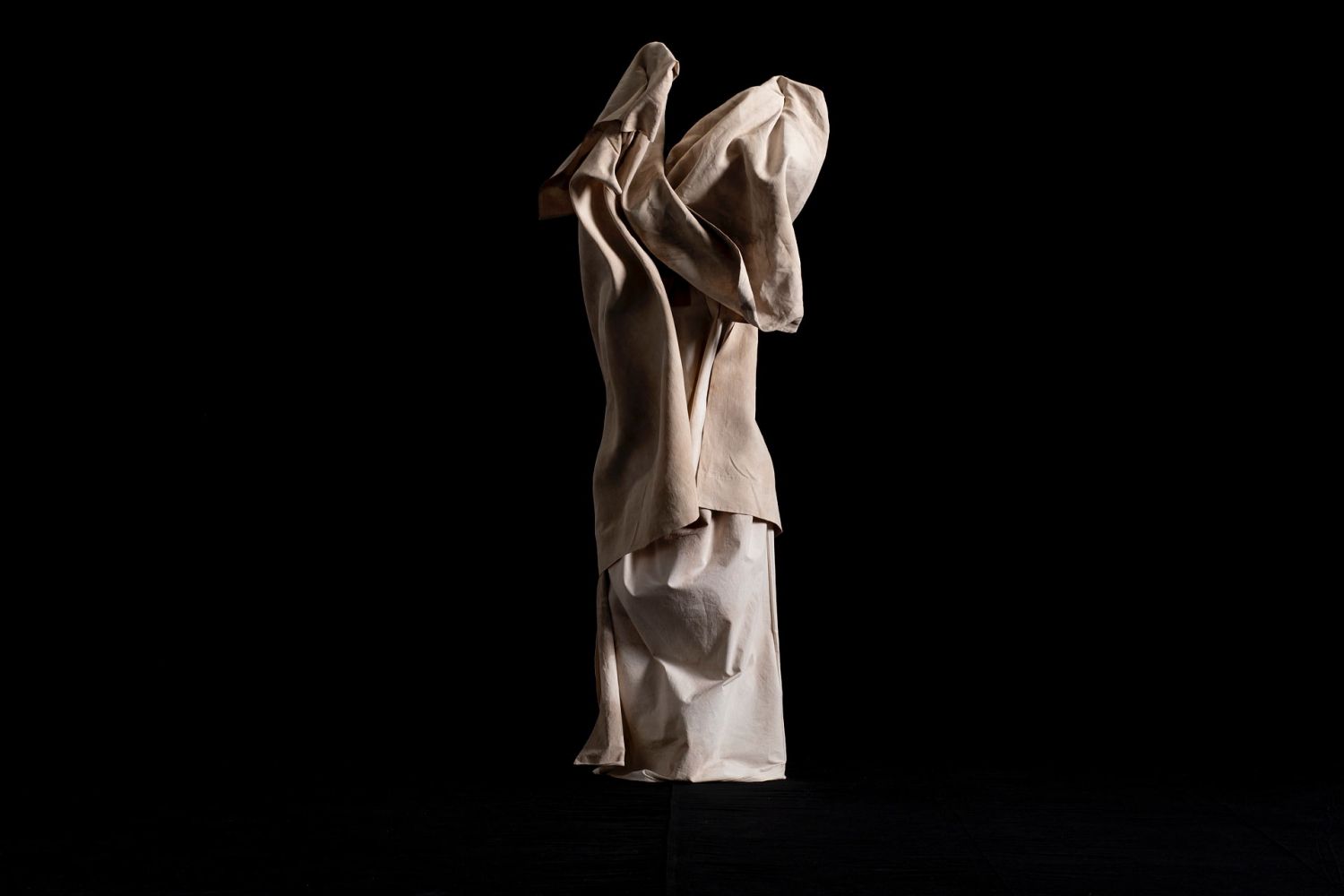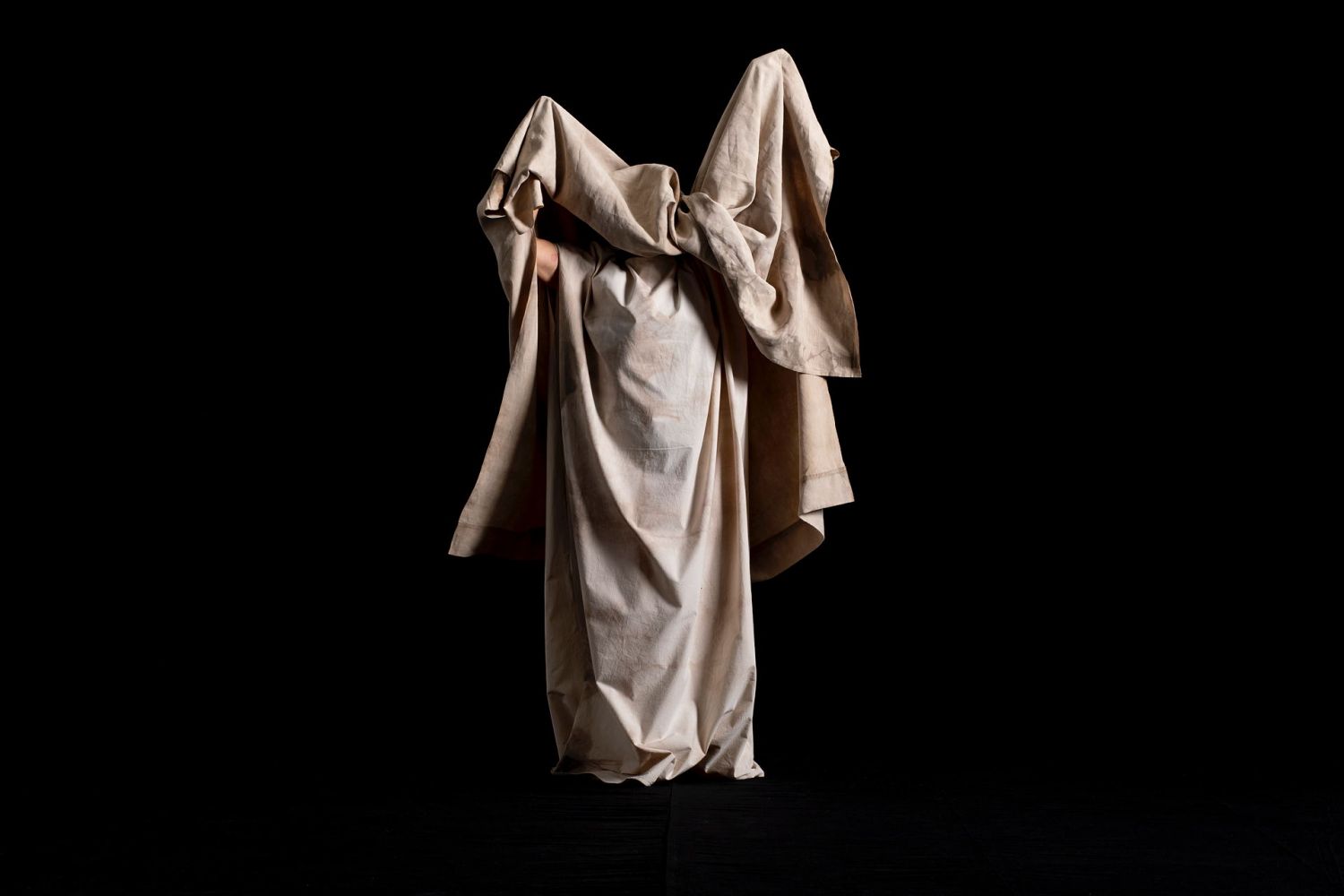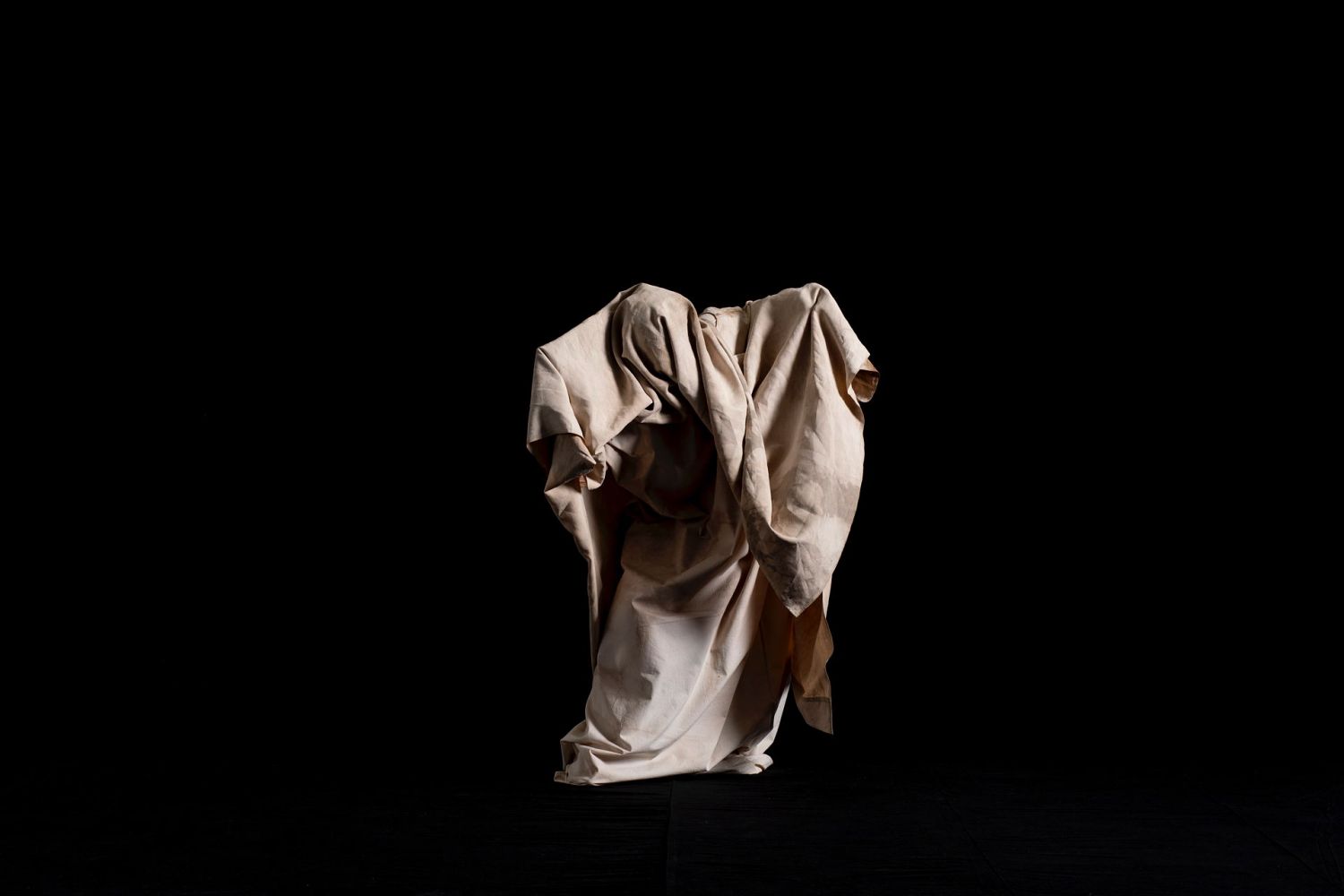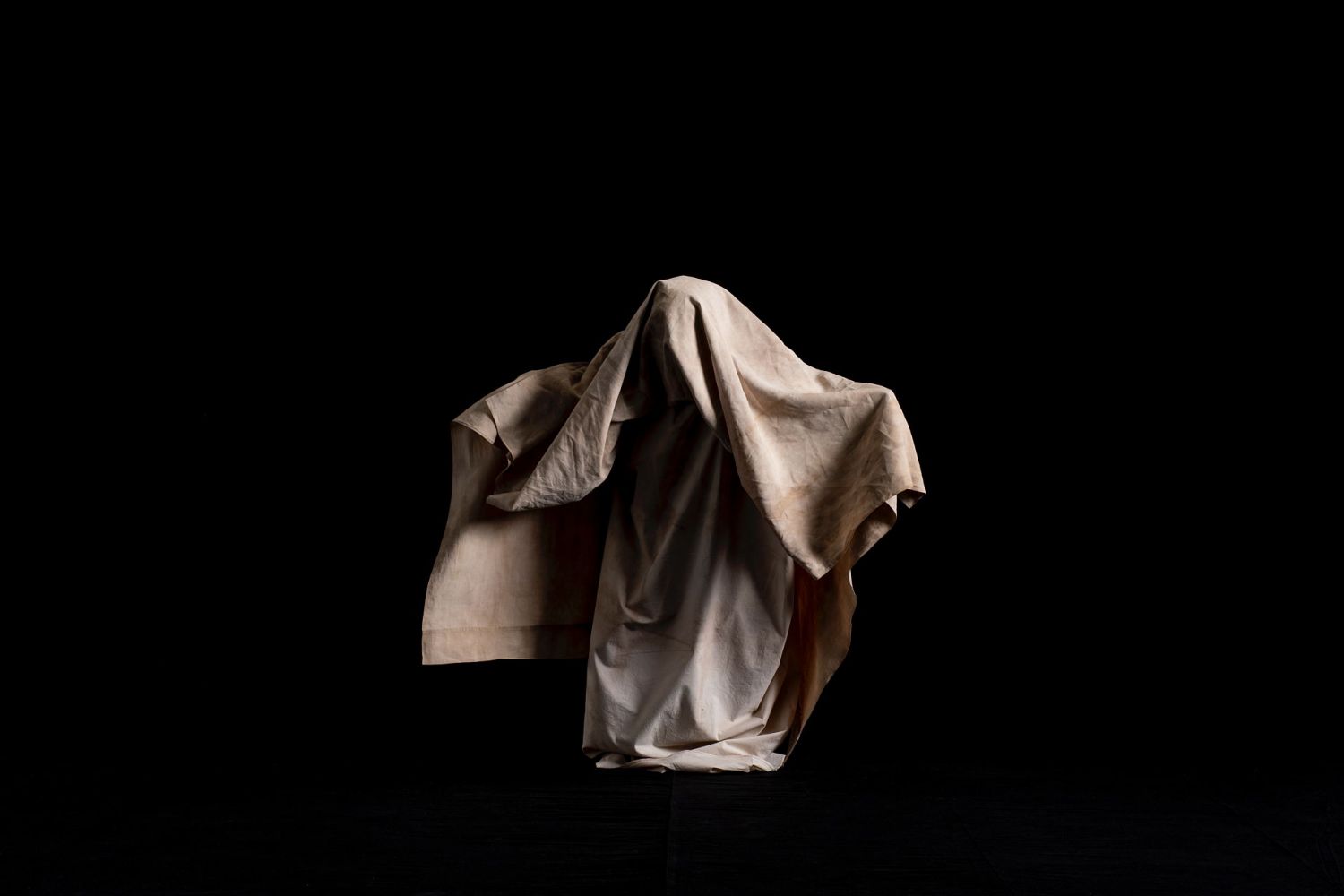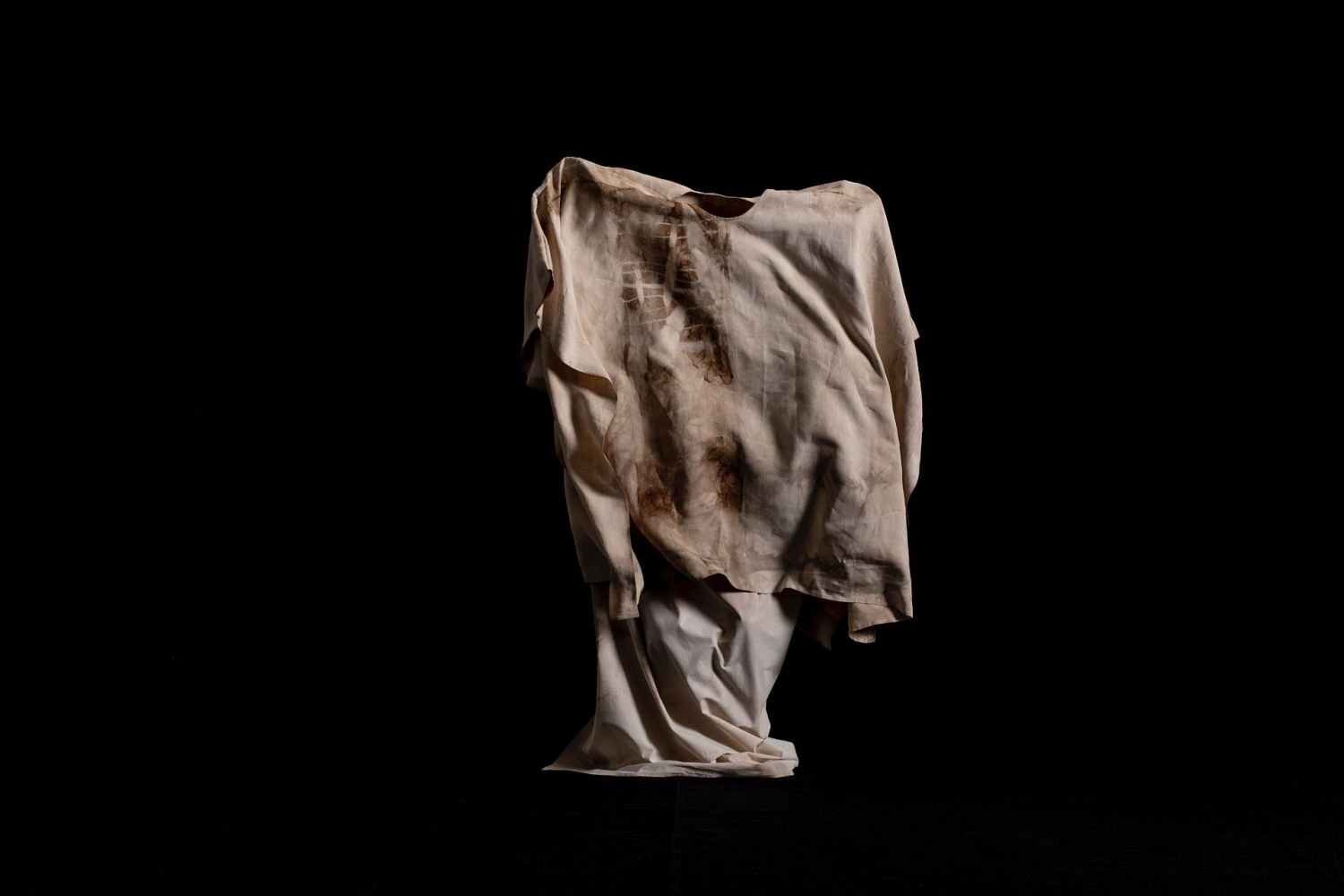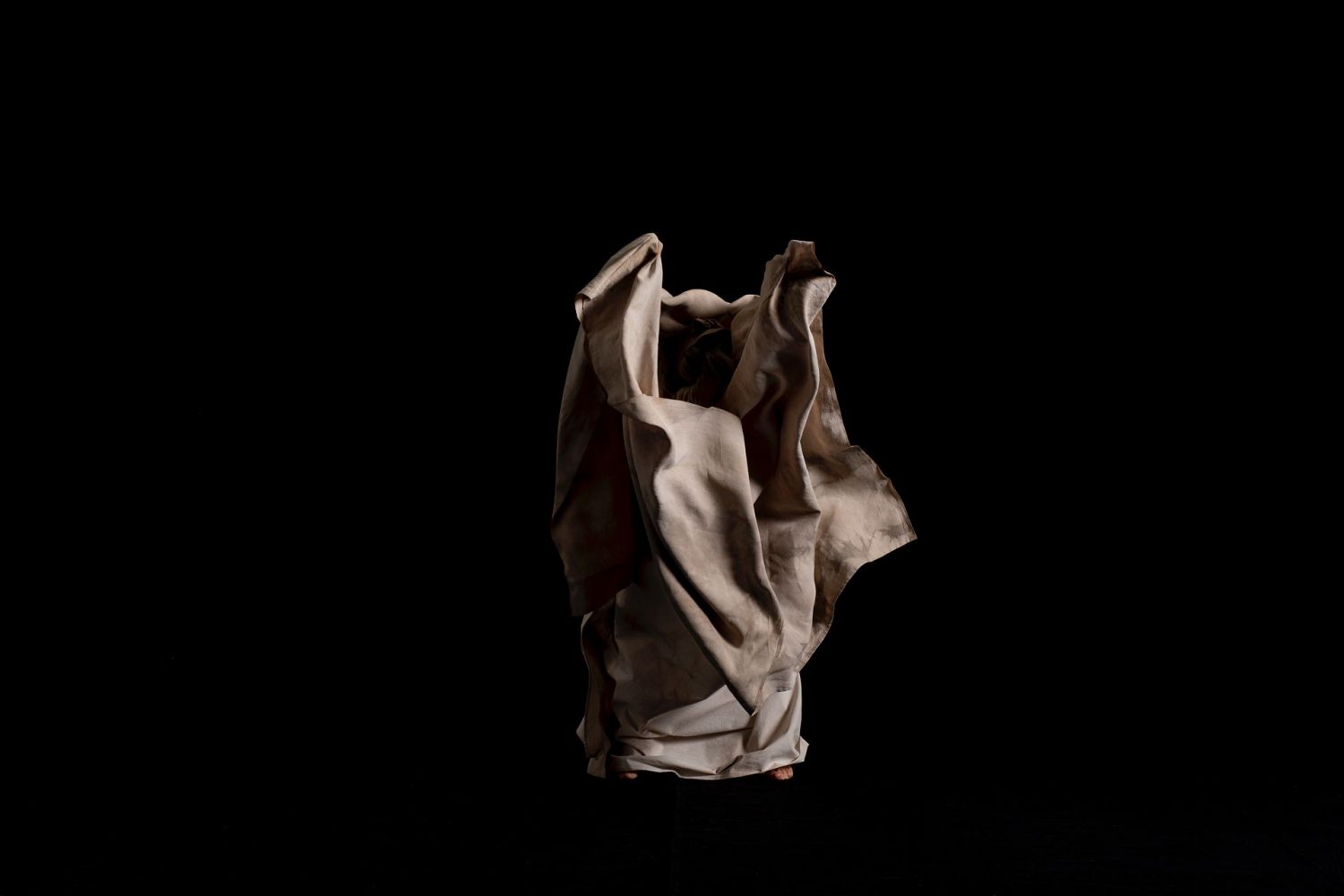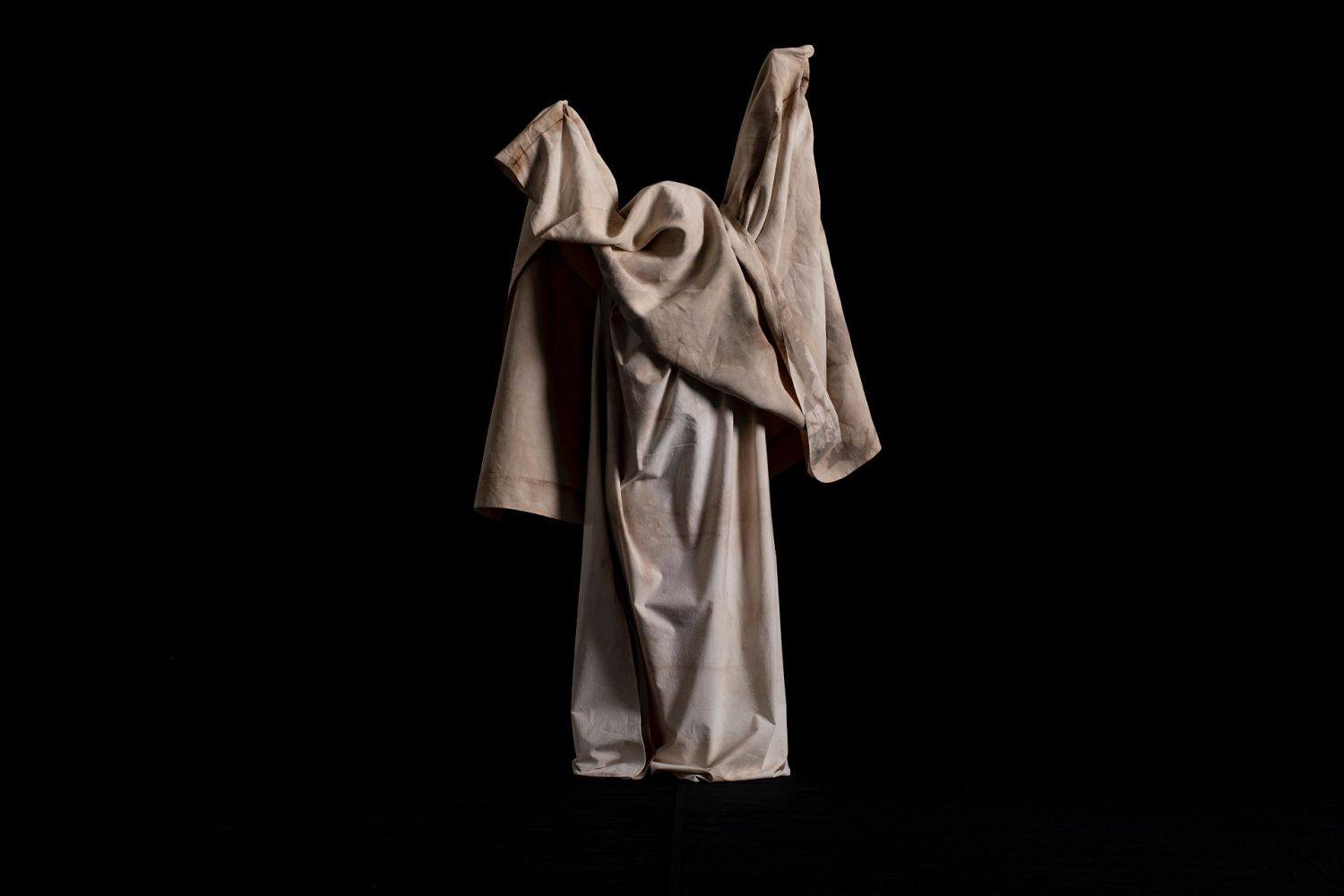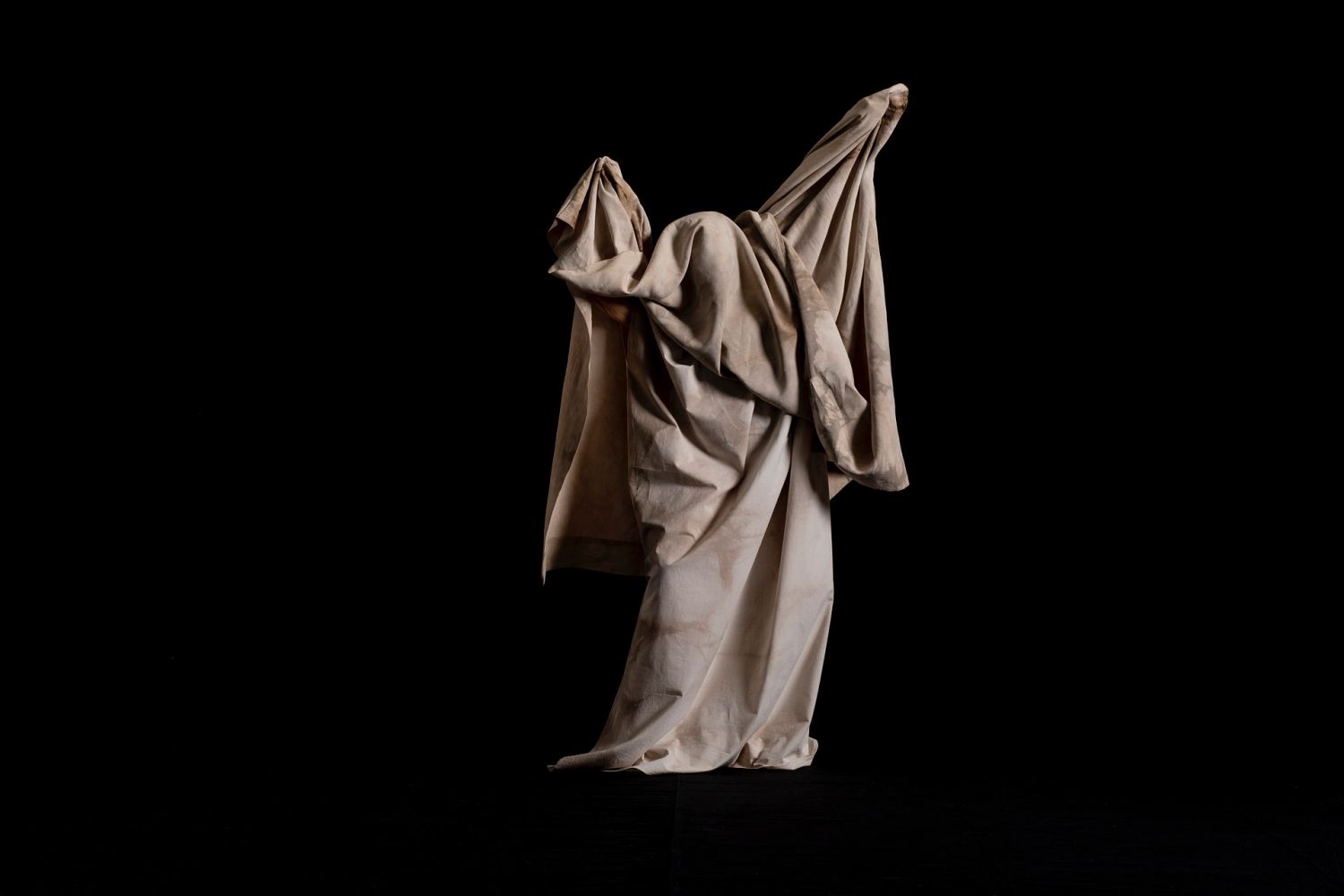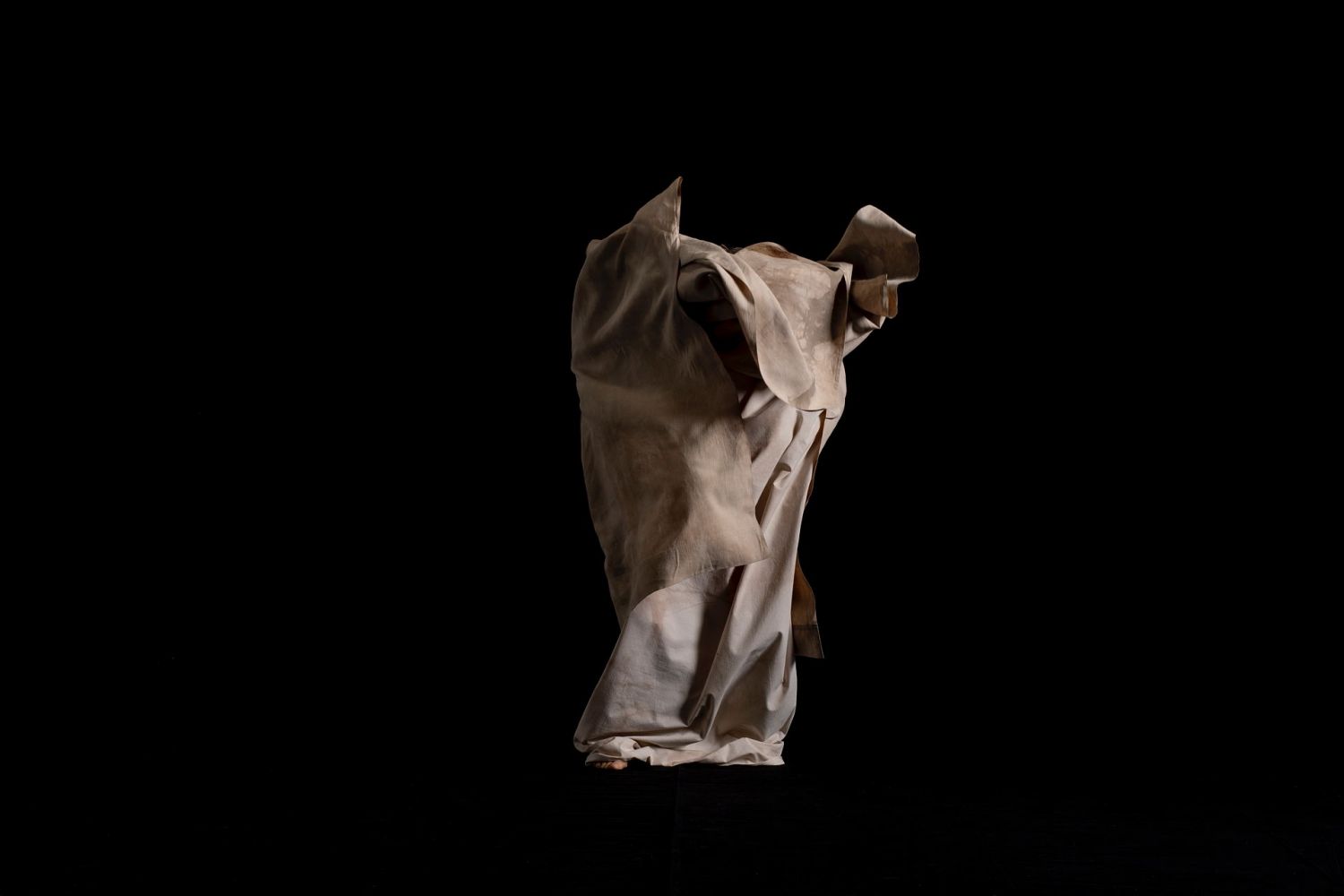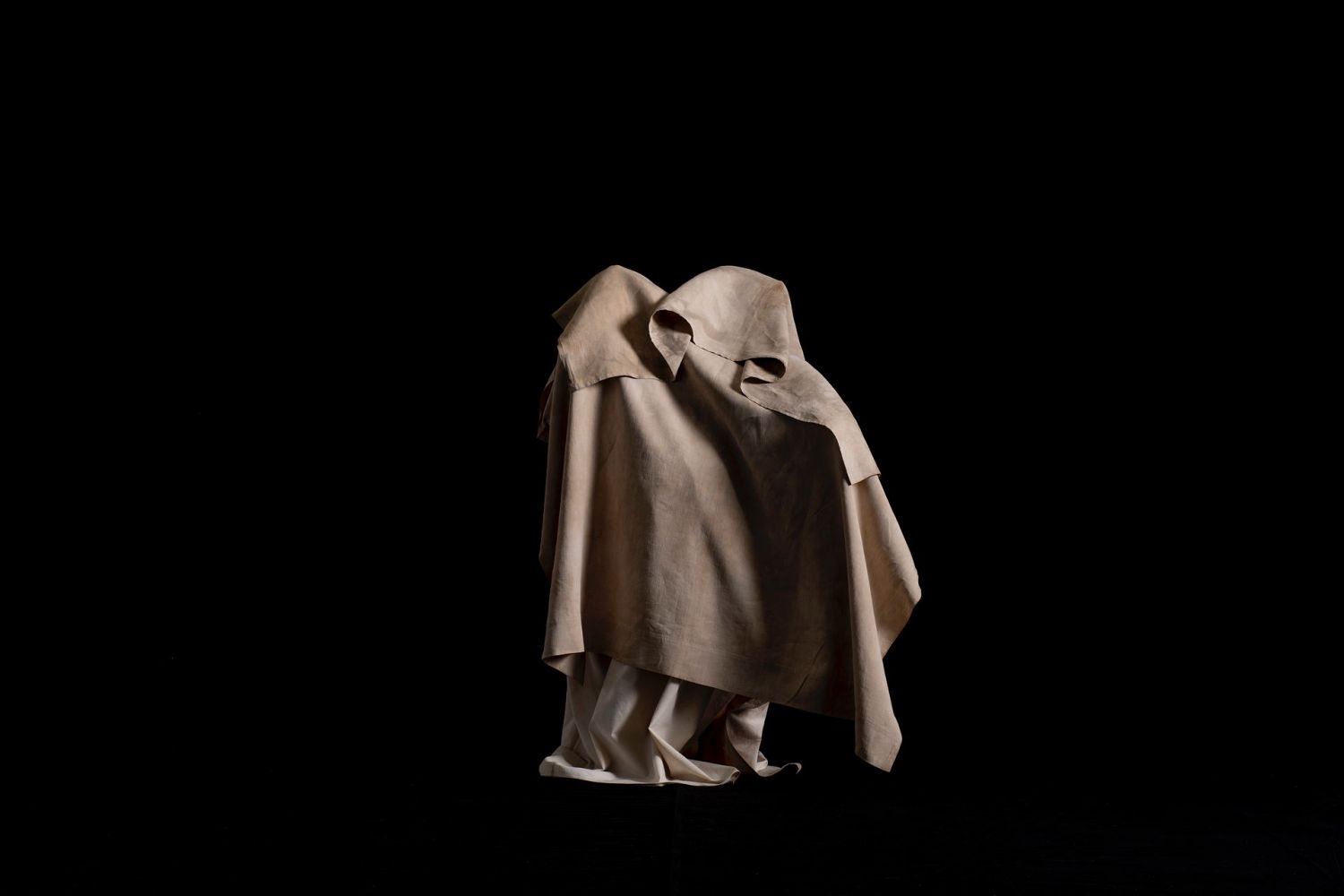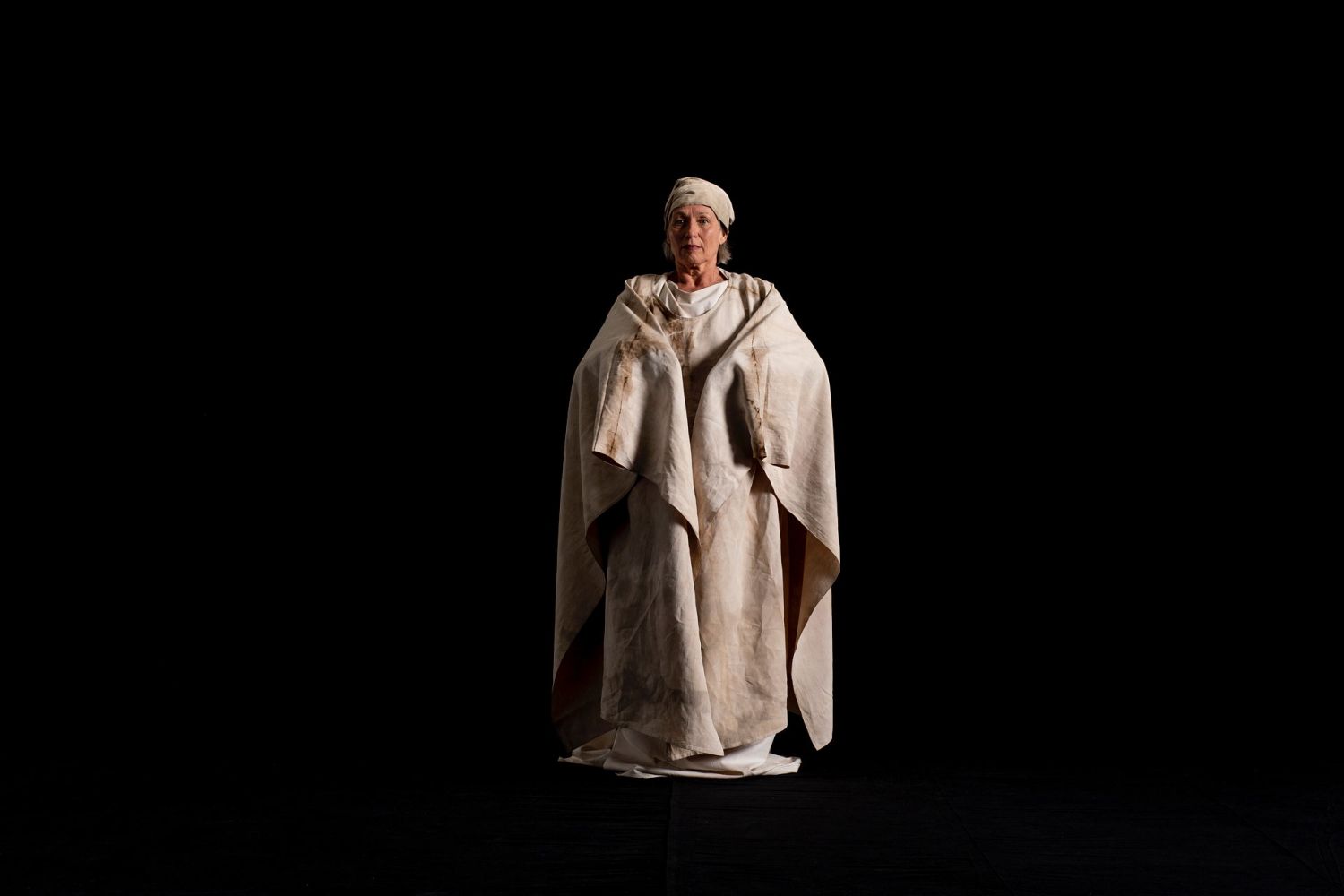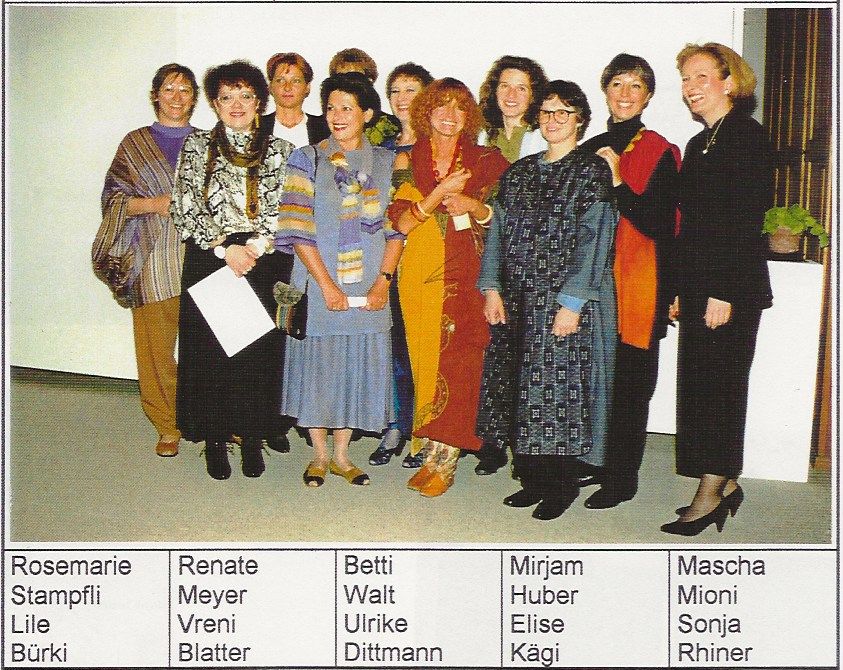

2021 Art to Wear dress Dorothea
After a visit to the hermitage of the canonized hermite Brother Klaus (Niklaus von Flüe), Mascha Mioni created the Art to Wear dress "Dorothea" in memory of the hard lot of his wife Dorothea von Flüe.
The photographs by Carlos Rieder were taken at the studio-performance "Dorothea von Flüe und Überall".
More than 100 yar old hand woven linen, dyed with walnut shells and leafs.
After a visit to the hermitage of the canonized hermite Brother Klaus (Niklaus von Flüe), Mascha Mioni created the Art to Wear dress "Dorothea" in memory of the hard lot of his wife Dorothea von Flüe.
The photographs by Carlos Rieder were taken at the studio-performance "Dorothea von Flüe und Überall".
More than 100 yar old hand woven linen, dyed with walnut shells and leafs.
go to post
-
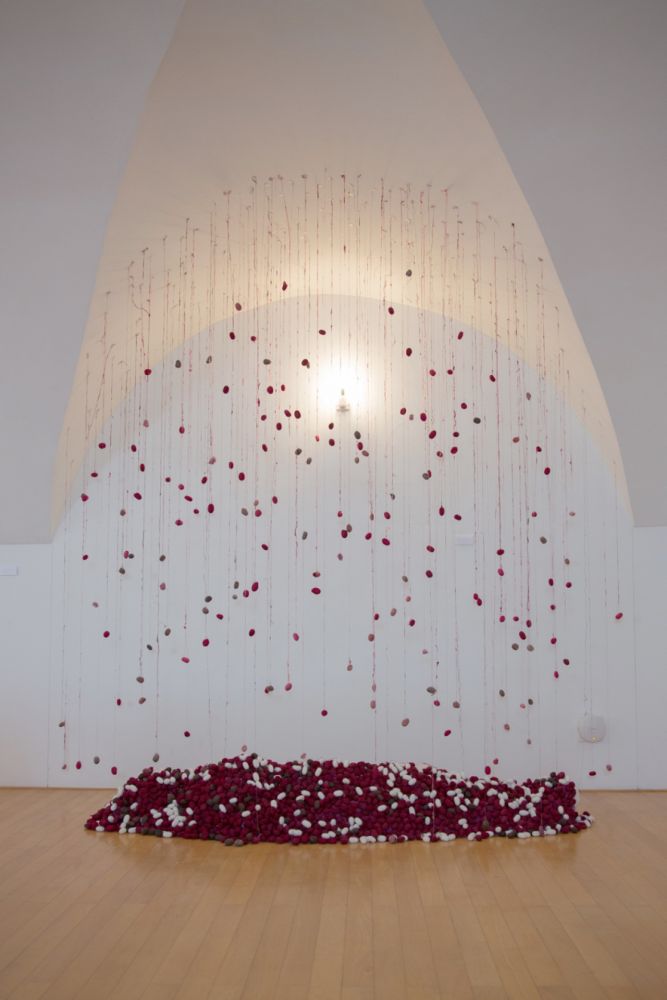
Two Lives, Many Lives, 2018, Yoshiko I. Wada
Installation:
Silk waste cocoons dyed with cochineal, hand manipulated, suspended and piled
-
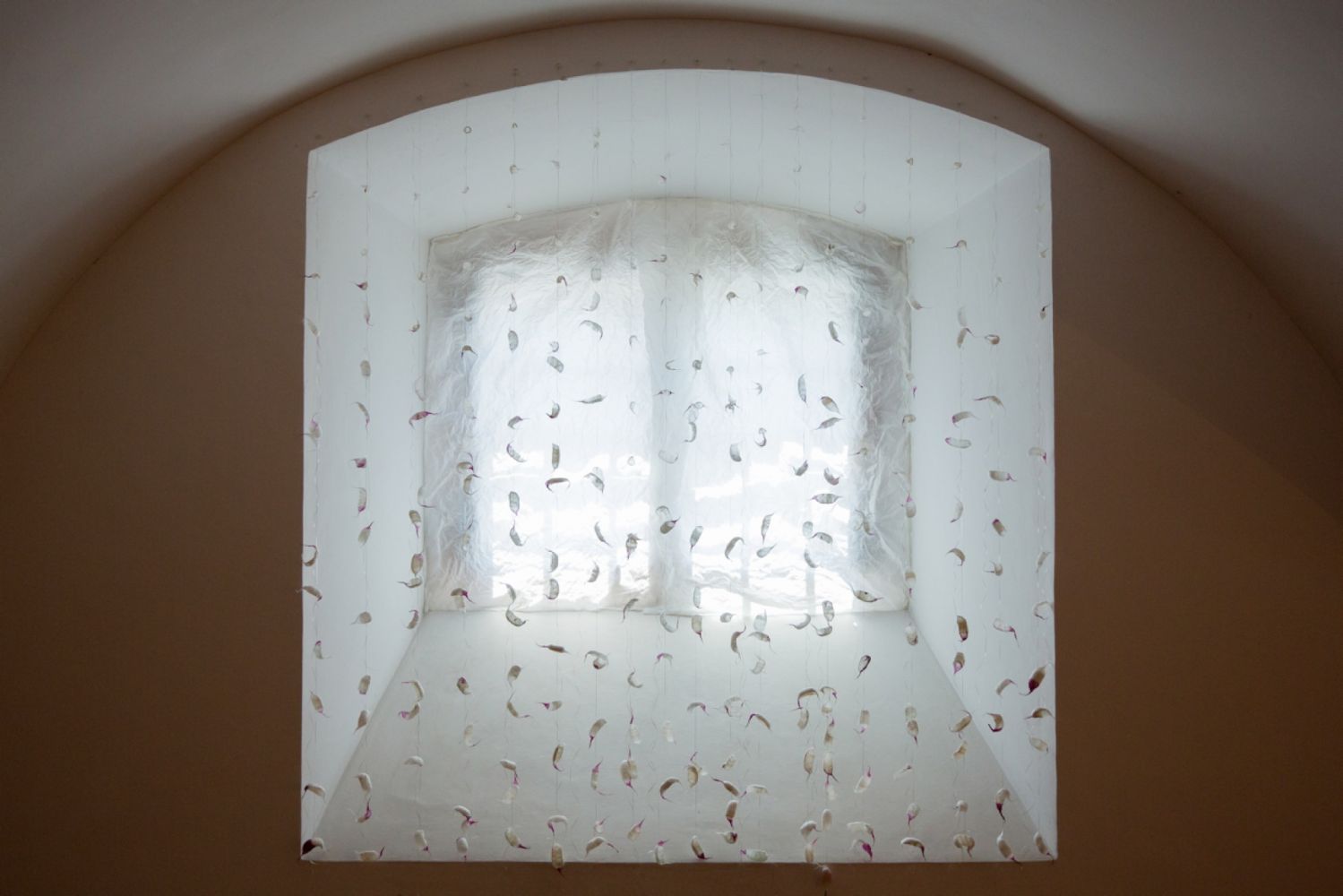
Two Lives, Many Lives, 2018, Yoshiko I. Wada
Installation:
Silk carrier rods are hand manupilated and formed and stained with cochineal ink. They are stringed with monofilament and suspended in front of a milky transparent window -
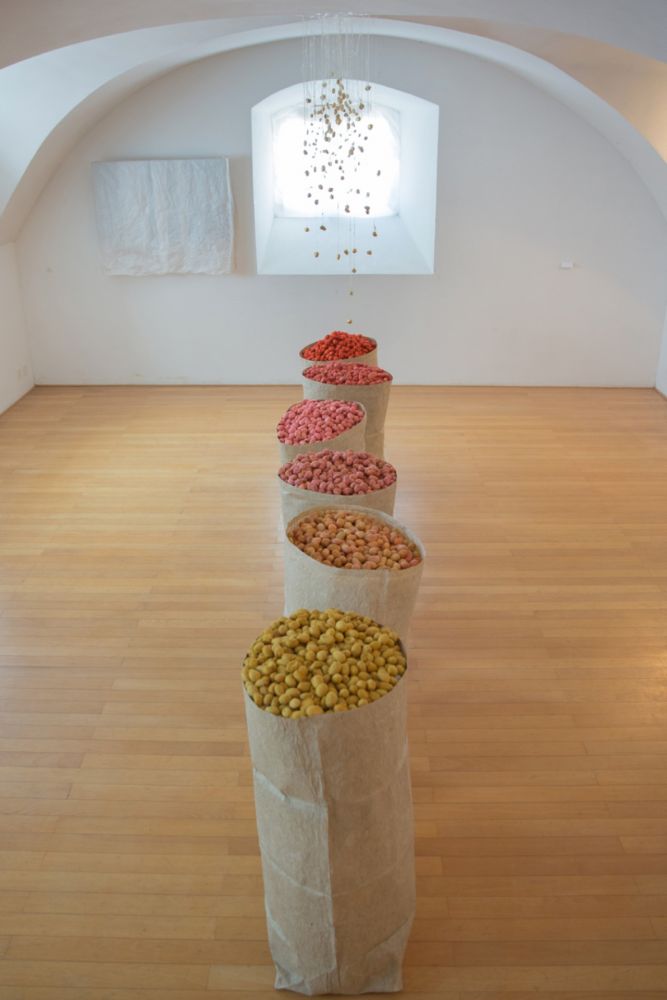
Beni = Gold, Yoshiko I. Wada, 2018
Installation:
silk waste cocoons hand manupliated, gold leafed
This first installation from the Beni=Gold series challenges our notion of value. Paper money is the most
familiar form of currency for modern people. In the past, Japanese red dye or beni was once so precious
that by its weight it was as expensive as gold. Along the silk road, bolts of silk cloth were traded as a form
of currency as they were versatile, compact, and sustainable.
-

Beni = Gold, Yoshiko I. Wada, 2018
-

Beni = Gold, Yoshiko I. Wada, 2018
-

Origami Folds, Patterning Paper Yukata, Ana Lisa Hedstrom, 2017
Installation: Indigo on paper, folded and wrapped
each composition 100 x 76 cmFolds have been an intrinsic part of my shibori dyeing, so it was inevitable that I would investigate origami folding. The preliminary folds for creating most origami figures are called the diamond, bird, frog, and fish. By dyeing the surface of these simple folds a variety of geometric patterns are revealed.
In Japan there is a long tradition of wearing indigo dyed cotton kimono called Yukata. They are donned after the bath or on hot humid summer nights especially for festivals.
The Yukata kimono shape is the perfect way to display the compositions of the paper squares which are pinned to a wall. I love how a larger graphic image is created with the various arrangements.
-

Origami Folds, Patterning Paper Yukata, Ana Lisa Hedstrom, 2017
-
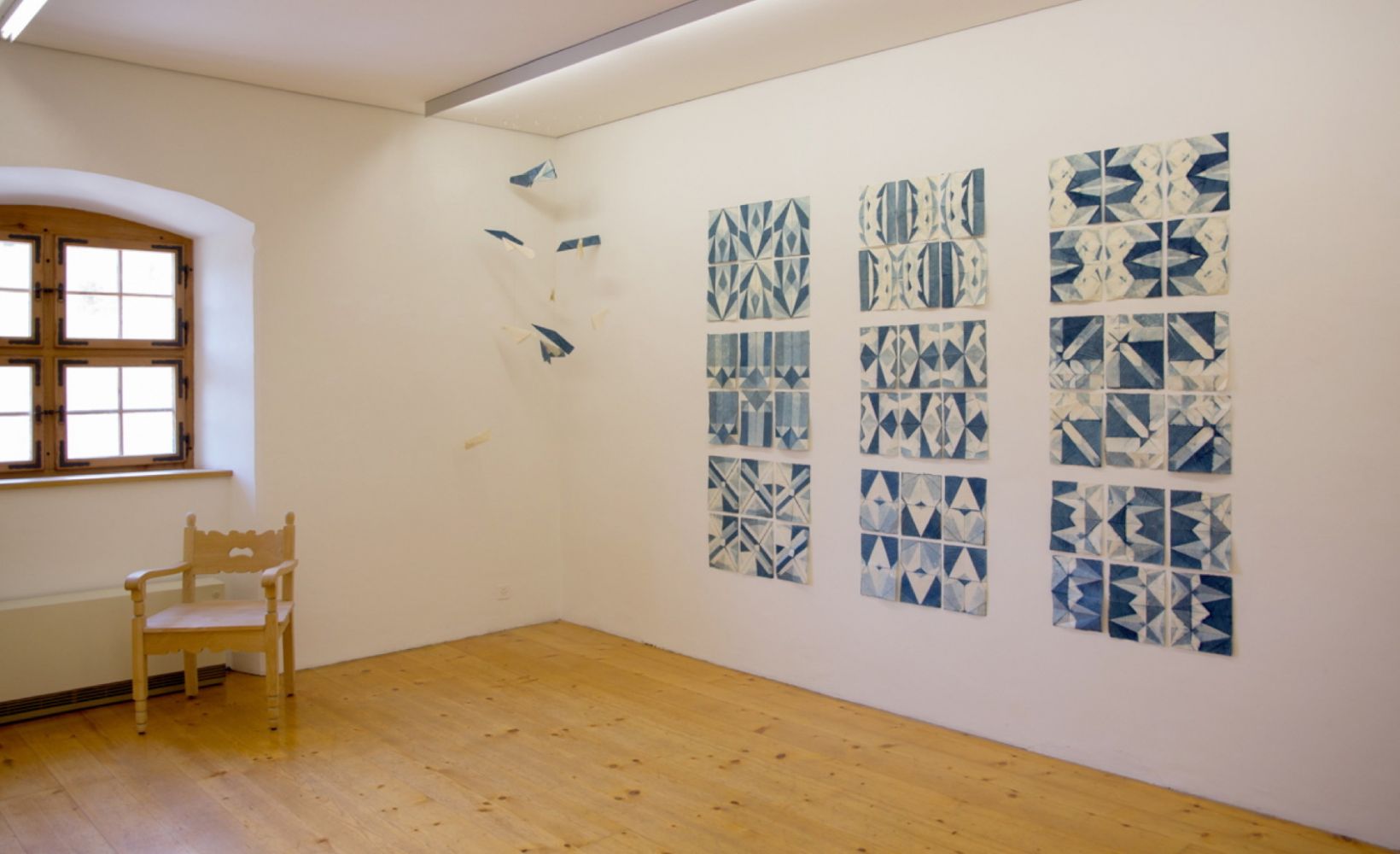
Folded & Flat, Revealing the Geometry of Paper Airplanes, Ana Lisa Hedstrom, 2017
Installation: Indigo on paper, folded and wrapped
each column of three compositions : 200 x 68 cm
Who doesn’t love paper airplanes? I fold my paper in a variety of paper airplanes, dye it in indigo on both sides, and when unfolded a geometric pattern appears. I love composing the sheets into compo-sitions which are reminiscent of quilts. Quilts, just like paper airplanes are usually made of throw away material or paper.
This complete installation includes a shaft of suspended folded paper planes and three columns of paper compositions.
-
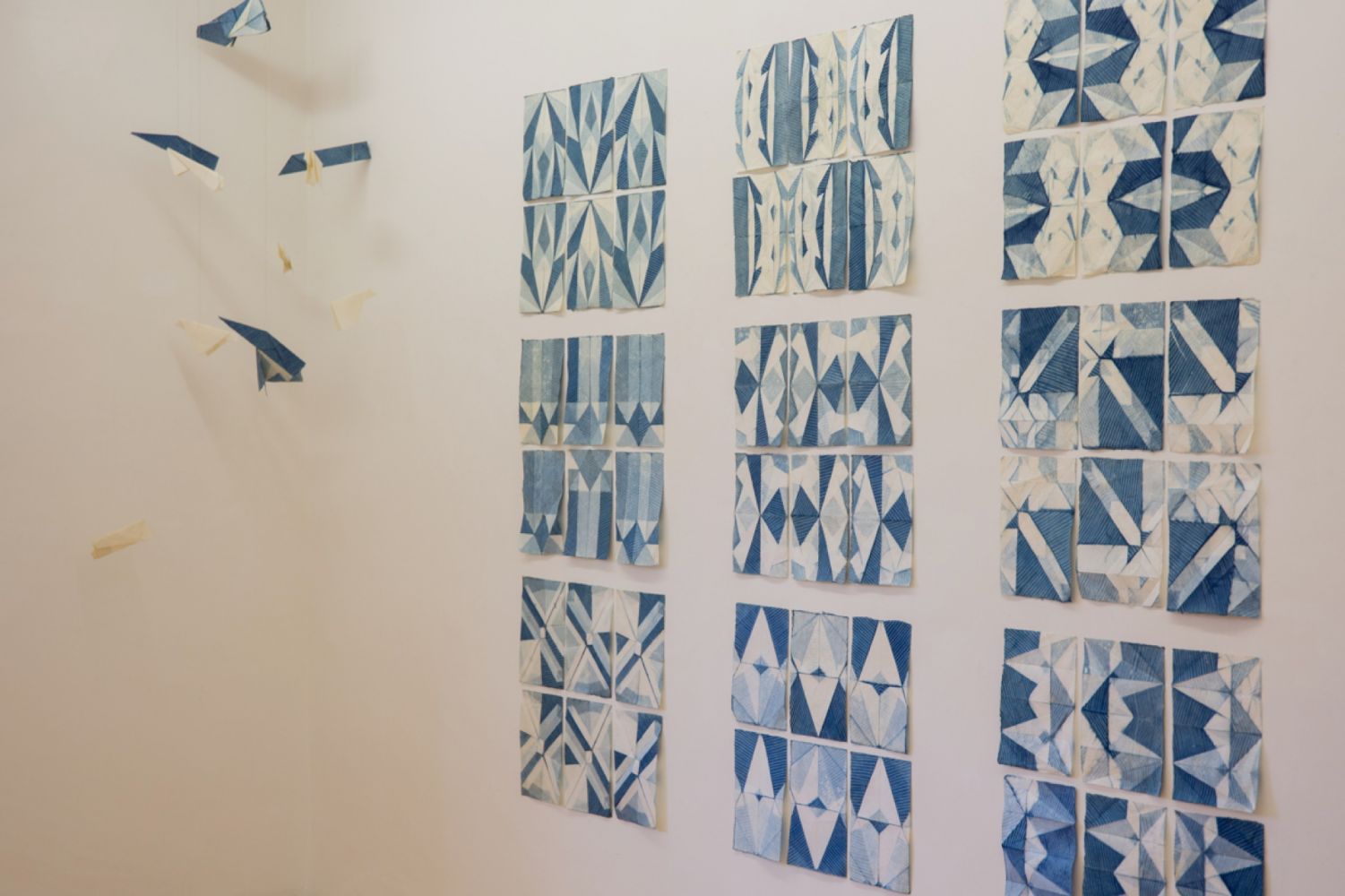
Folded & Flat, Revealing the Geometry of Paper Airplanes, Ana Lisa Hedstrom, 2017
-
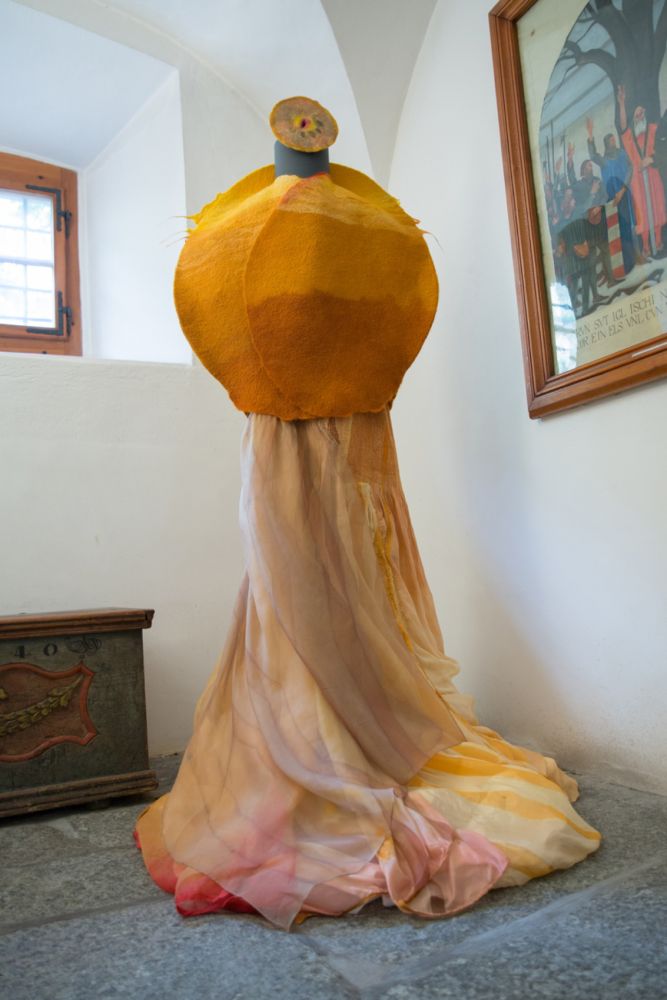
Sunset Over Uji River, Jorie Johnson, 2014
Ensemble: Cape with strapless evening gown, felted
The concept image is taken from the intense amber glow of the setting sun on the flowing Uji River behind my studio in southern Kyoto.
The traditional Turkish shepherd’s Kepenek felt cloak is dramatized in the hopes it will appear on a “Contemporary Nomad” on the Hollywood Red Carpet (which I do believe the origin of historically was red felt from Asia).
-
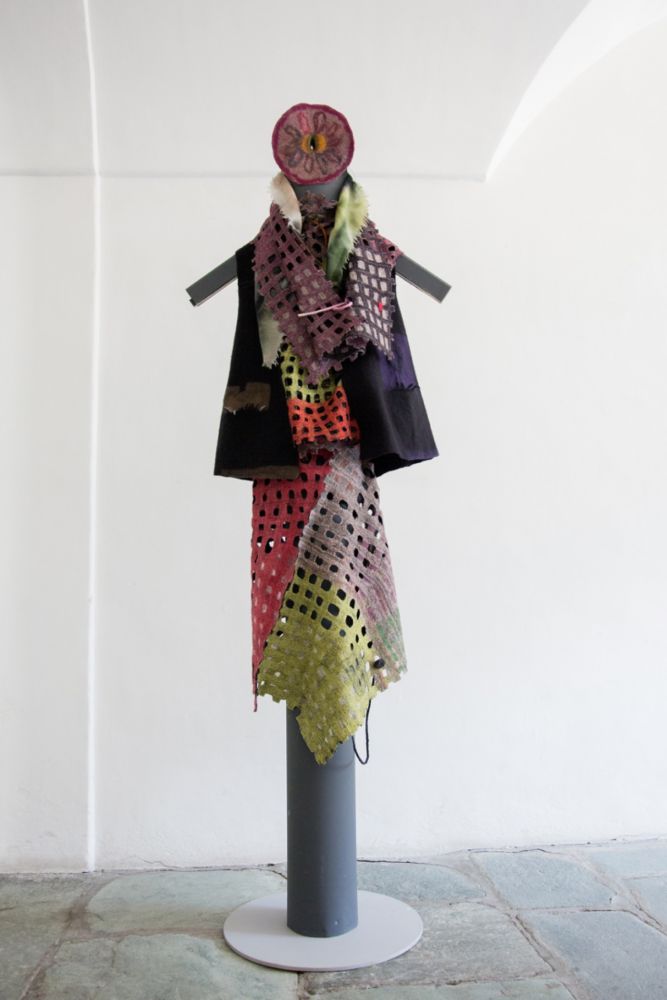
Nest Ensemble, art-object "Slice Series: apple, Jorie Johnson, 2013-18
Merino/silk, inkjet printed wool, rayon ribbon
Migratory birds interlock fiber and twig for their nest construction, like nomads construct their yurts. For the Contemporary (No)Mad traveler who is working by day and needs options in her wardrobe (such as a reversible garment) providing bright by day, and elegant by night. Seamlessly constructed using a fine wool/silk blend from a Swiss producer.
-
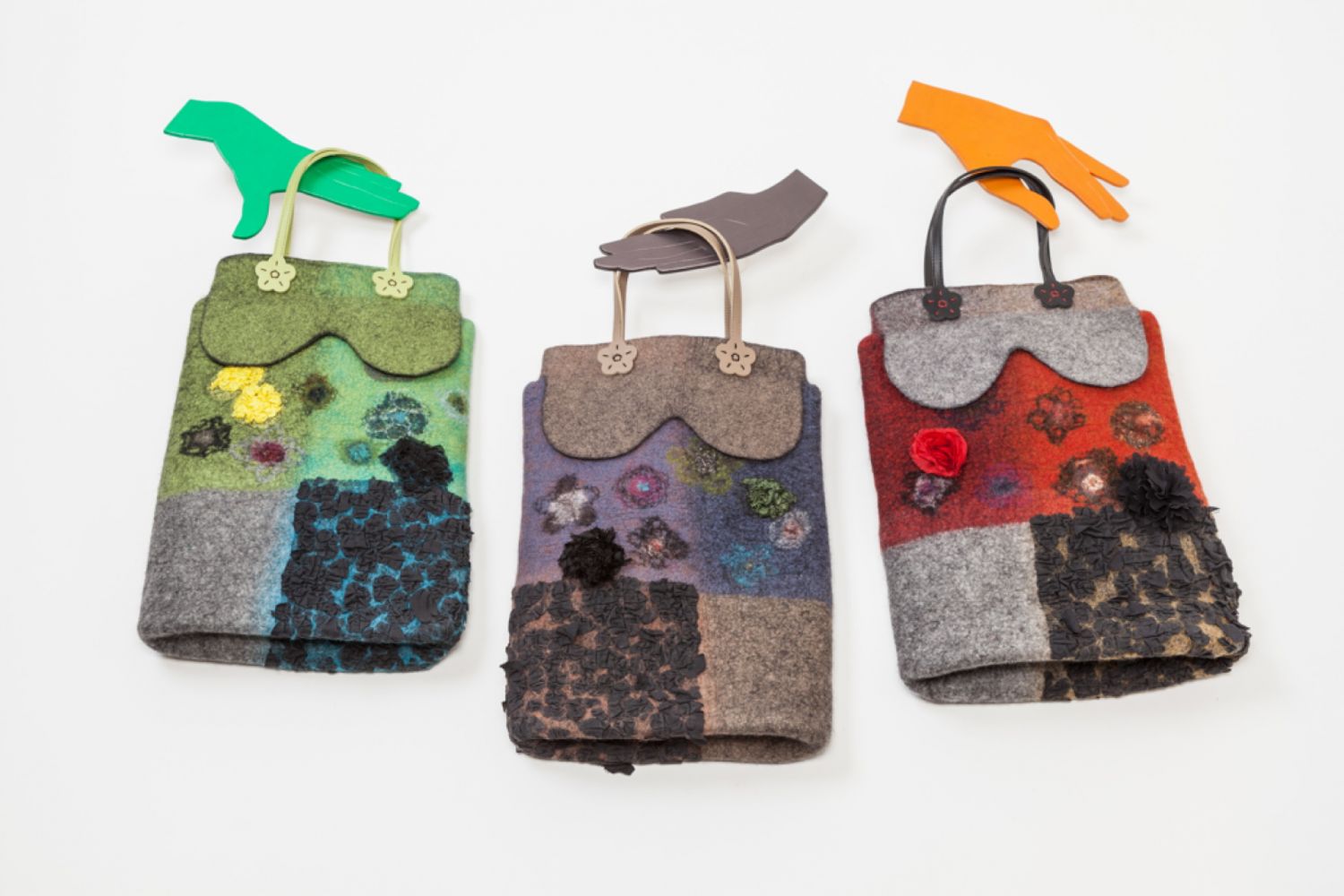
WILD Flower Totes, Jorie Johnson, 2018 - Photo: Sergio Leymarie
Merino and crossbred wool, yarns, polyester flowers, cotton/polyester mesh fabric, faux leather handles
The departure ticket for any series of work is interesting, just ask the artist! Here, the long ago purchased tote bag handles begged to be put to good folly and be sent along to Switzerland.
Felt-making offers surface design play with a cross selection of materials, showing the absorption capability of the shrinking wool matrix in action, by the time the bag fabric is completed.
-

Starbucks’ Barista Smock (with Starbucks’ cup & straw - not on photo), Jorie Johnson, 2013
Merino wool, Silk fabrics, Plastic Starbucks’ cup with straw
At the time of manufacture there were twenty Starbucks in Kyoto and and as many in Denver, Colorado. What social image would be recognizable if lost but then dug up after 100 years?
-
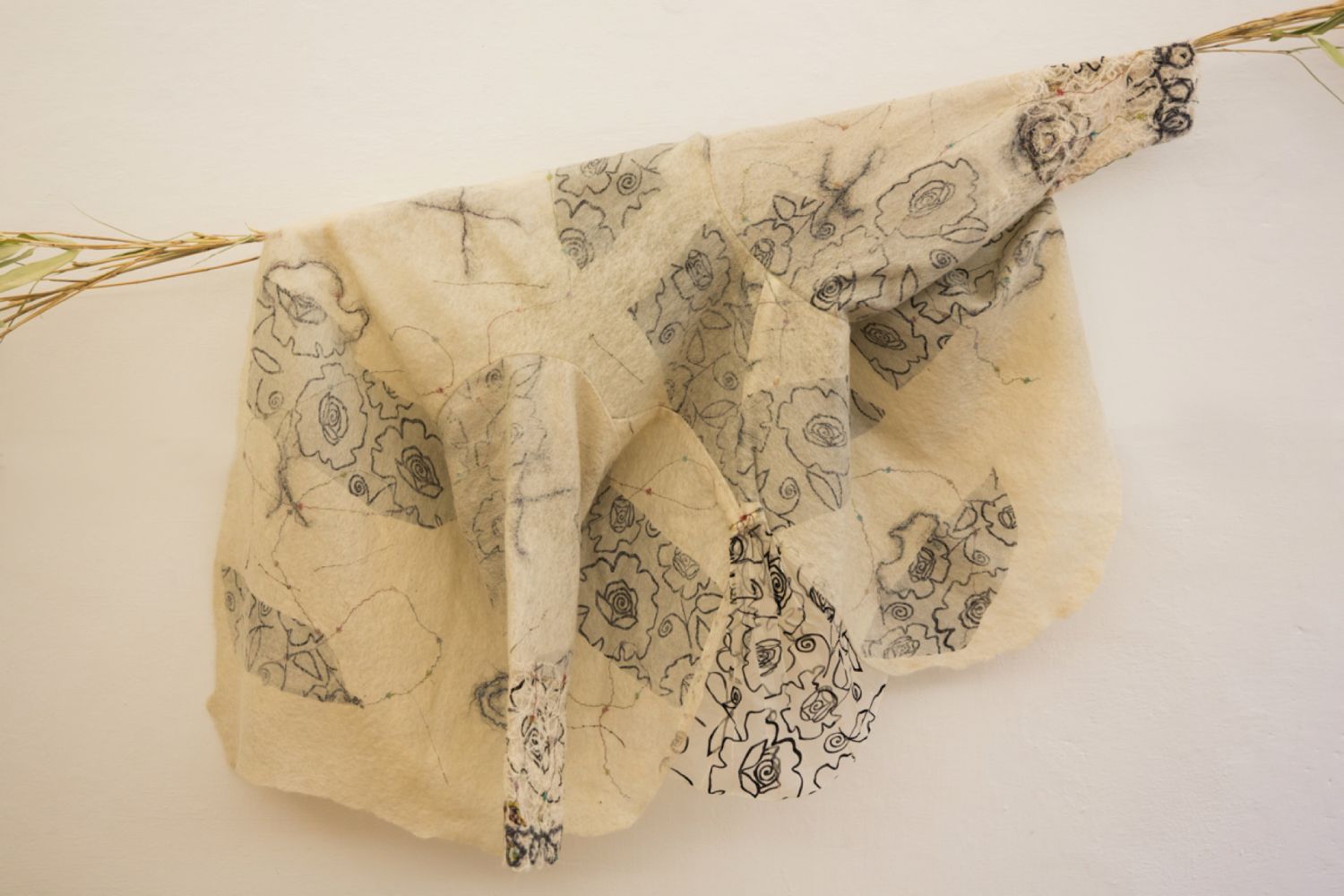
Confetti Jacket, Jorie Johnson, 1998
Swiss Walliser wool, rayon flocking on silk organza, novelty yarns, peacock feathers, felting
Like the lightly falling confetti at a wedding, using this very special Swiss Walliser wool allows for a fine, airy lace felt, to which, no other wool in the world can compare. My passion is textile design and I am using Sumi ink on silk for its’ unique capabilities as a natural pigment that compliments the silk and wool.
-
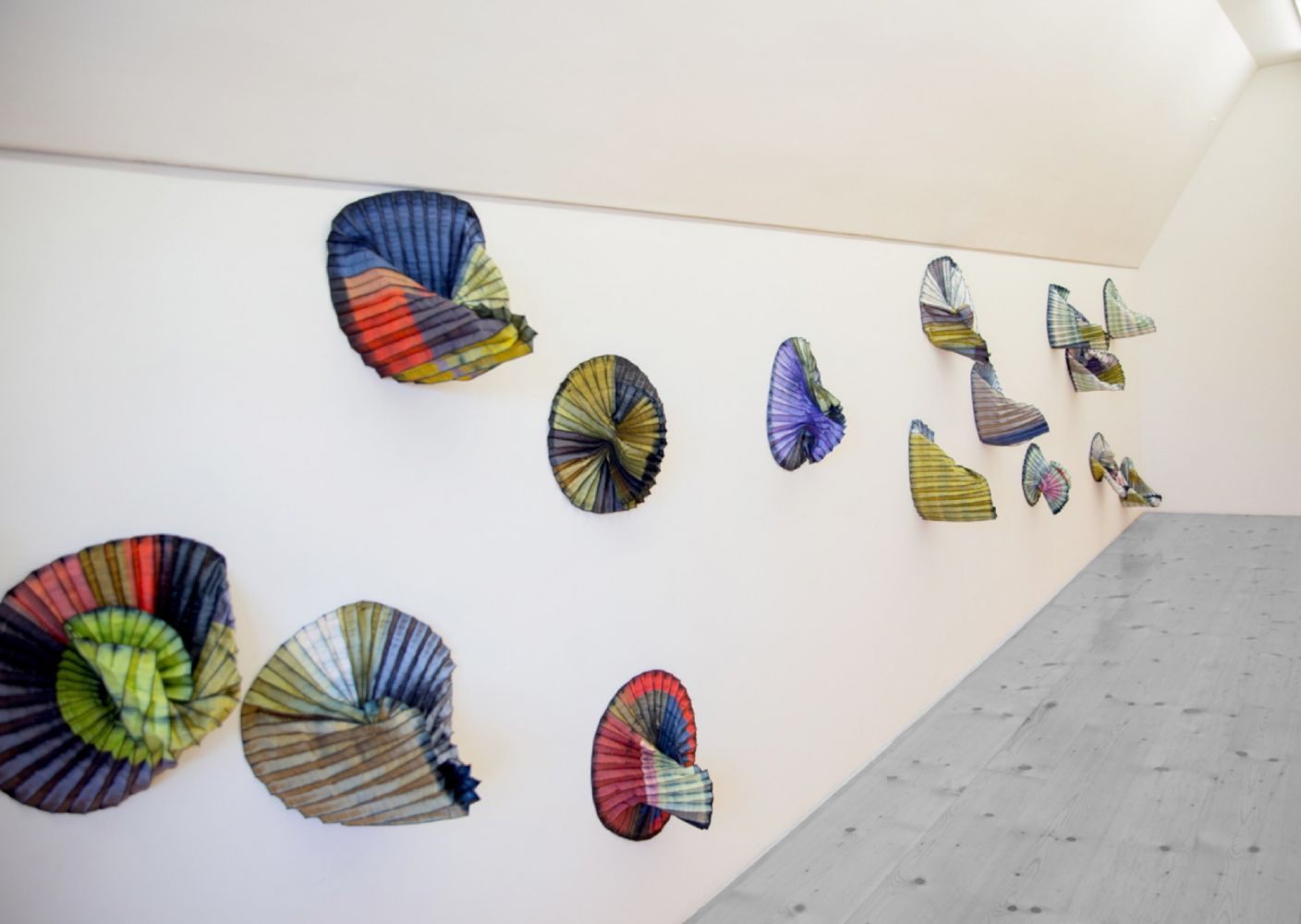
Unfolding Project: Accordion BonBons, Marie Jaeger, 2018
Installation of Neck Wraps and Ponchos, silk, pieced, pleated, dyed, stitched
These multi-dimensional silk wearables are created by reconfiguring post-production textile remnants. The Accordion BonBon neck wraps and ponchos are reversible, circular pleated columns that transform into soft sculptural collars when draped on a body.
-
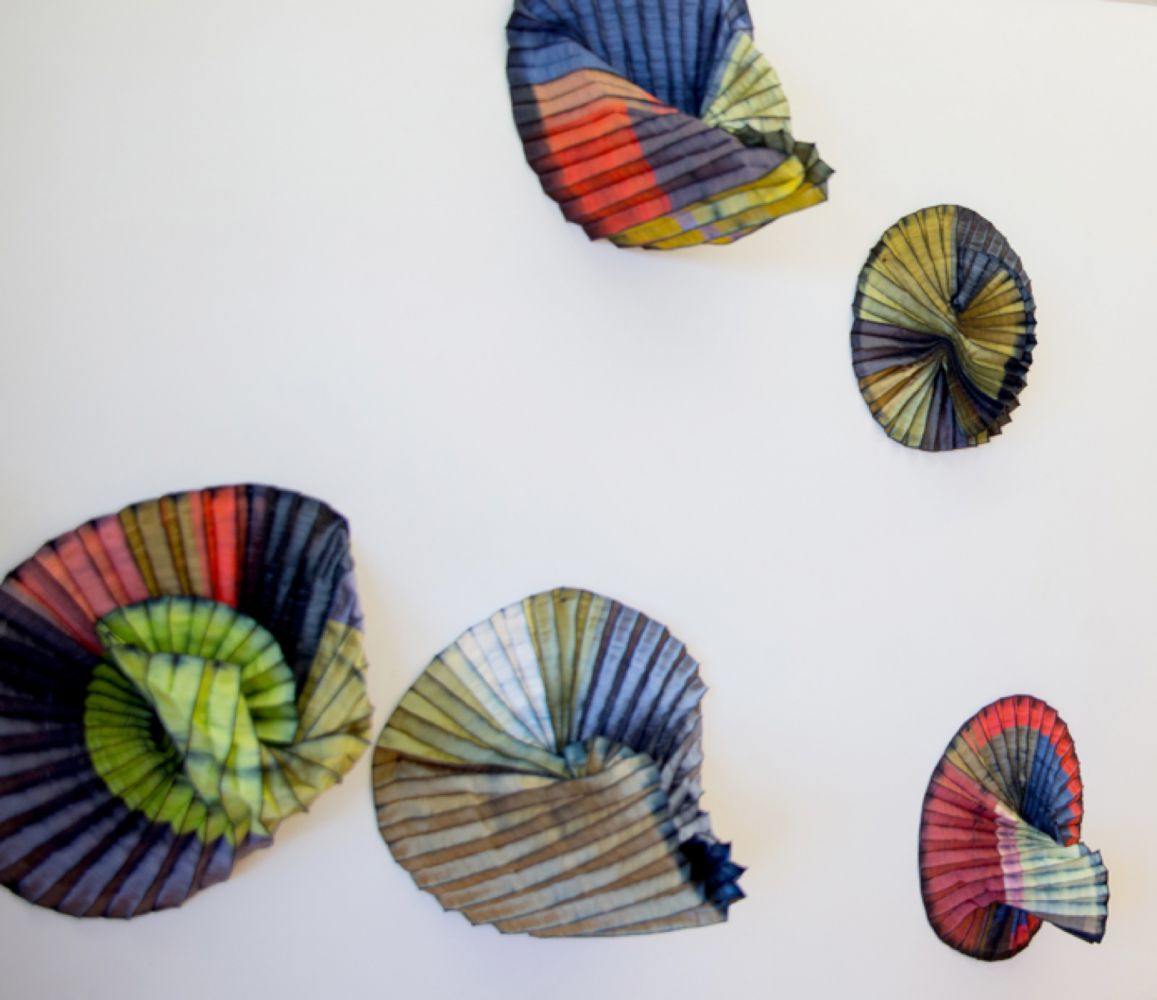
Unfolding Project: Accordion BonBons, Marie Jaeger, 2018
-

Unfolding Project: Accordion BonBon, Marie Jaeger, 2018
-
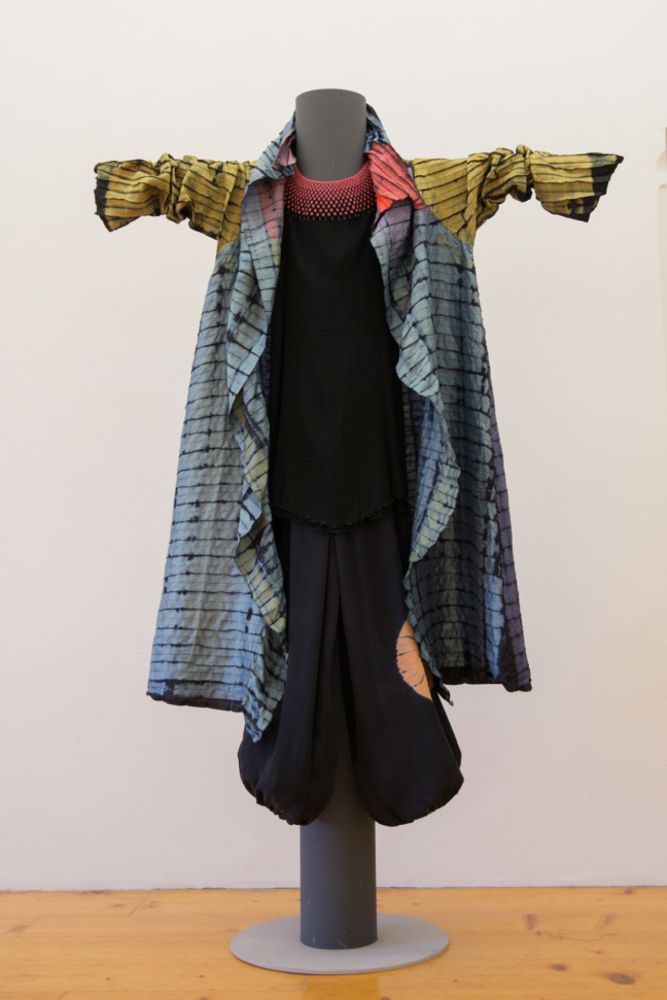
Accordion Pleated Duster (ensemble): Blue+Coral+Charcoal, Marie Jaeger, 2016
Silk, pieced, stiched, dyed, pleated
Five-colored pleated duster with black tunic, Shibori circle pant, velvet belt, beaded necklace
The Accordion Dresses, Jackets and Dusters are voluminous, oversized silhouettes that are constructed, then pleated, dyed and edge-stitched, giving the garments wide shapes and forms that are unexpectedly diaphanous and lightweight.
-
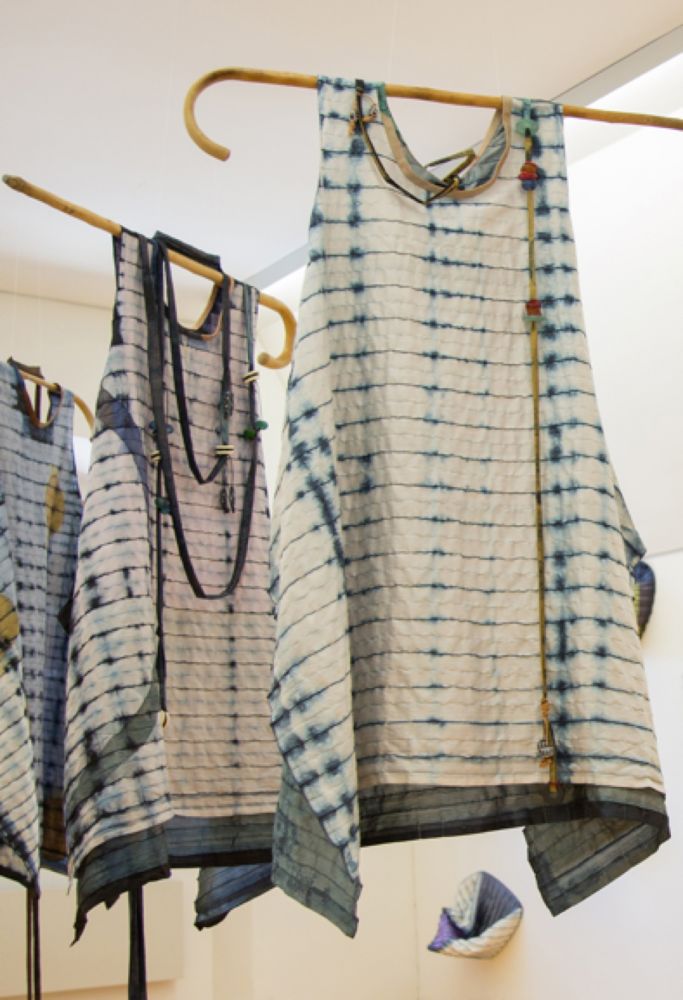
Accordion Trapezoid Dresses, Marie Jaeger, 2018
Pieced, pleated, dyed, stitched
-
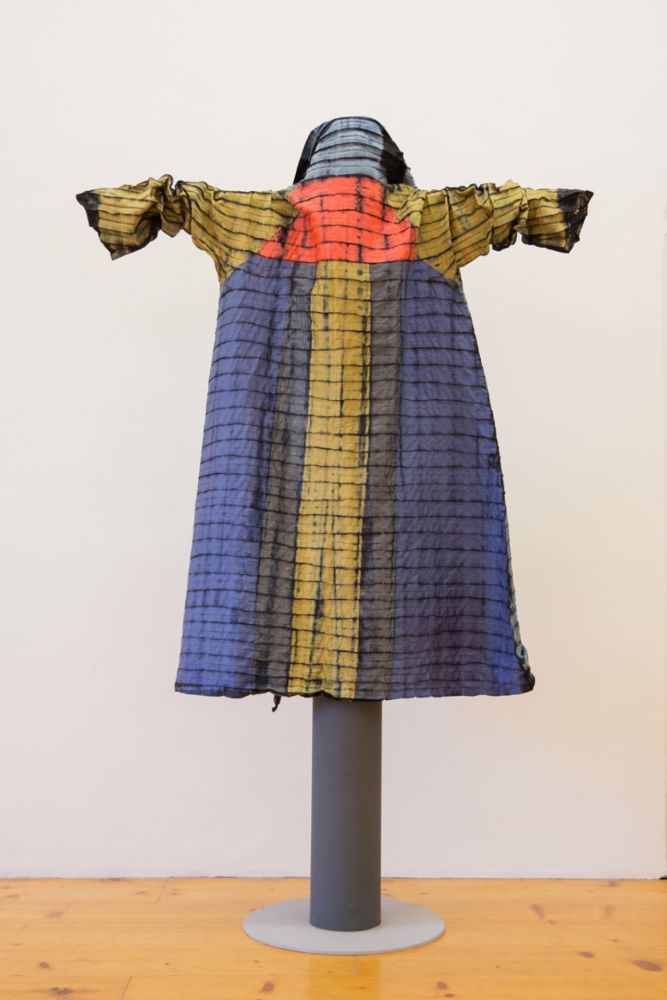
Accordion Pleated Duster (ensemble, back-side): Blue+Coral+Charcoal, Marie Jaeger, 2016
-

Lady Liberty, Mascha Mioni, 2013
silk, painted, crinkled
Human quest for liberty leads everywhere to revolution, war and destruction.
War and destruction are symbolized by the intense reds of blood and fire, death by the dark black of this demanding dress.
The strict appearance of the textile sculpture indicates that the guardians of freedom will impose new restrictions reducing the liberty of humanity.
-
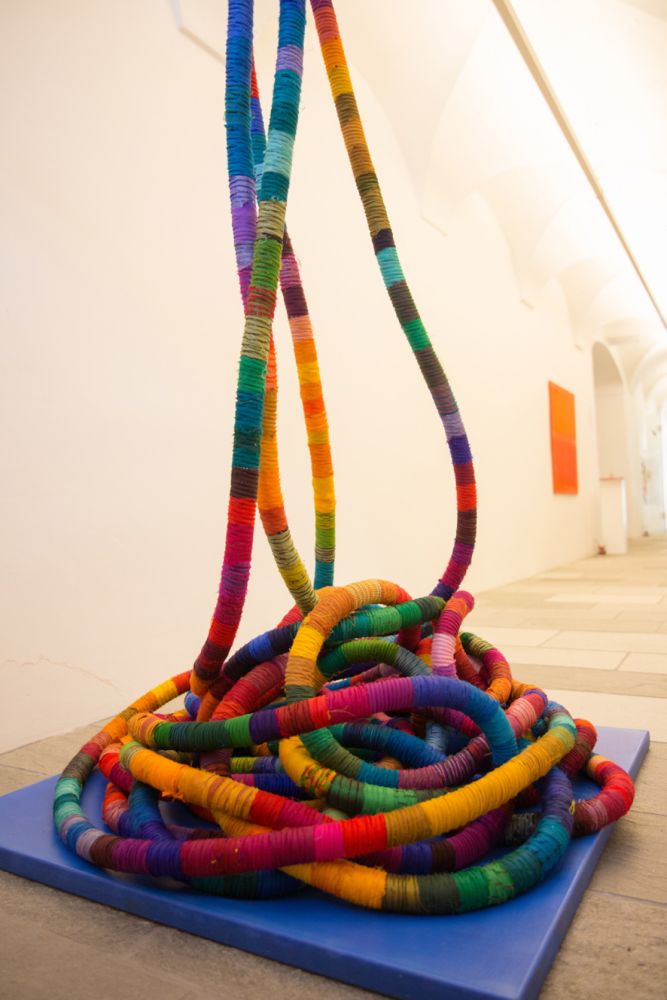
Brainware, Mascha Mioni, 2015
Oil and pigment on canvas, 36 m vacuum cleaner tube, wrapped with 600 m of used sari-silk
When Verena in red
lost
her wits
And the Hindu-women
cut their saris
to stripesThe dust did not
anymore
fly through the pipe
Then
the blue of the sky
lay on the floor
And hell
came over us.
-

Remember Arimatsu, Mascha Mioni, 2008
Cotton, dyed, Kumo Shibori
-
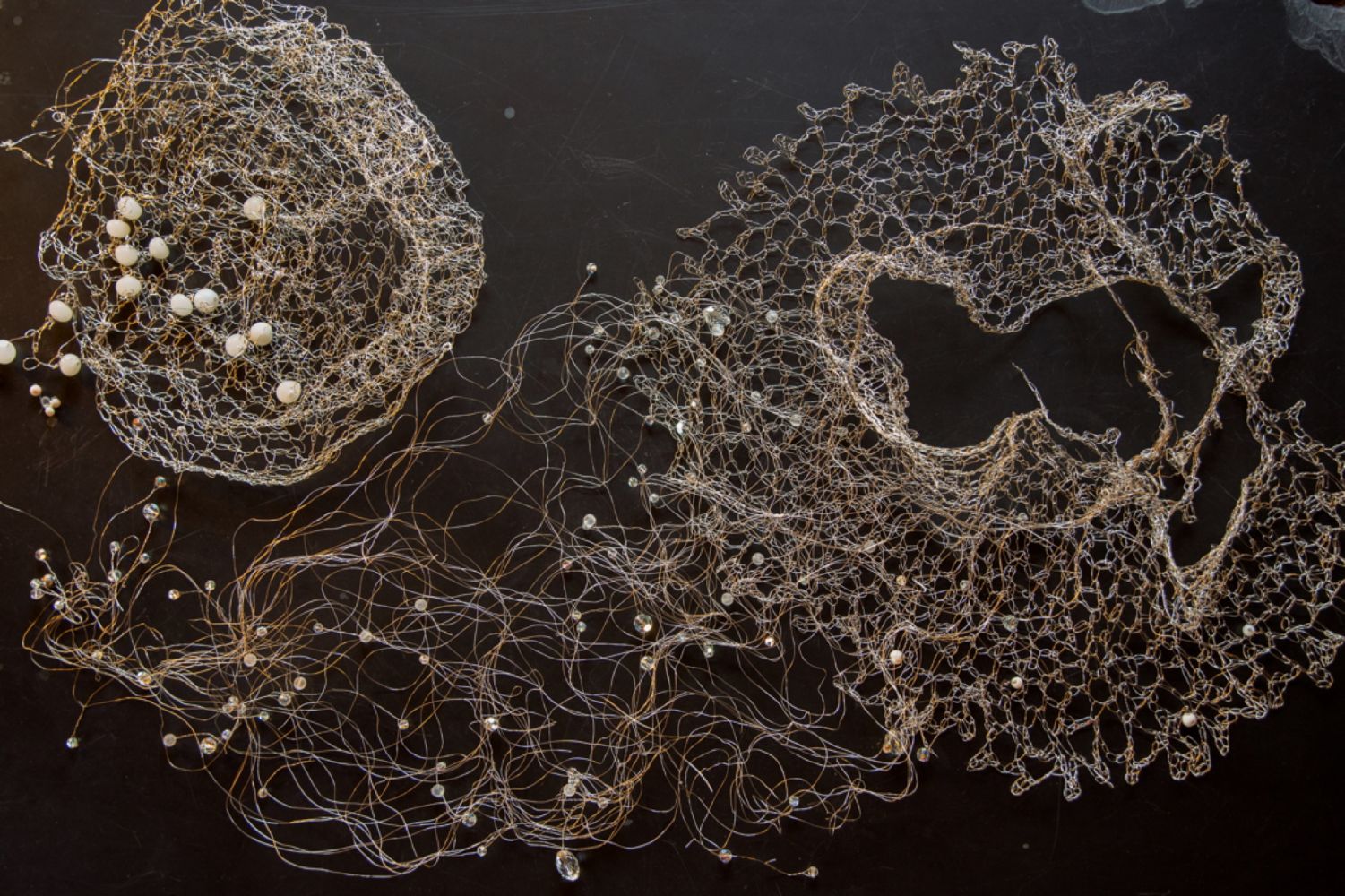
Trinkets to Insieme, Mascha Mioni, 2015
Silver wire, crochetted, beads
-
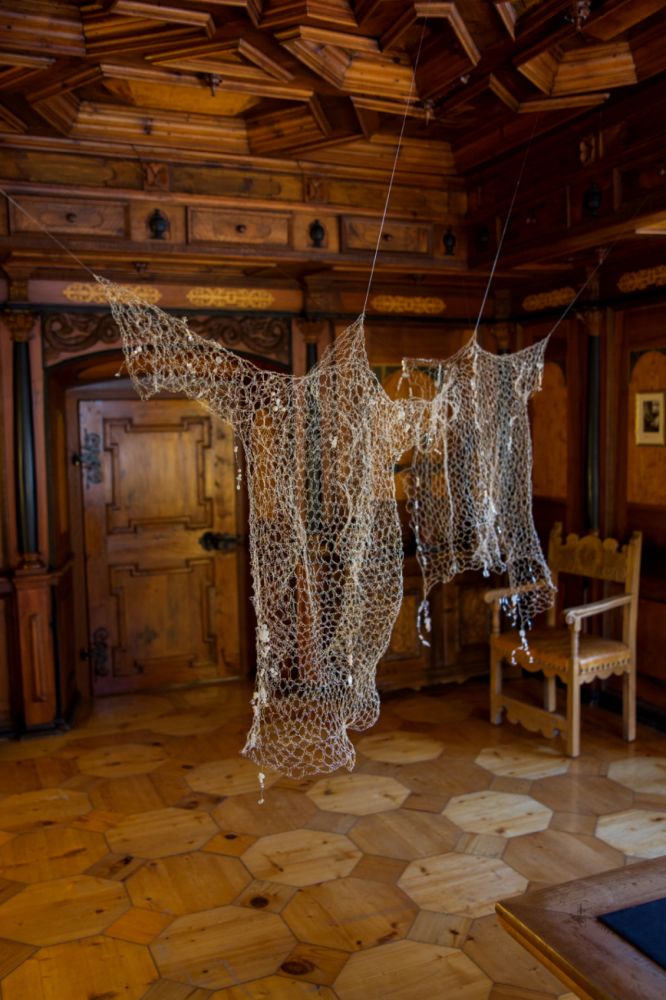
Insieme, Mascha Mioni, 2015
Wire sculpture, silver wire, crochetted
More cf. >Art >Installations
2018 Exhibition Museum Sursilvan Trun
From July 28 to Sept. 8, 2018 Mascha Mioni and Heiner Graafhuis curated the textile art exhibition "Shades of Memory" at the venerable old Museum Sursilvan in Trun/Grisons.
The five world-reknown artists:
Yoshiko Iwamoto Wada, Berkeley/USA
Ana Lisa Hedstrom, San Francisco/USA
Jorie Johnson, Tokyo/Japan
Mary Jaeger, New York/USA
Mascha Mioni, Disla & Meggen/Switzerland
show their fine textile creations.
The Trunser photographer Alexandra Coray-Guldimann has documented the exhibition.
From July 28 to Sept. 8, 2018 Mascha Mioni and Heiner Graafhuis curated the textile art exhibition "Shades of Memory" at the venerable old Museum Sursilvan in Trun/Grisons.
The five world-reknown artists:
Yoshiko Iwamoto Wada, Berkeley/USA
Ana Lisa Hedstrom, San Francisco/USA
Jorie Johnson, Tokyo/Japan
Mary Jaeger, New York/USA
Mascha Mioni, Disla & Meggen/Switzerland
show their fine textile creations.
The Trunser photographer Alexandra Coray-Guldimann has documented the exhibition.
go to post
-
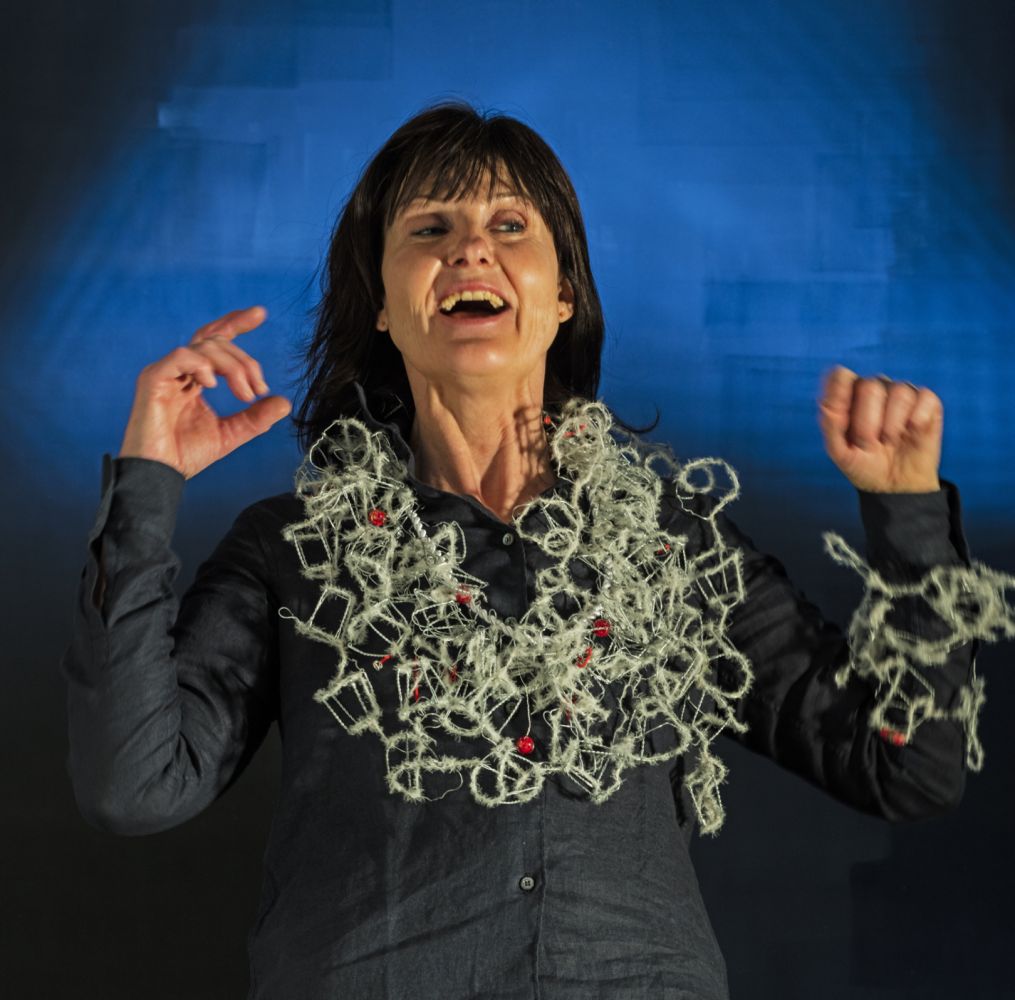
Champagne cork wire fastenings wrapped in mohair wool, glass pearls, electrical wire, silver wire, on a silk cord
Model Martina R.
-

Art to Wear Jewelry
painted silk bias-tape over metal wire,
pearl opening Colleen Toland
Handbag
painted silk, knitted
Turban
painted silk, crinkled, drawn motiveModel Caro K.
-
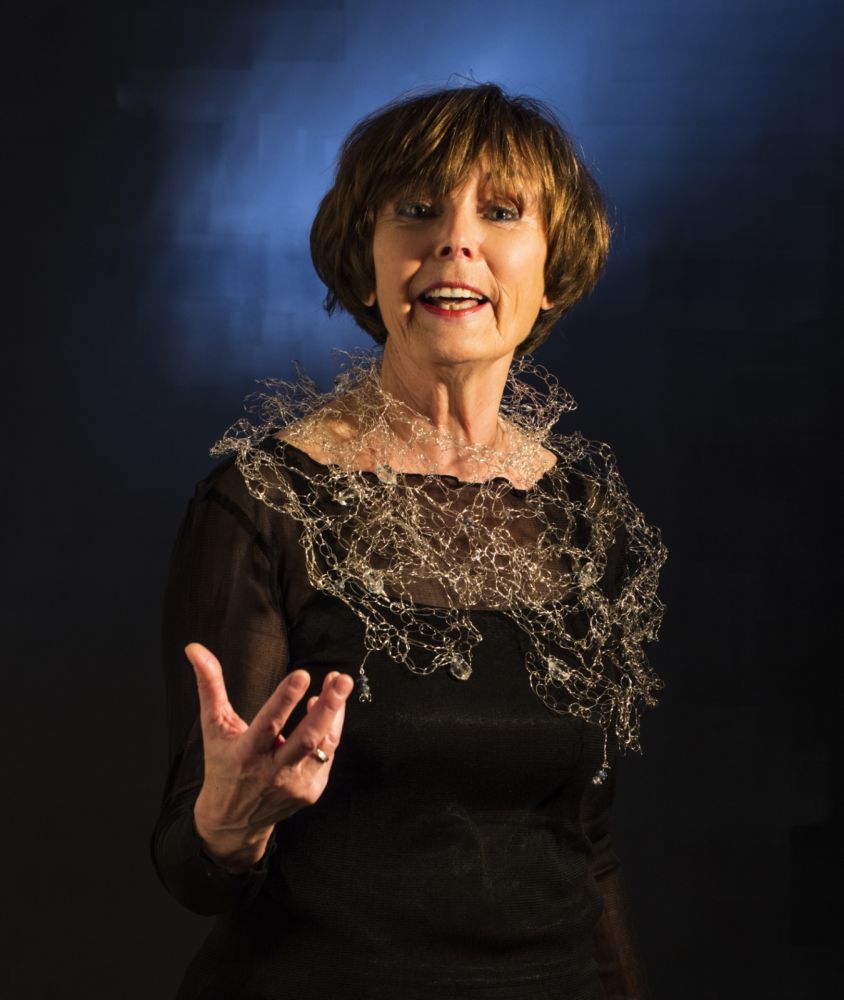
Silver wire, crocheted, glass jewelry, painted glass pearls
Model Ruth S.
-

Worn sari silk-strips twined with copper wire,
champagne cork wire fastenings
Hat from Usbekistan with antique hatpinModel Sylvie A.
-

Gold wire, crocheted, bamboo-, glass- and wood-links
Model Annemarie R.
-

Felted wool, champagne cork wire fastenings, shirr, bakelite links
Model Käthy B.
-
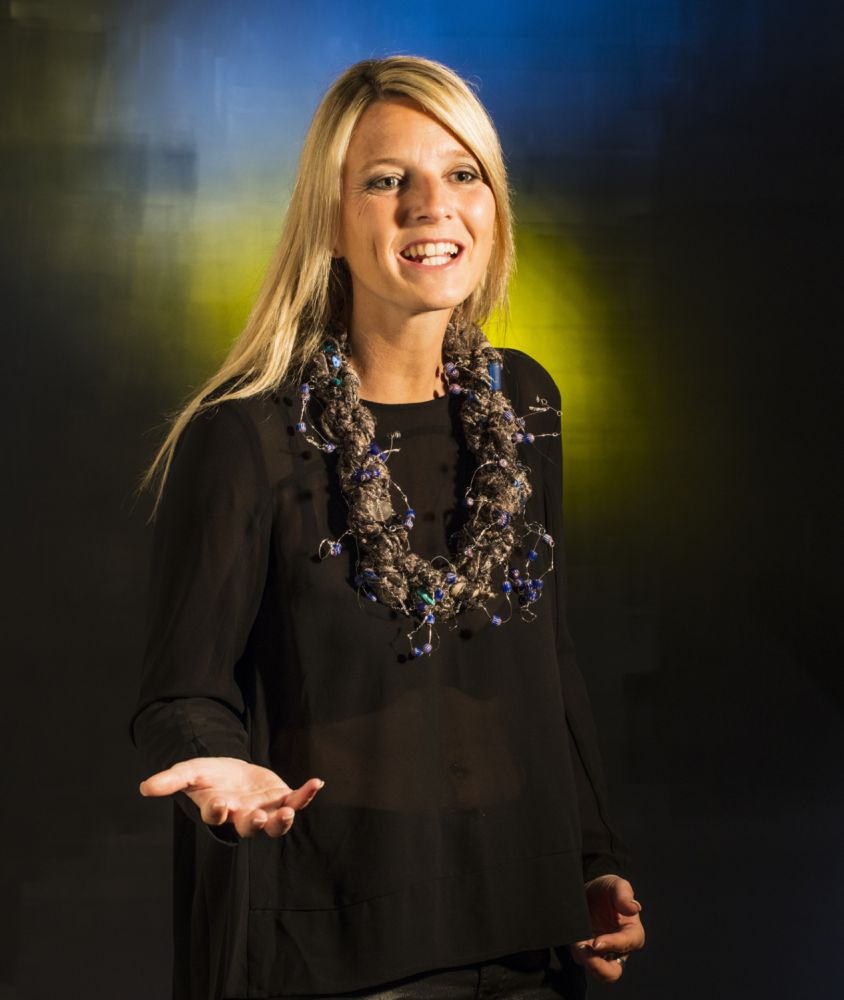
Silver-brocade, twisted, joined with silver wire, glass pearls and chevron beads
Model Patricia A.
-
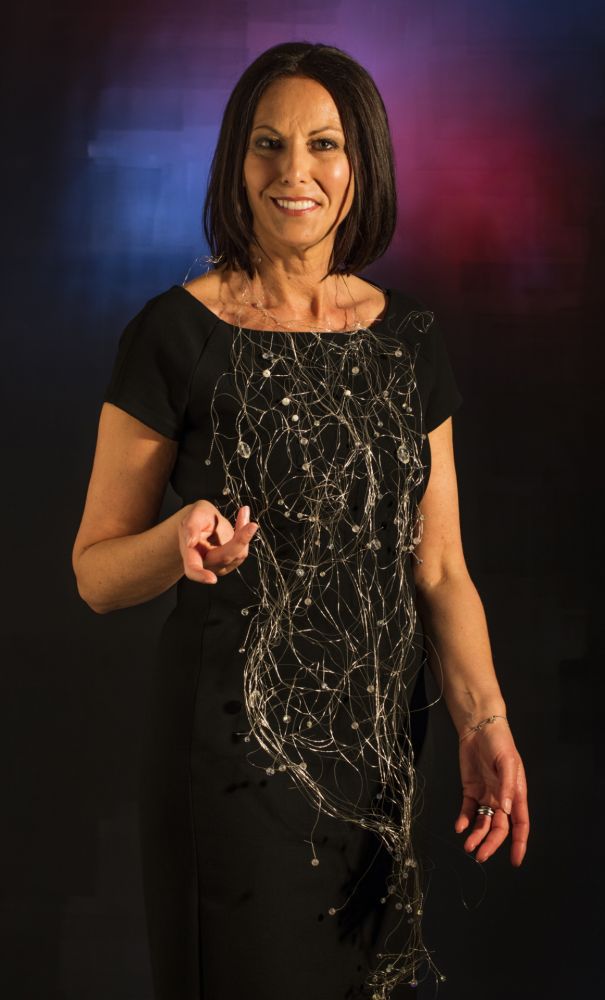
Silver wire, braided, knotted, crystal glass
Model Gisela K.
-
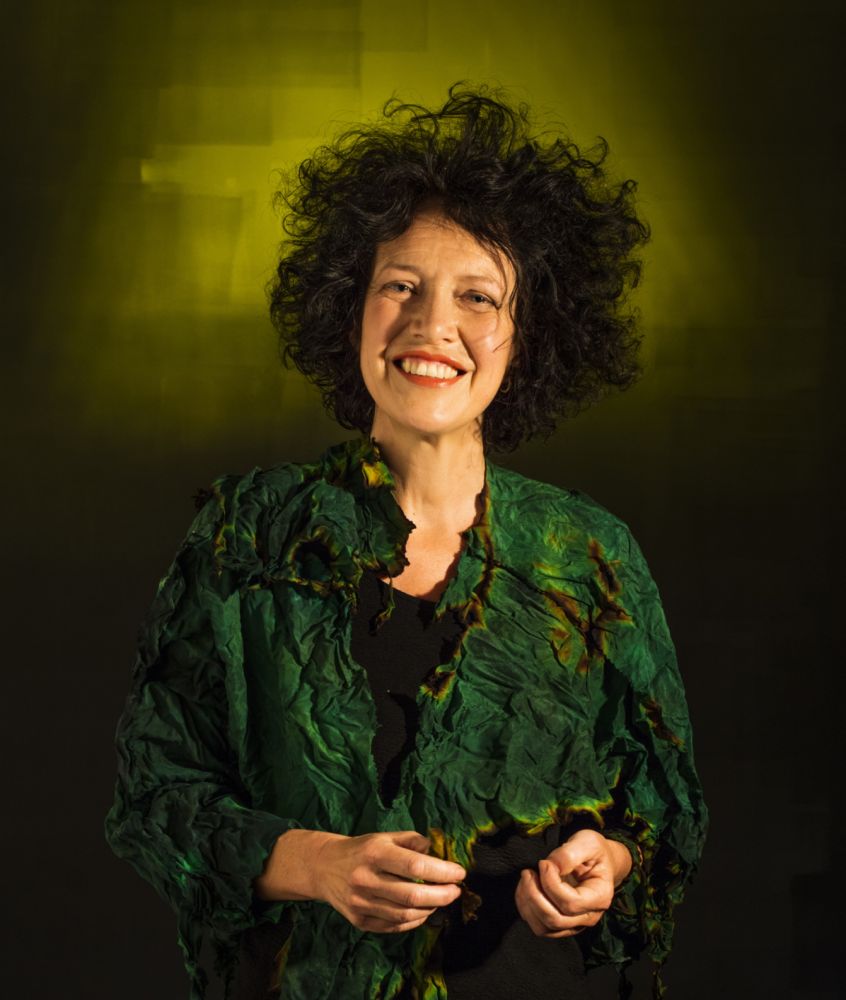
Painted silk, crinkled, scorched
Model Andrea S.
-

Painted wild silk, joined with silver and copper wire, Chinese glass pearls, agate beads
Model Almi S.
-
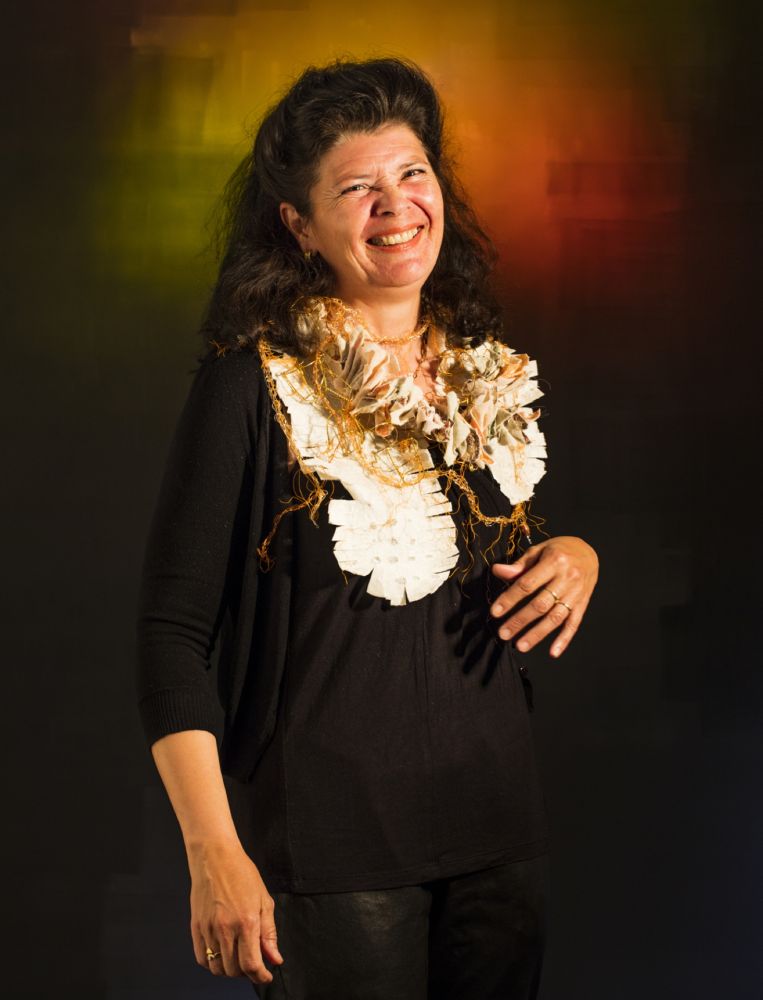
Fleece pressed on polyester jersey, dyed, champagne cork wire fastenings, copper and silver wire crocheted with silk thread, chevron beads
Model Fränzi M.
-
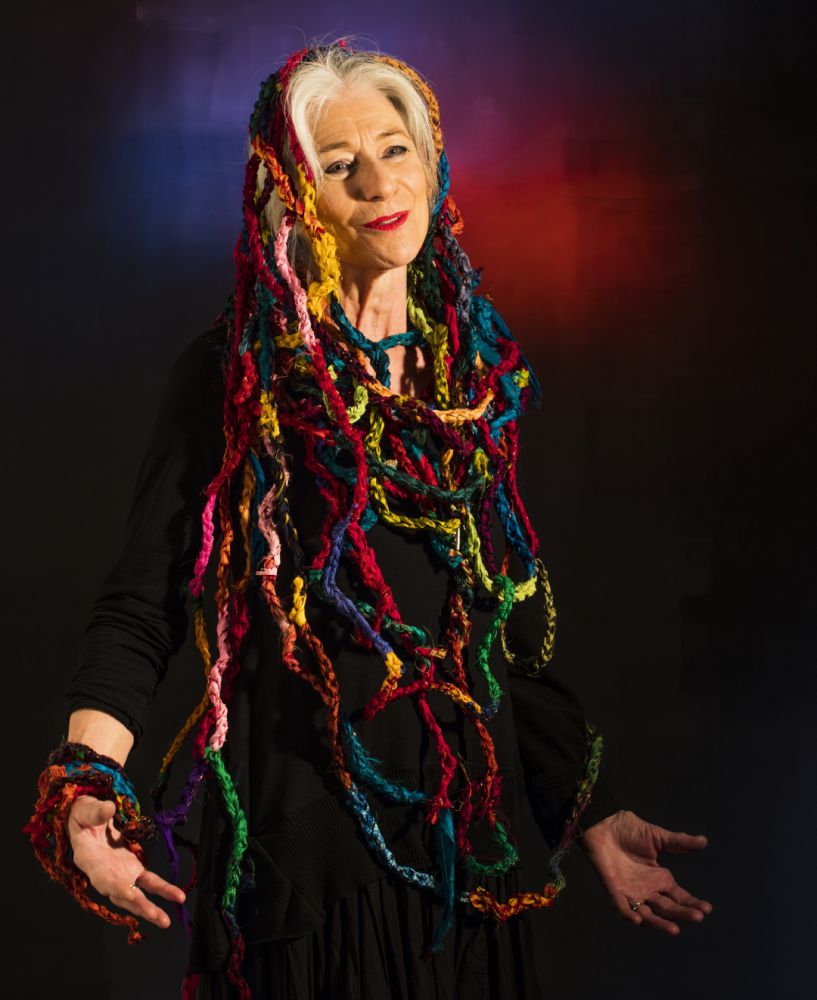
Used silk saris torn to strips, crocheted with copper wire
Model Ruth G.
-

Felted and painted wool, painted African bones
Model Martina R.
-
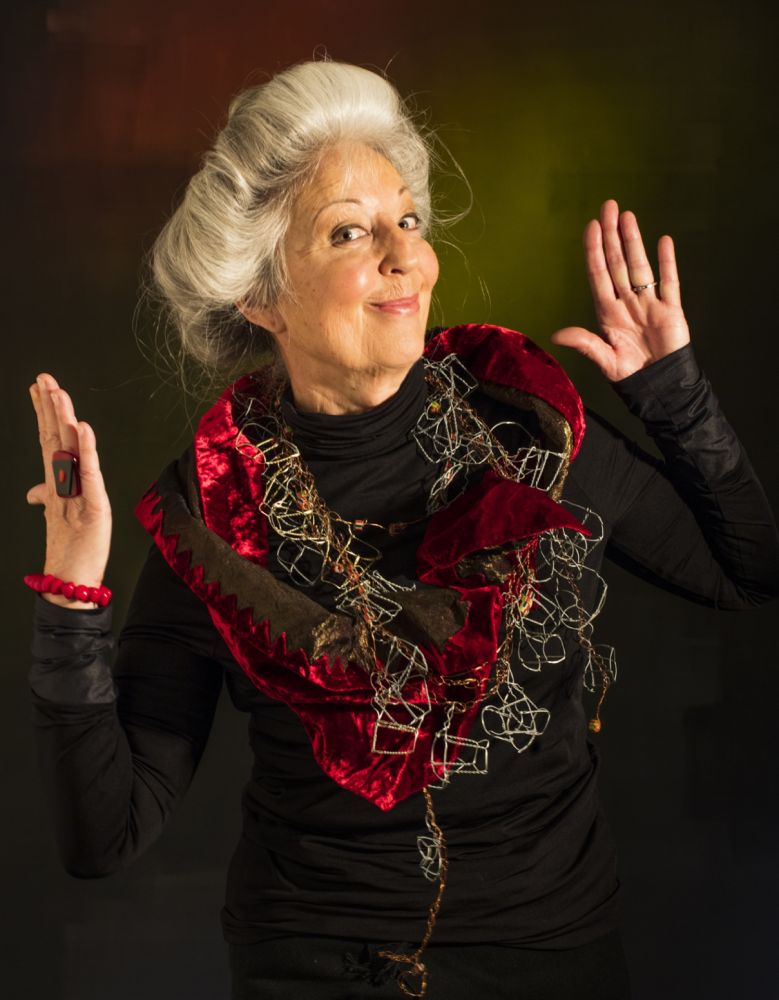
Metal fabric, glued together with silk velvet, champagne cork wire fastenings, chevron beads, crocheted with copper wire
Model Mascha M.
-
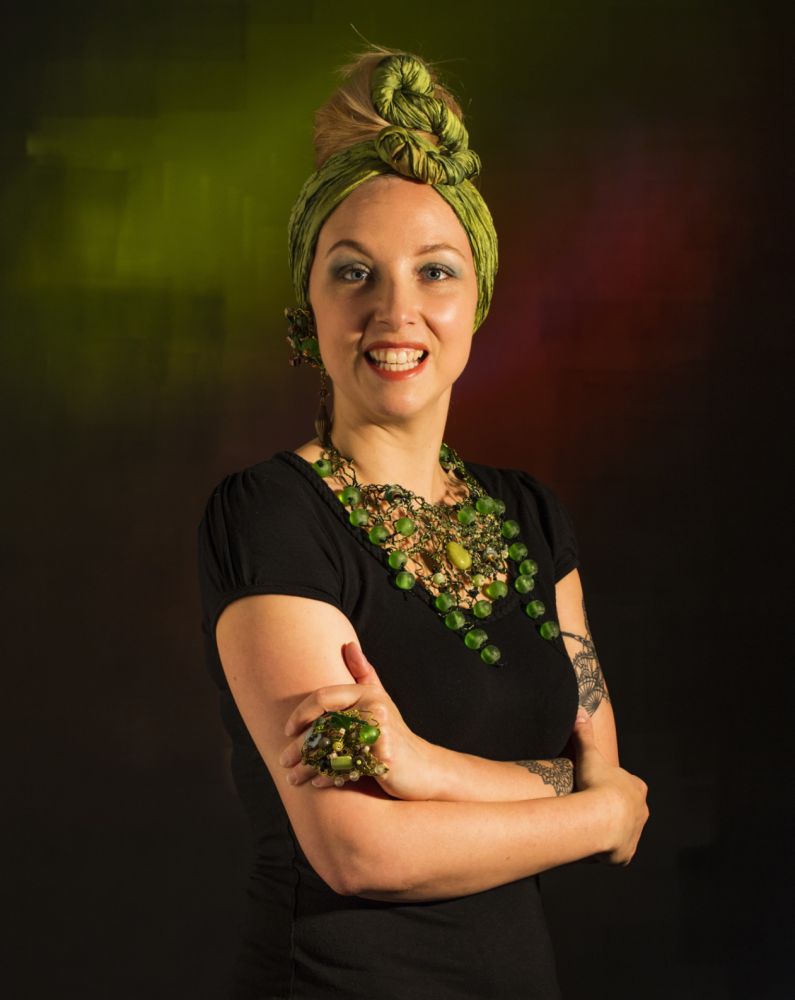
Jewelry
champagne cork wire fastenings, glass pearls, chevron beads
Turban
painted silk, crinkledModel Anja J.
-
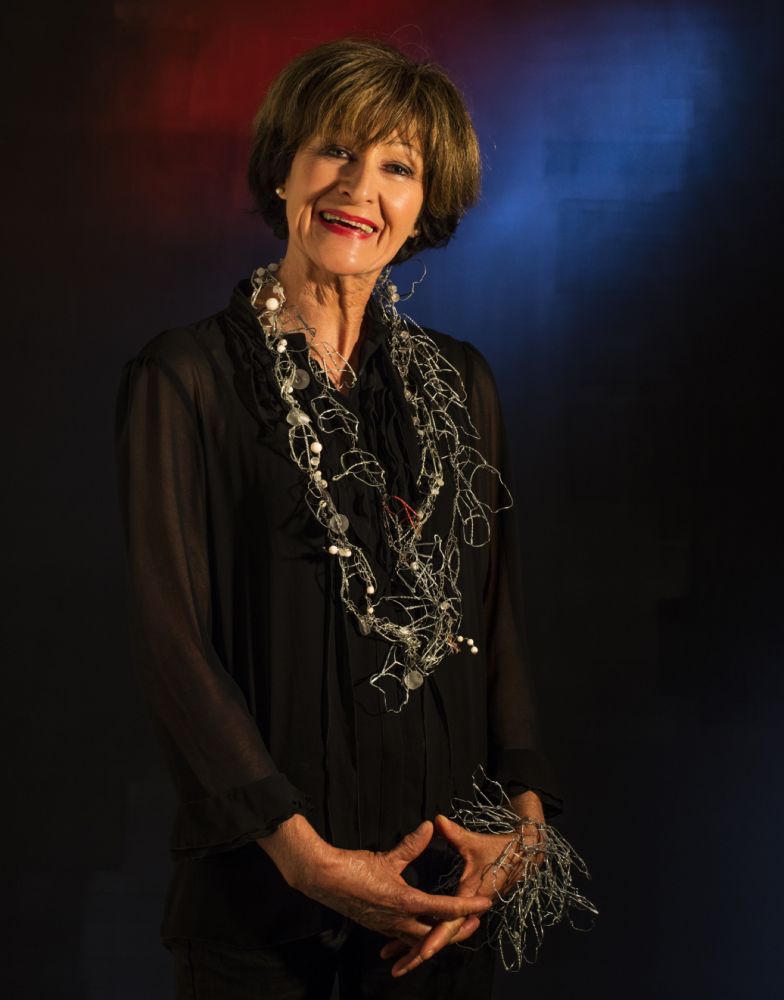
Champagne cork wire fastenings, glass pearls, coral beads, crocheted with metal wire
Model Margrith E.
-
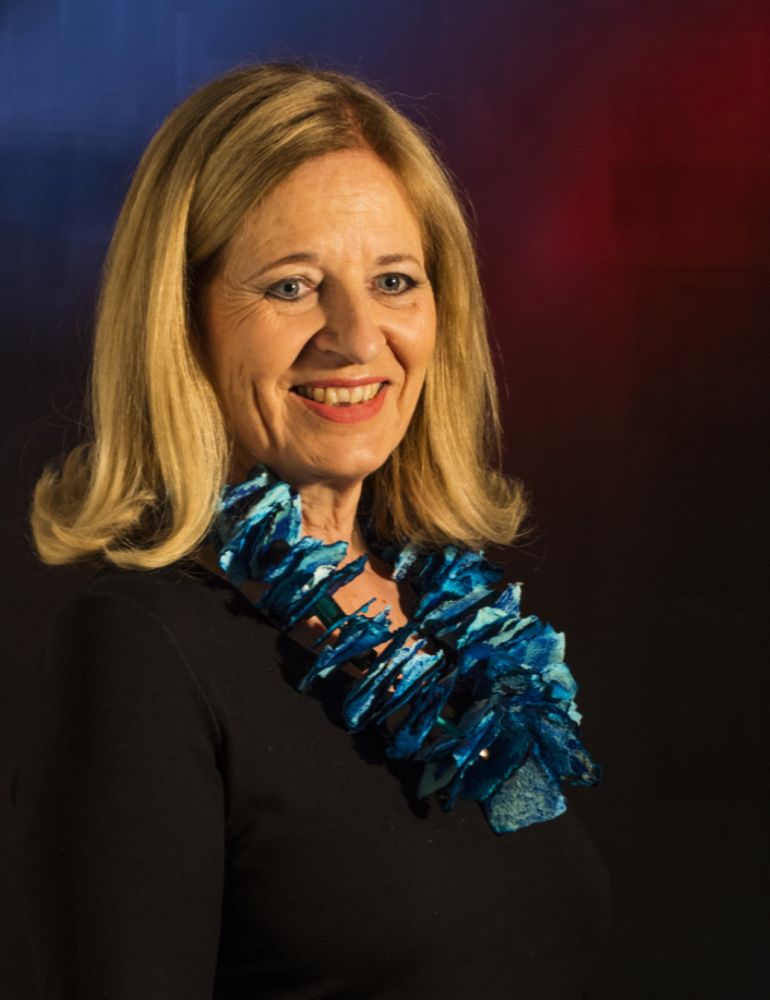
Hand-made paper, painted, glass and silver pearls on leather strap
Model Gisela G.
-
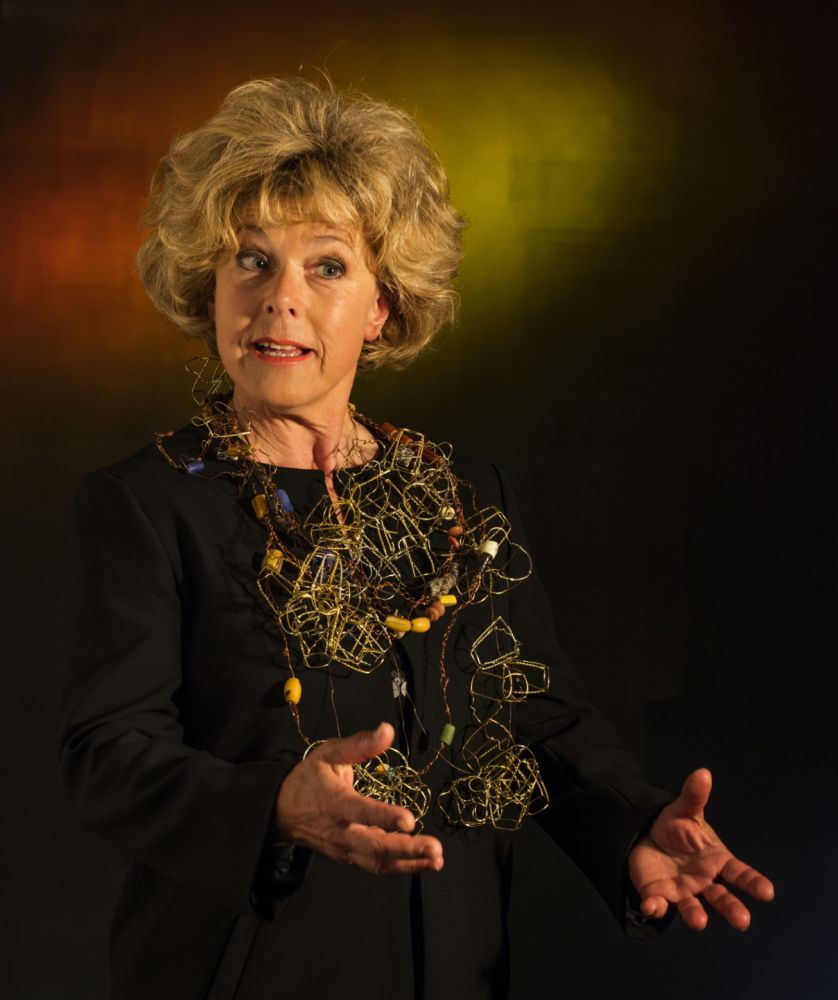
Champagne cork wire fastenings, colorful African beads, electrical wire, collier Boules, gold 750, large Tibetan jewelry, decorated with lapis lazuli, coral and turqoise, crocheted with copper wire
Model Madeleine I.
-
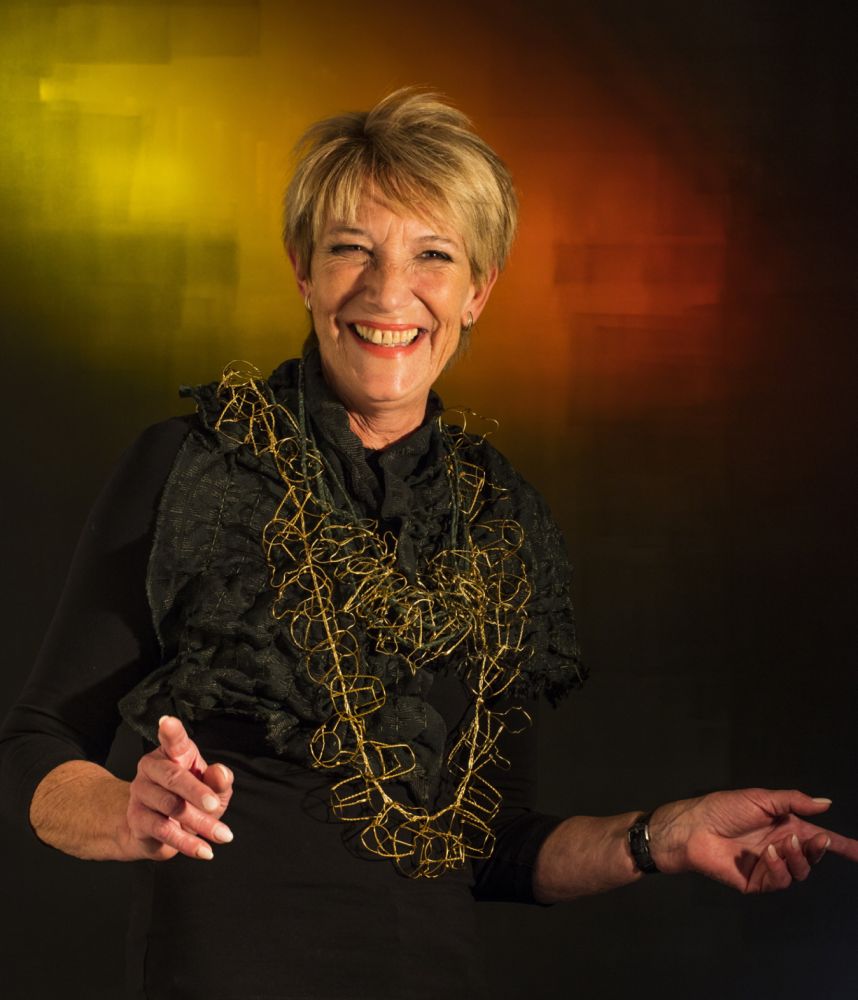
Dyed silk, contracted with silk threads, champagne cork wire fastenings connected with gold wire and braided silk- strips
Model Pia B.
-
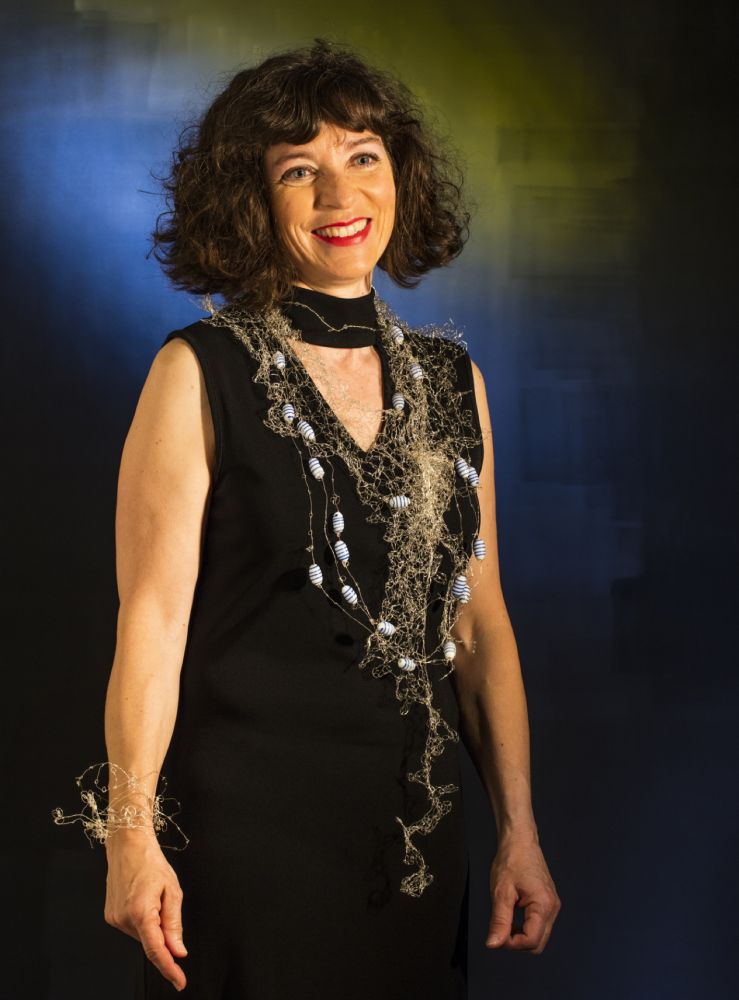
Silver wire, crocheted, Millefiori beads
Model Andrea Z.
-

Egg carton, painted, deformed, Chinese prayer-strings
Model Nicole W.
-
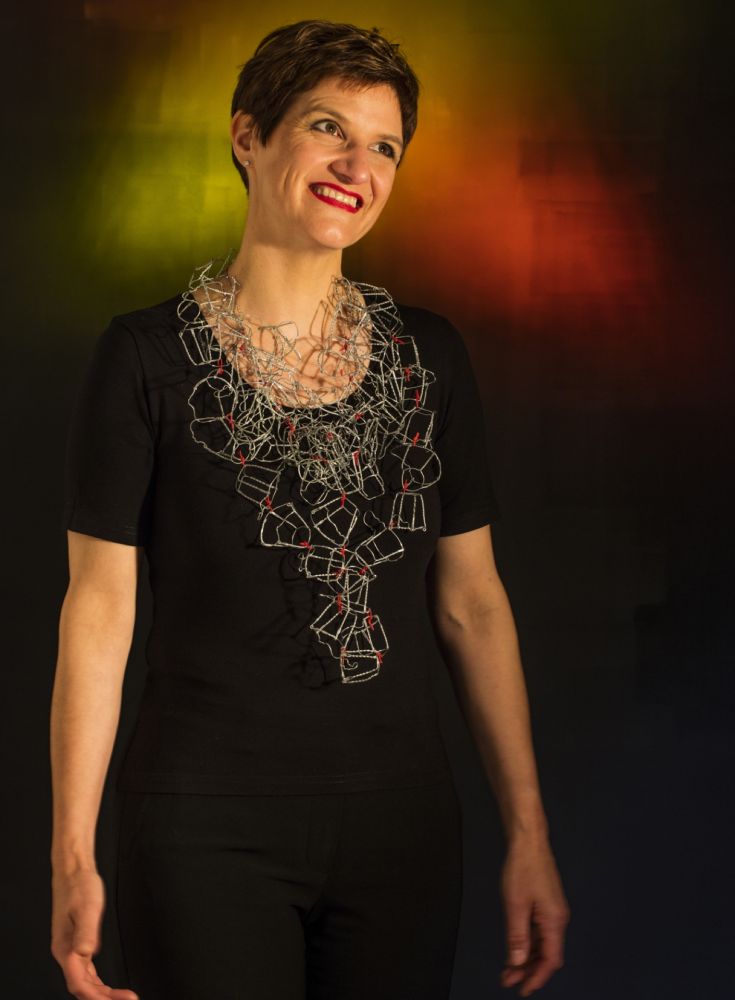
Champagne cork wire fastenings, electric wire, crocheted with metal wire
Model Pia K.
-
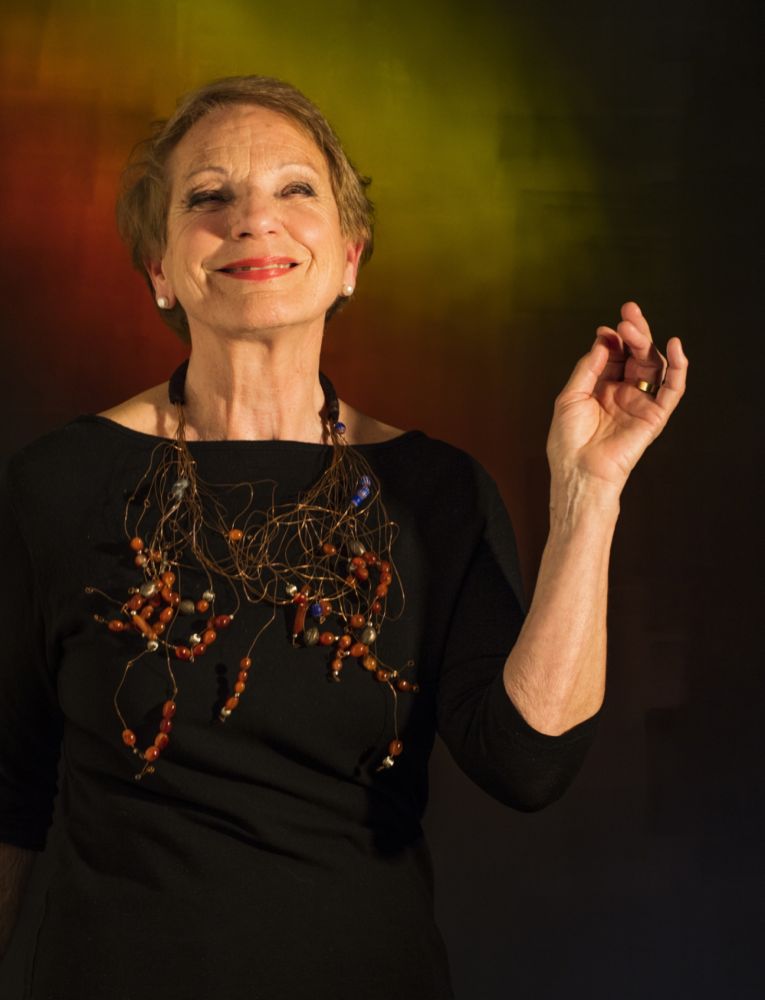
Copper wire, amber, silver pearls, chevron beads
Model Franziska D.
-
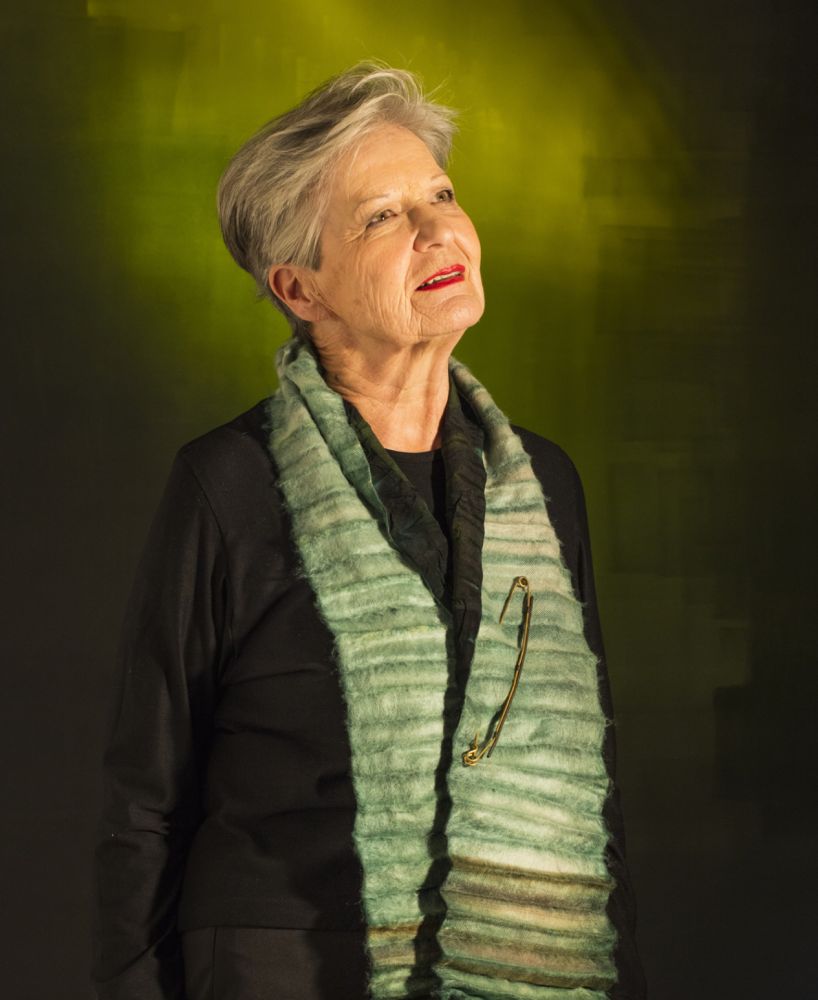
Wool, silk, painted, pleated, vintage strass brooch
Model Marie-Louise M.
2016 Art to Wear Jewelry - Book "Augenblick Mal"
Art to Wear Jewelry by Mascha Mioni
Fotos: Carlos Rieder
Styling: Chantal René
To see the jewelry, which I created as part of my Art to Wear work, worn by people like you and me, people with whom I share daily sorrow and happiness, everyday life, and - together with Carlos Rieder - capture this photographically, gave us wonderful moments together. These pictures share these moments.
The photographs are a symbiosis of faces, tanned by the experience of time, and objects that only pose artistic claims, made from textile- and waste-materials, champagne cork wire fastenings, copper wire, secondhand glass beads, silver wire.
Texts, touching the bottom of our hearts, accompany the pictures.
Art to Wear Jewelry by Mascha Mioni
Fotos: Carlos Rieder
Styling: Chantal René
To see the jewelry, which I created as part of my Art to Wear work, worn by people like you and me, people with whom I share daily sorrow and happiness, everyday life, and - together with Carlos Rieder - capture this photographically, gave us wonderful moments together. These pictures share these moments.
The photographs are a symbiosis of faces, tanned by the experience of time, and objects that only pose artistic claims, made from textile- and waste-materials, champagne cork wire fastenings, copper wire, secondhand glass beads, silver wire.
Texts, touching the bottom of our hearts, accompany the pictures.
go to post
-
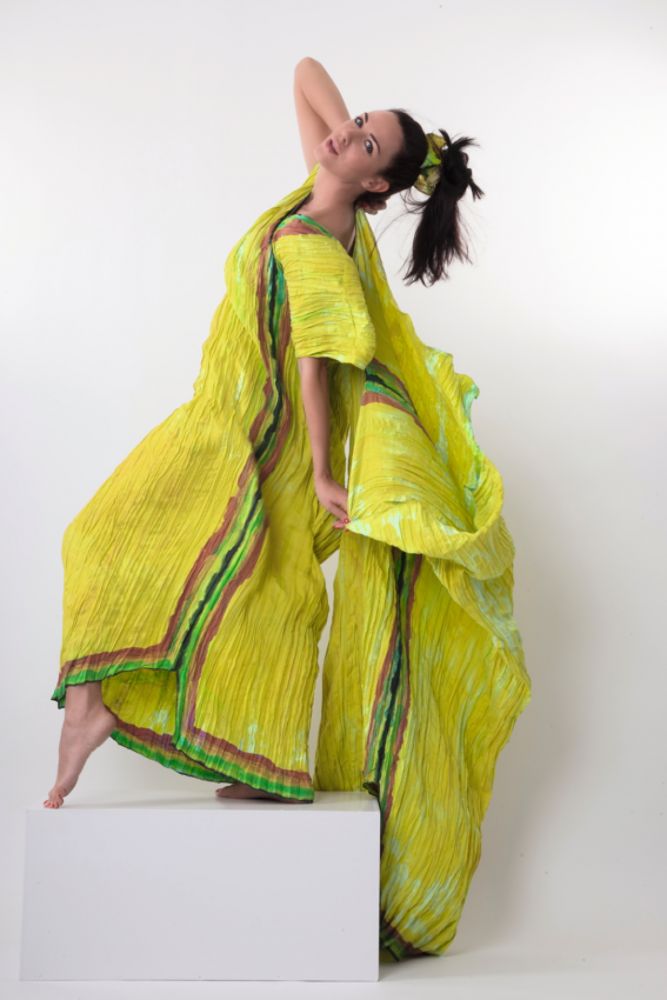
Maroc
Dress: Silk twill, painted, pleated -

Burnt Earth (2010-11)
Dress: wool, handwoven, painted, shibori
Jewelry around the neck: Metal threads from a small atelier in Kyoto, Japan
On the arms: African precious wood
Earrings by Monies: wood, painted -

Burnt Earth (2010-11)
Dress: wool, handwoven, painted, shibori
Jewelry around the neck: Metal threads from a small atelier in Kyoto, Japan
On the arms: African precious wood
Earrings by Monies: wood, painted
-
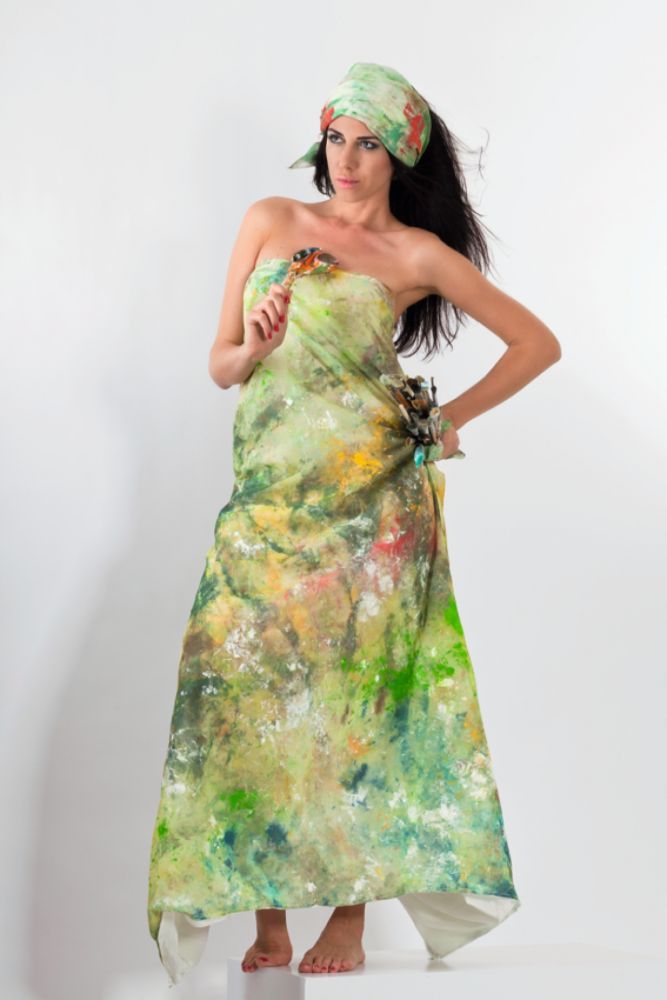
The Painters Dress (2010)
Dress: Crèpe de Chine, oil paint, lined with pongé-silk
-
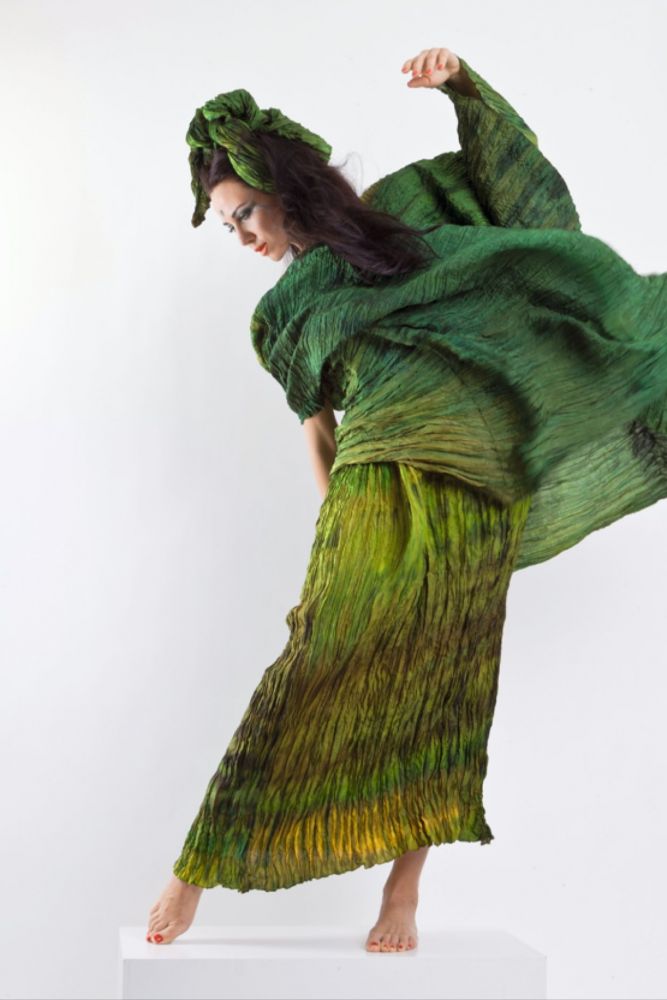
-

Triangel (2011)
Triangular dress with hood, organza, painted, crinkled
Jewelry: 2000, Sonja Wyss, Amsterdam
-

Iryna (2005)
Tube dress: SIlk jersey, painted, Shibori
-
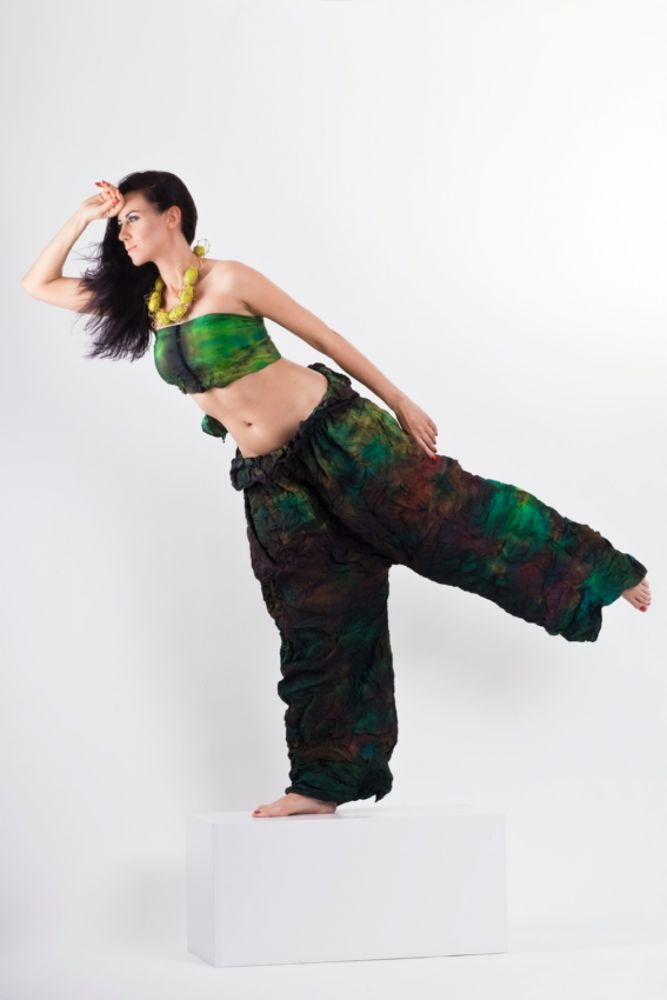
Jane looking for Tarzan (2005)
Pants and top: tie-silk, painted, crinkled
Jewelry: Champagnebottle muselets, formable putty, painted
-
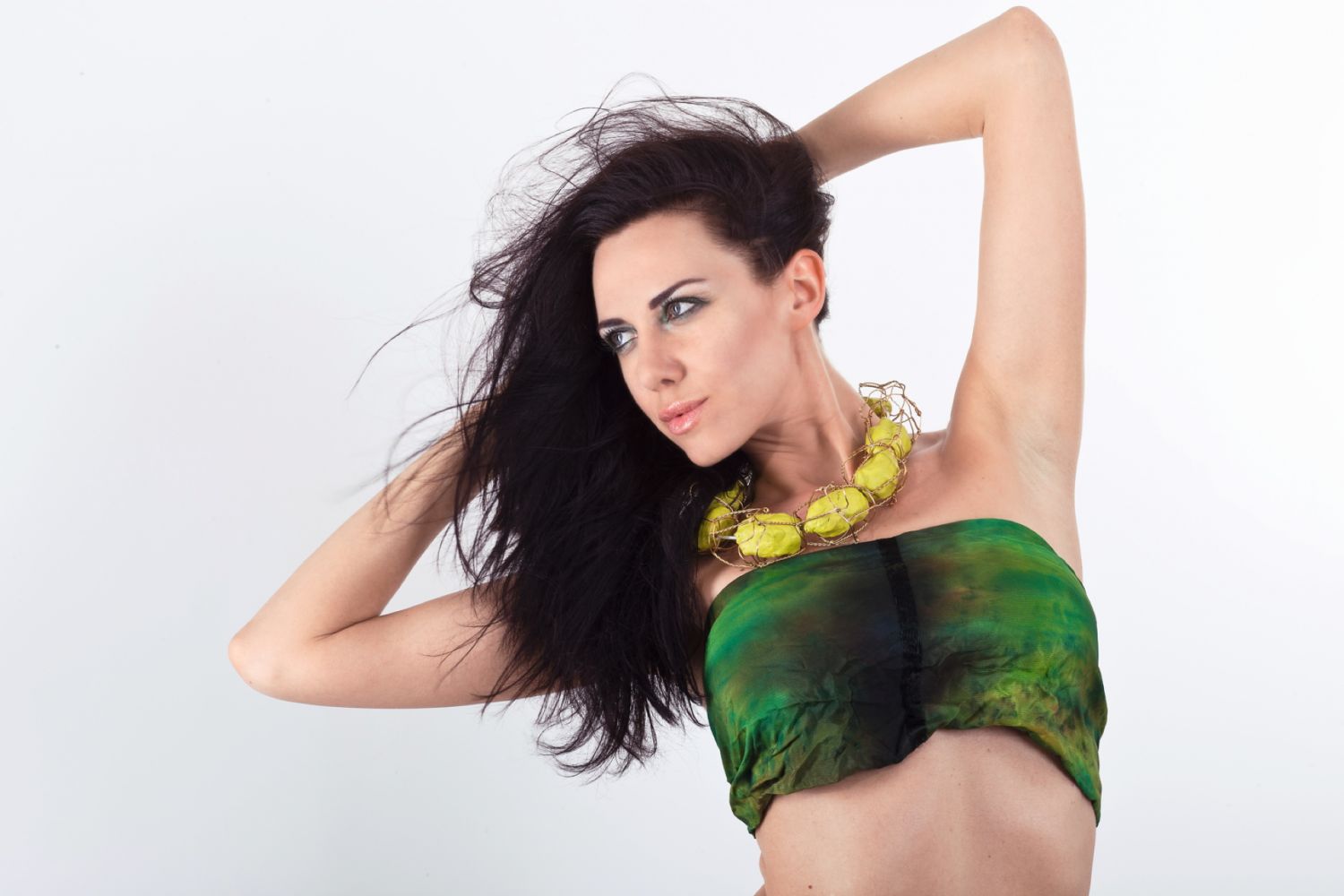
Jane (2005)
Top: tie-silk, painted, crinkled
Jewelry: Champagnebottle muselets, formable putty, painted
-
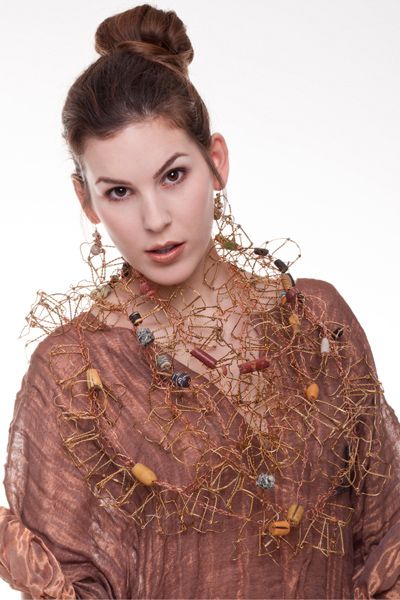
Copper Queen (2010-11)
Dress: textile-copper tissue, crinkled
Adornment: champagnebottle muselets, sundry stones, crocheted with copper wire -
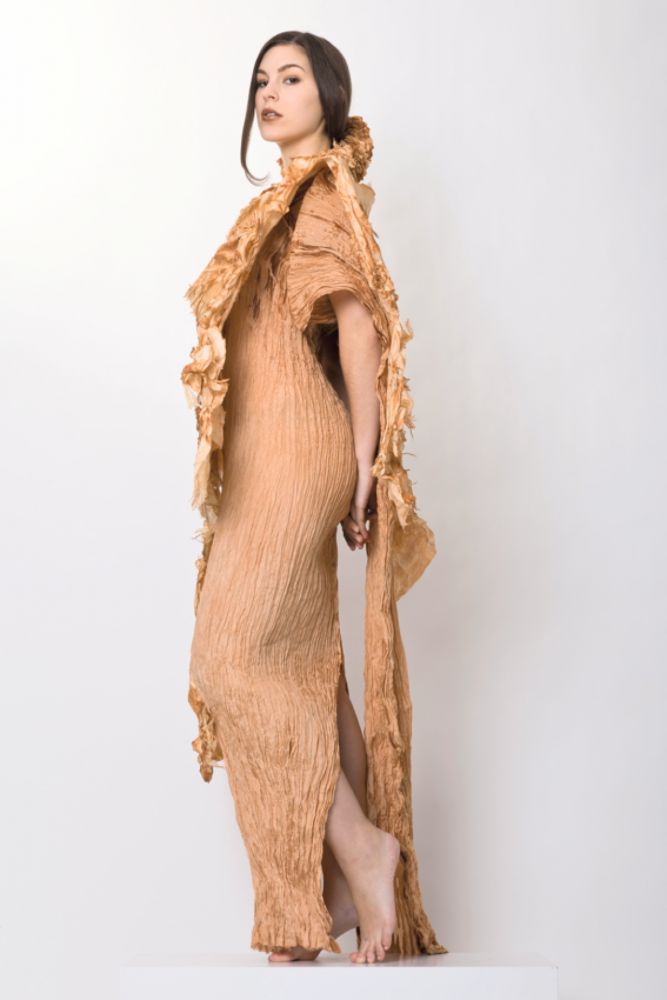
Karukareb II (2010-11)
Dress: Pongé dyed with rooibos-tea, crinkled
Adornment: handmade paper, torn, formed, sewn, dyed with rooibos-tea
-
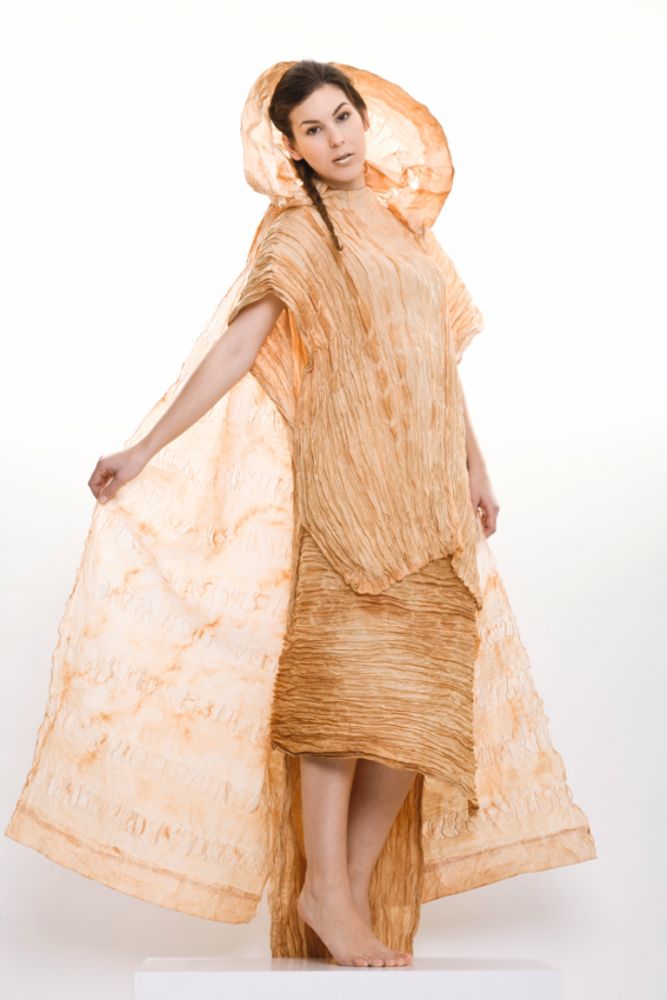
Karukareb I (2010-11)
Dress: Pongé dyed with rooibos-tea, crinkled
Cape: handmade paper, torn, dyed with rooibos-tea
-
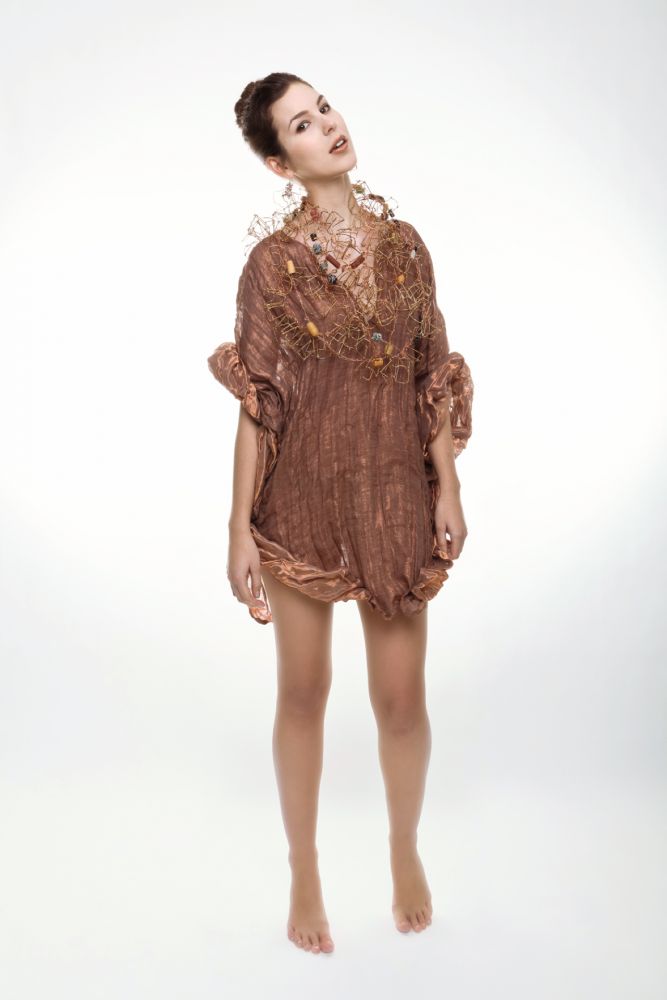
Copper Queen (2010-11)
Dress: Textile-copper tissue, crinkled
Jewelry: Champagnebottle muselets, some gems, crocheted with copper wire -
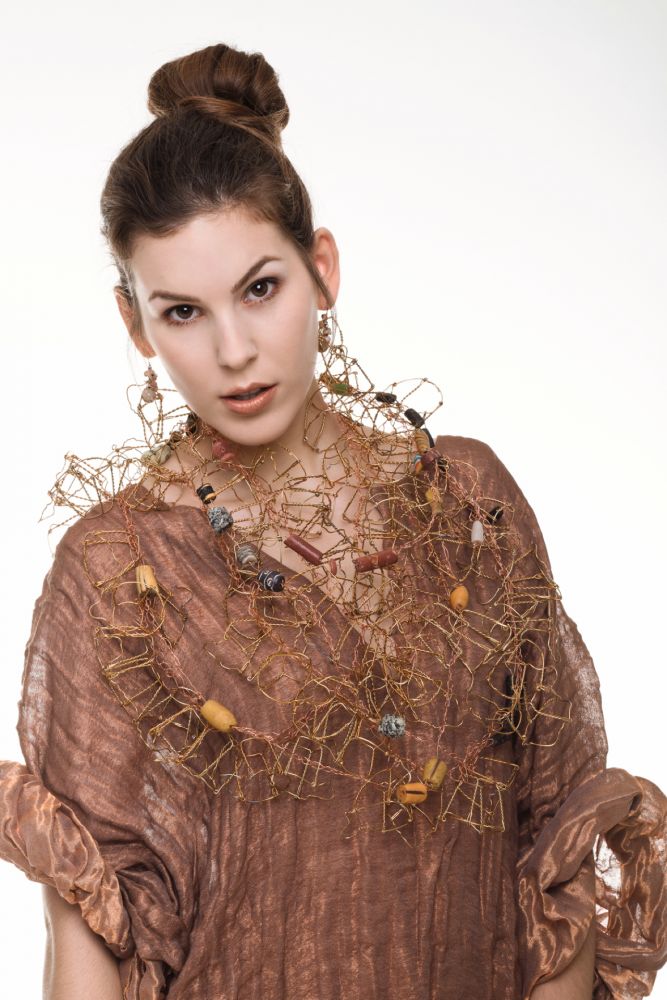
Jewelry: Champagnebottle muselets, some gems, crocheted with copper wire
-
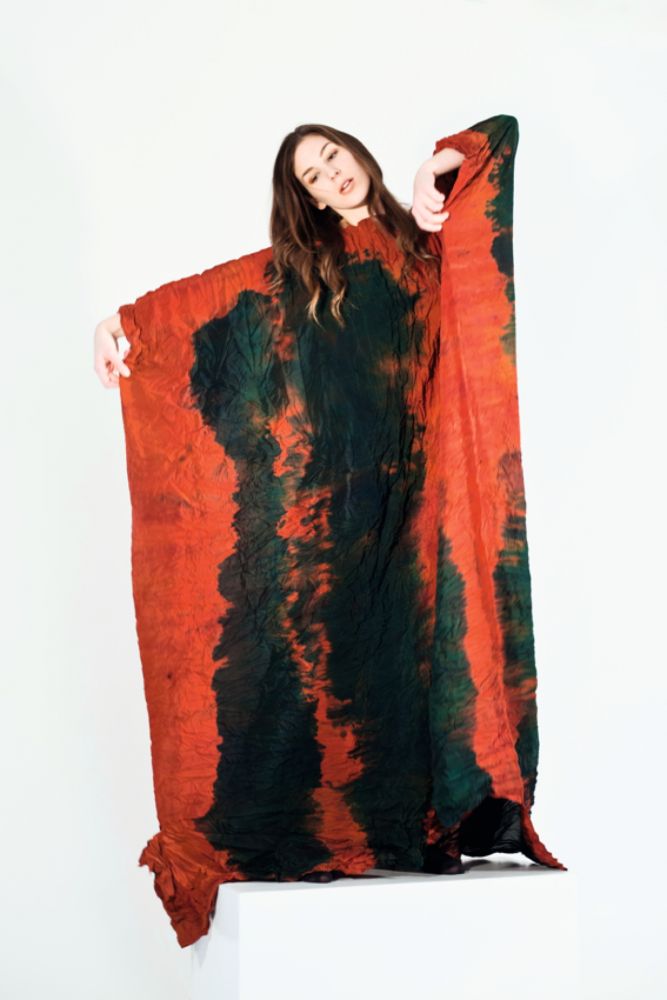
Bejing (2006)
Dress: Twill, painted, folded, crinkled
-
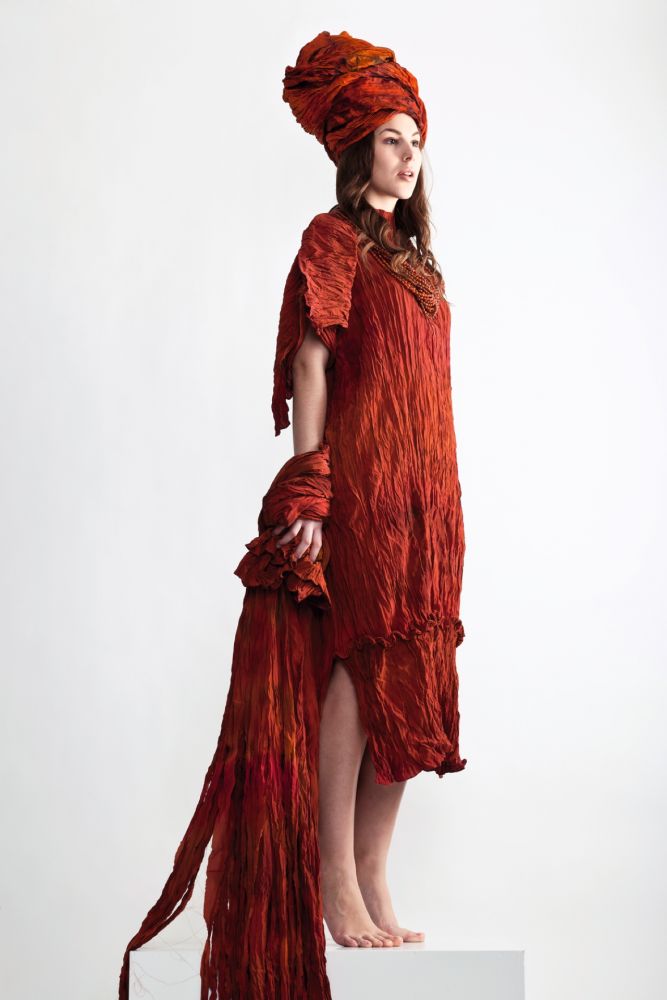
Lucerne (2006)
Dress: Twill, painted, folded, crinkled
Adornment: 2008, fruit-seeds from Africa with wooden fastener
-
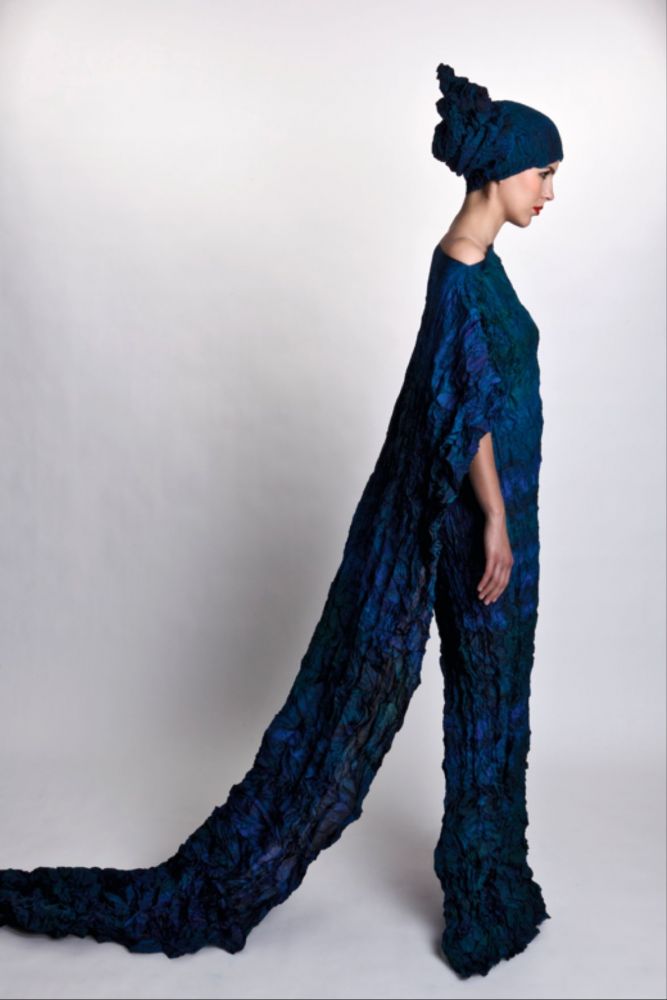
Anna (2010-11)
Dress: Pongee, painted, crumpled
-

Jewelry: Champagnebottle muselets, crocheted with silver wire,
glass pearls -

A Rose is a Rose is a Rose (2010)
Rose: Pongee painted, formed, stiffened
Dress: "brown / red"
-

Phoenix III (1993)
One of a series of five kimonos, painted on both sides on wild silk in fifteen different natural dyes, partially quilted.
Created for the exhibition "Fuku" of the Art to Wear Team in 1993 -
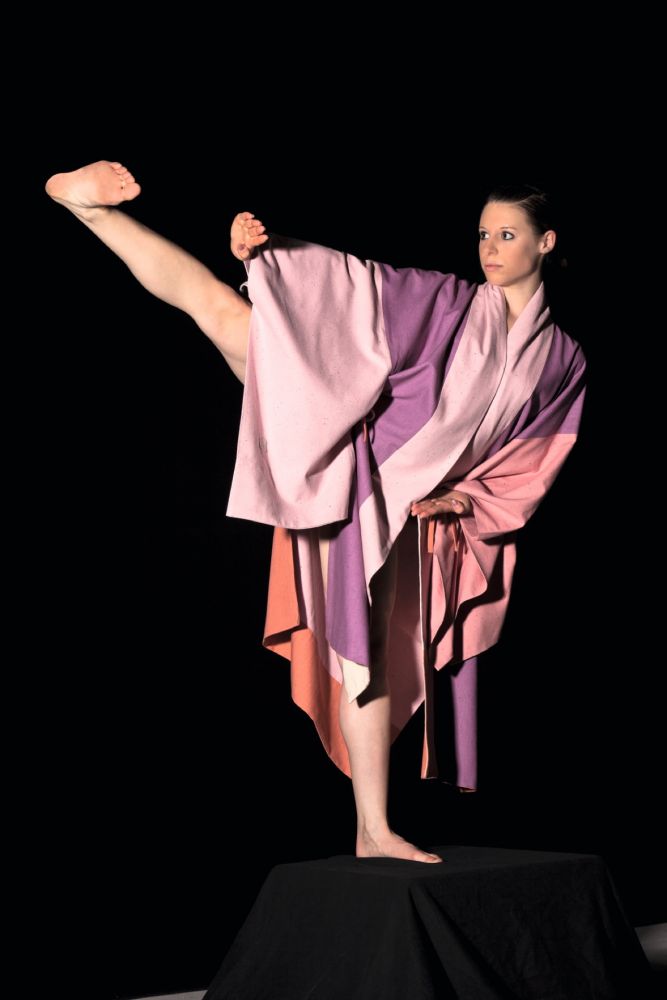
Phoenix II (1993)
One of a series of five kimonos, painted on both sides on wild silk in fifteen different natural dyes, partially quilted.
Created for the exhibition "Fuku" of the Art to Wear Team in 1993 -
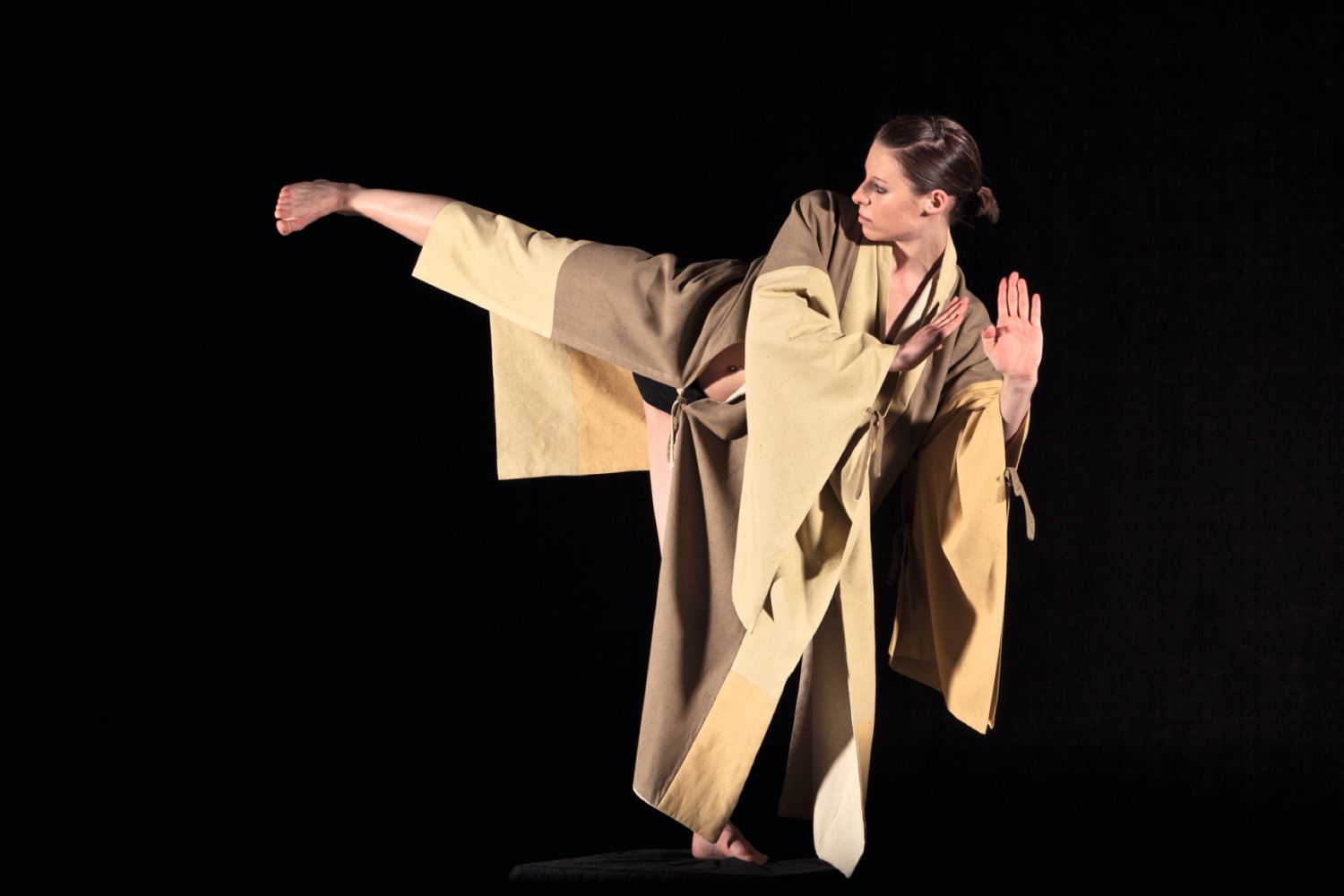
Phoenix I (1993)
One of a series of five kimonos, painted on both sides on wild silk in fifteen different natural dyes, partially quilted.
Created for the exhibition "Fuku" of the Art to Wear Team in 1993 -
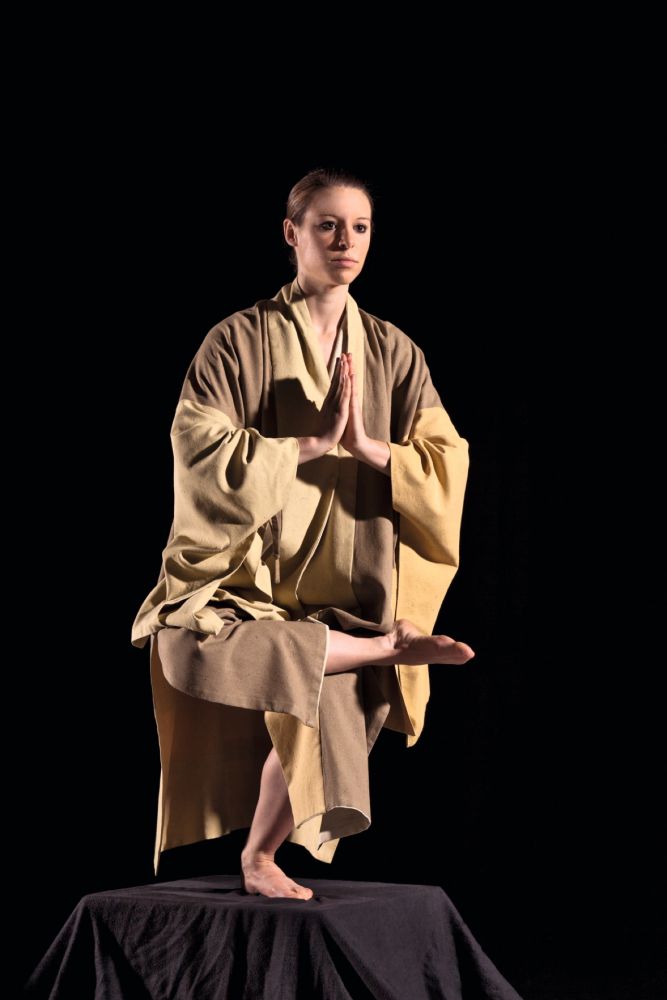
Phoenix I (1993)
One of a series of five kimonos, painted on both sides on wild silk in fifteen different natural dyes, partially quilted.
Created for the exhibition "Fuku" of the Art to Wear Team in 1993 -
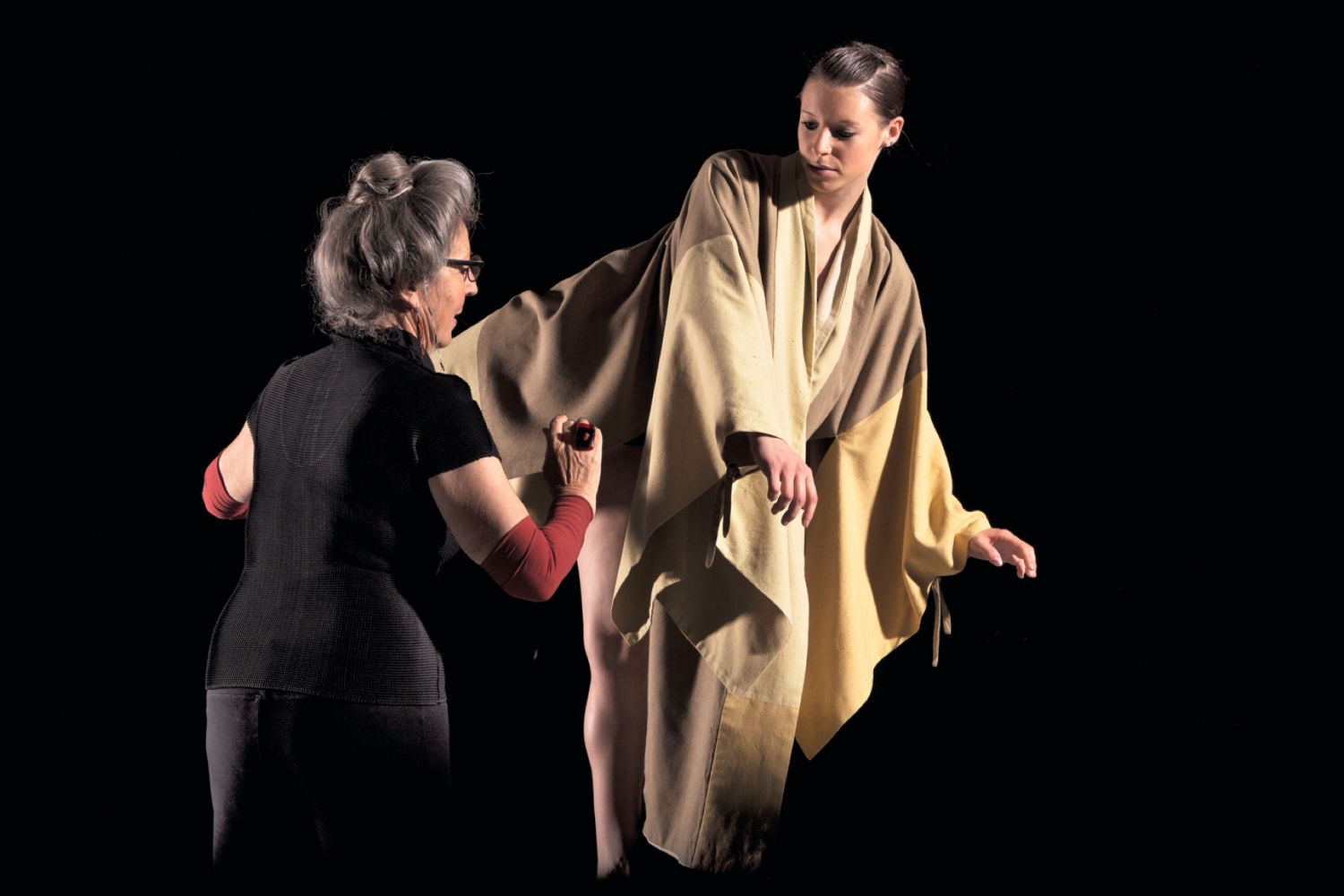
Mascha preparing Stefanie for the foto-shooting
-
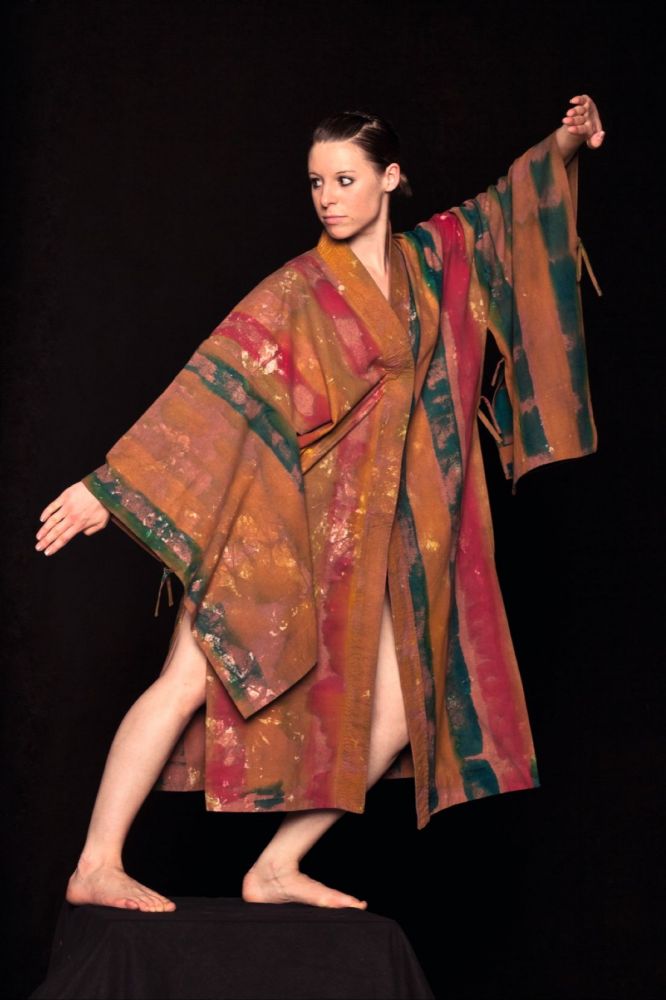
Phoenix VI (1993)
Kimono, Shibori
Created for the exhibition "Fuku" of the Art to Wear Team 1993 -
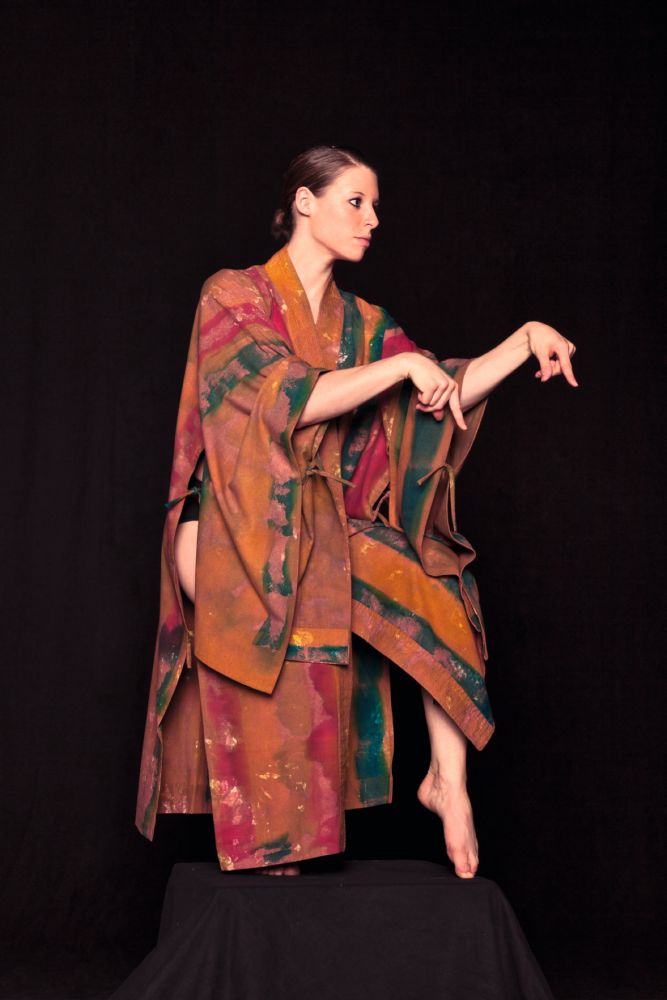
Stefanie posing as Praying Mantice
Phoenix VI (1993)
Kimono, Shibori
Created for the exhibition "Fuku" of the Art to Wear Team 1993
-
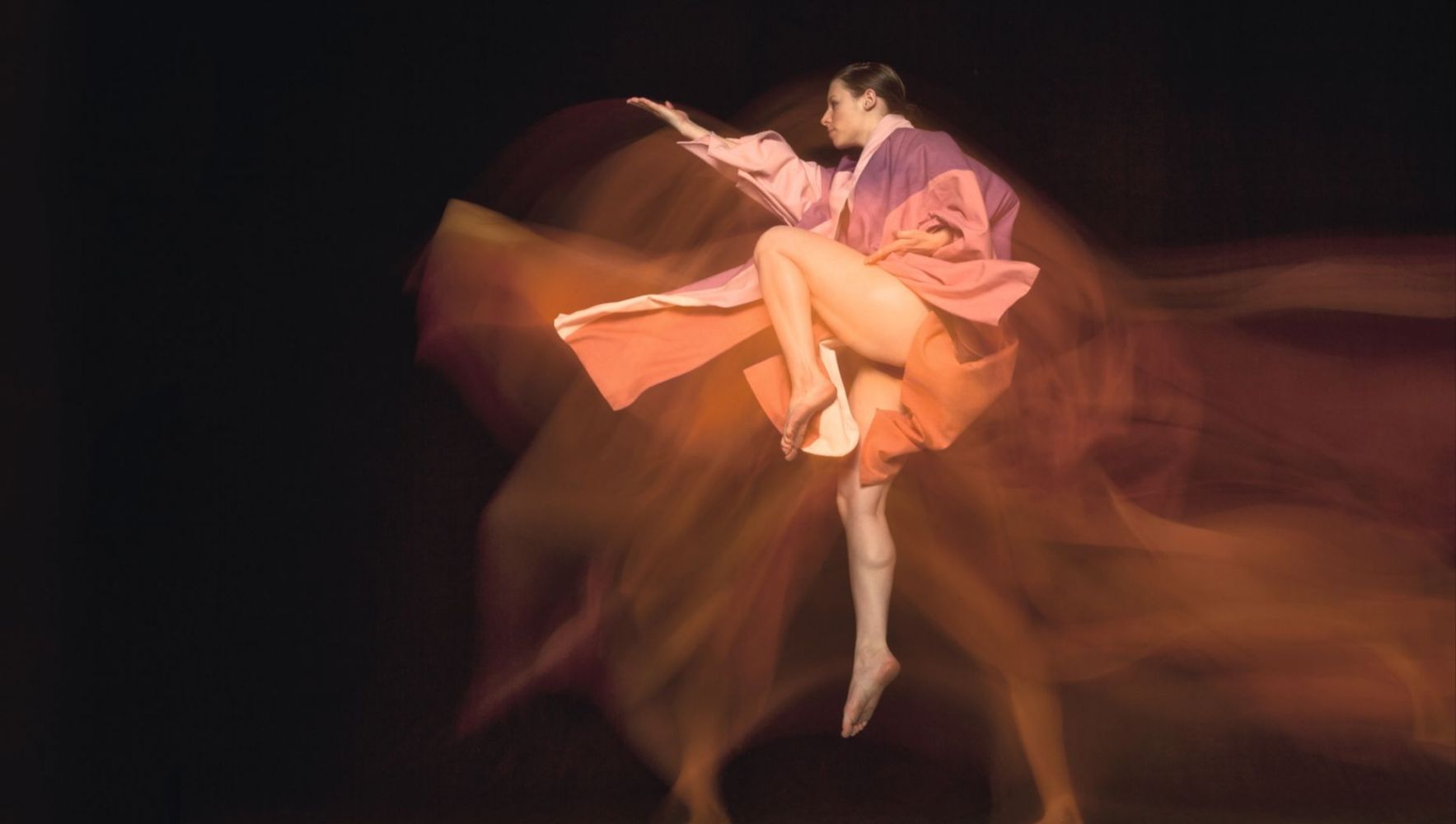
Phoenix II (1993)
One of a series of five kimonos, painted on both sides on wild silk in fifteen different natural dyes, partially quilted.
Created for the exhibition "Fuku" of the Art to Wear Team in 1993 -
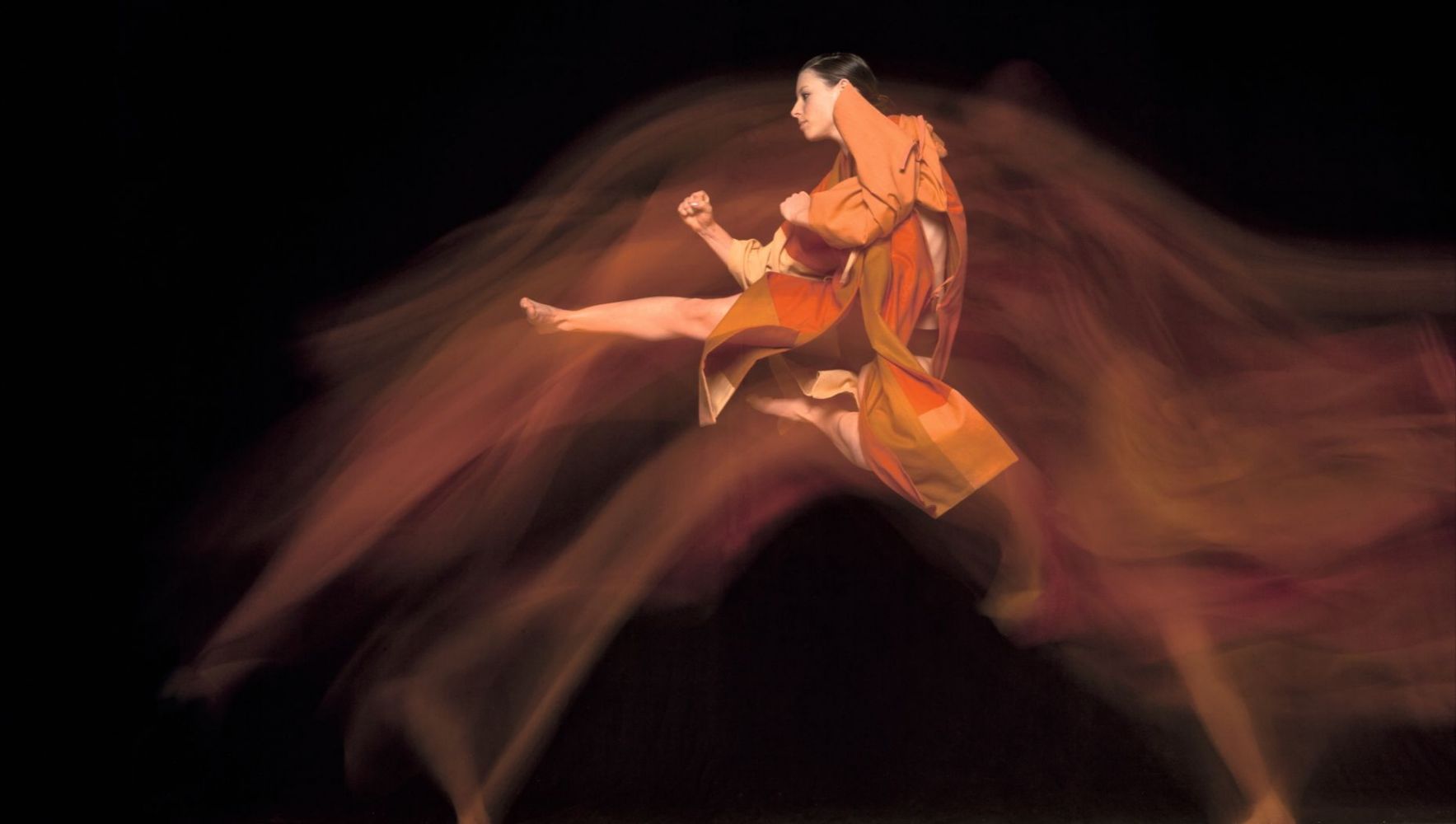
Phoenix III (1993)
One of a series of five kimonos, painted on both sides on wild silk in fifteen different natural dyes, partially quilted.
Created for the exhibition "Fuku" of the Art to Wear Team in 1993 -
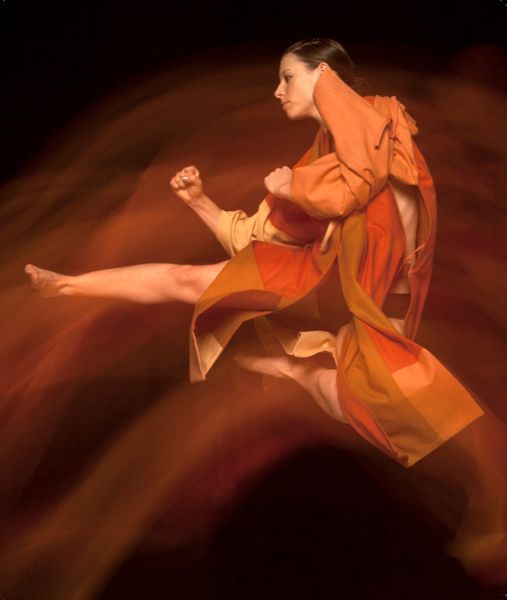
Phoenix III (1993)
One of a series of five kimonos, painted on both sides on wild silk in fifteen different natural dyes, partially quilted.
Created for the exhibition "Fuku" of the Art to Wear Team in 1993
2011 Art to Wear 4
In front of the lens of Carlos Rieder - Textile Art Mascha Mioni
In front of the lens of Carlos Rieder - Textile Art Mascha Mioni
go to post
-

Die Abschiede (The Farewells) -- Acrylic on linen 2004
-

From the series Magic Dragon -- 50m of Pongée silk, painted with Dupont colors, pleated, steam set. Designed for 'Fashionation' performance at the Swiss National Museum, Zurich in 2002
-
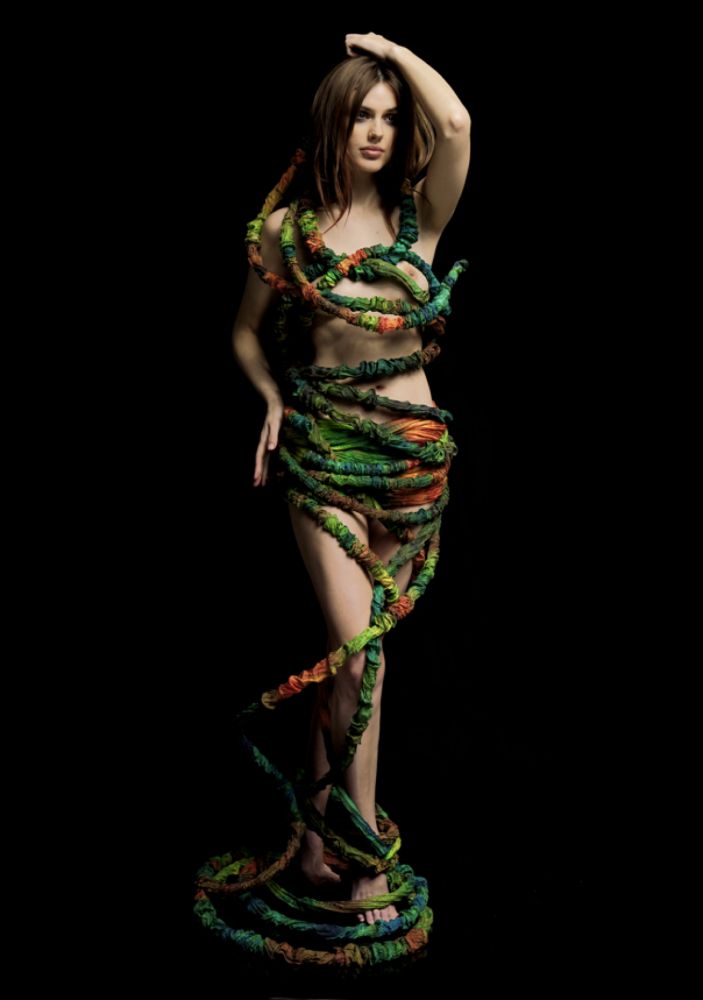
The Gordian Knot as dress -- silk painted with Dupont colors, steam set, put over a PVC pipe.
-
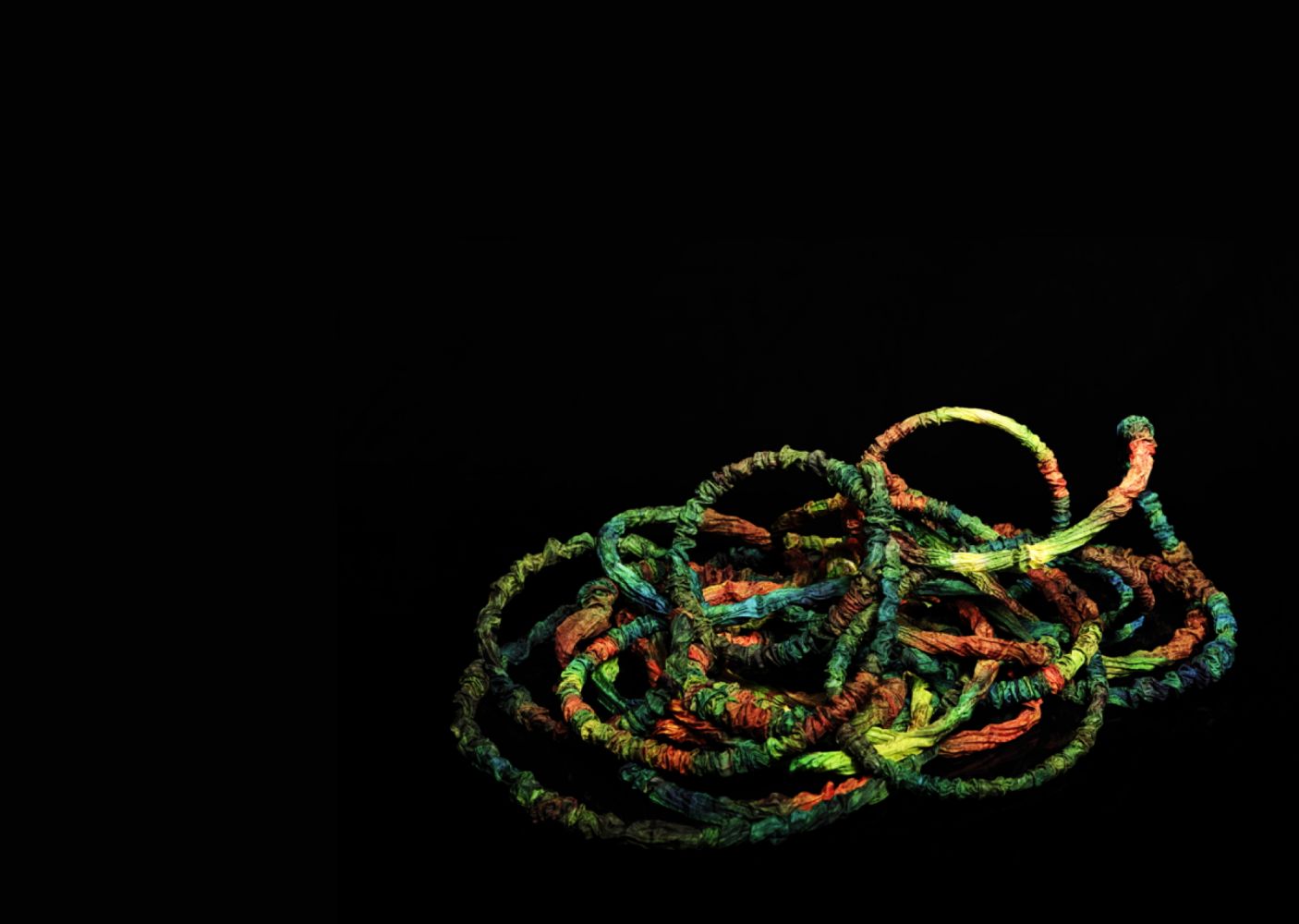
The Gordian Knot as an object of art
-
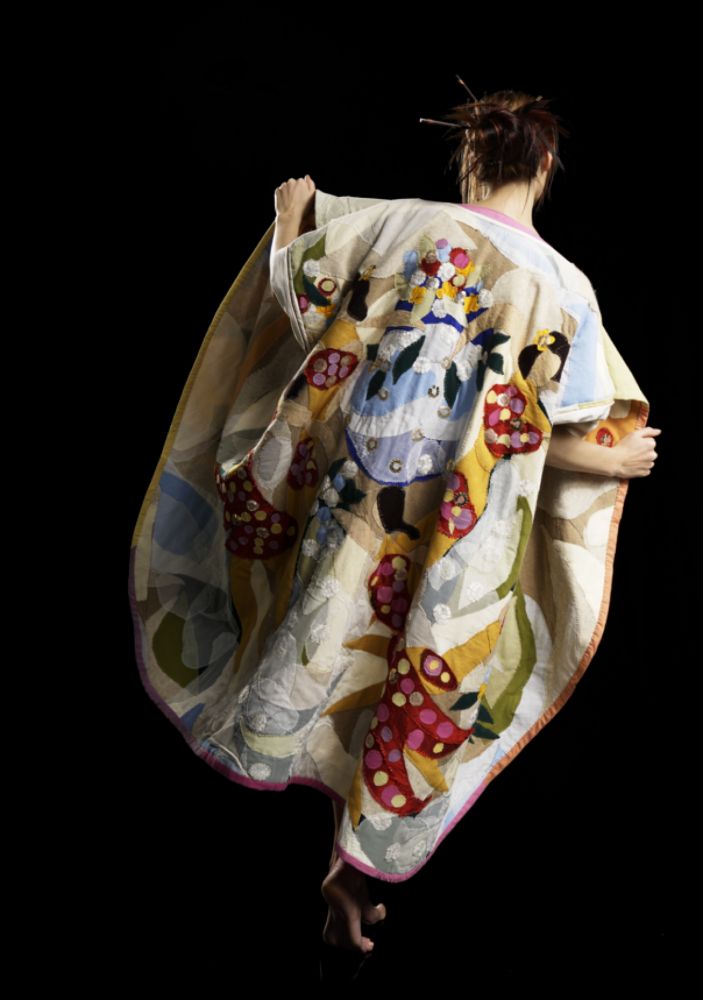
Ode to Art and Dress -- Cotton cape with mutlayered applications of fabric remnants sewn on by hand, Inside: naturally died wild silk, can be worn reversible, 1974-93
-
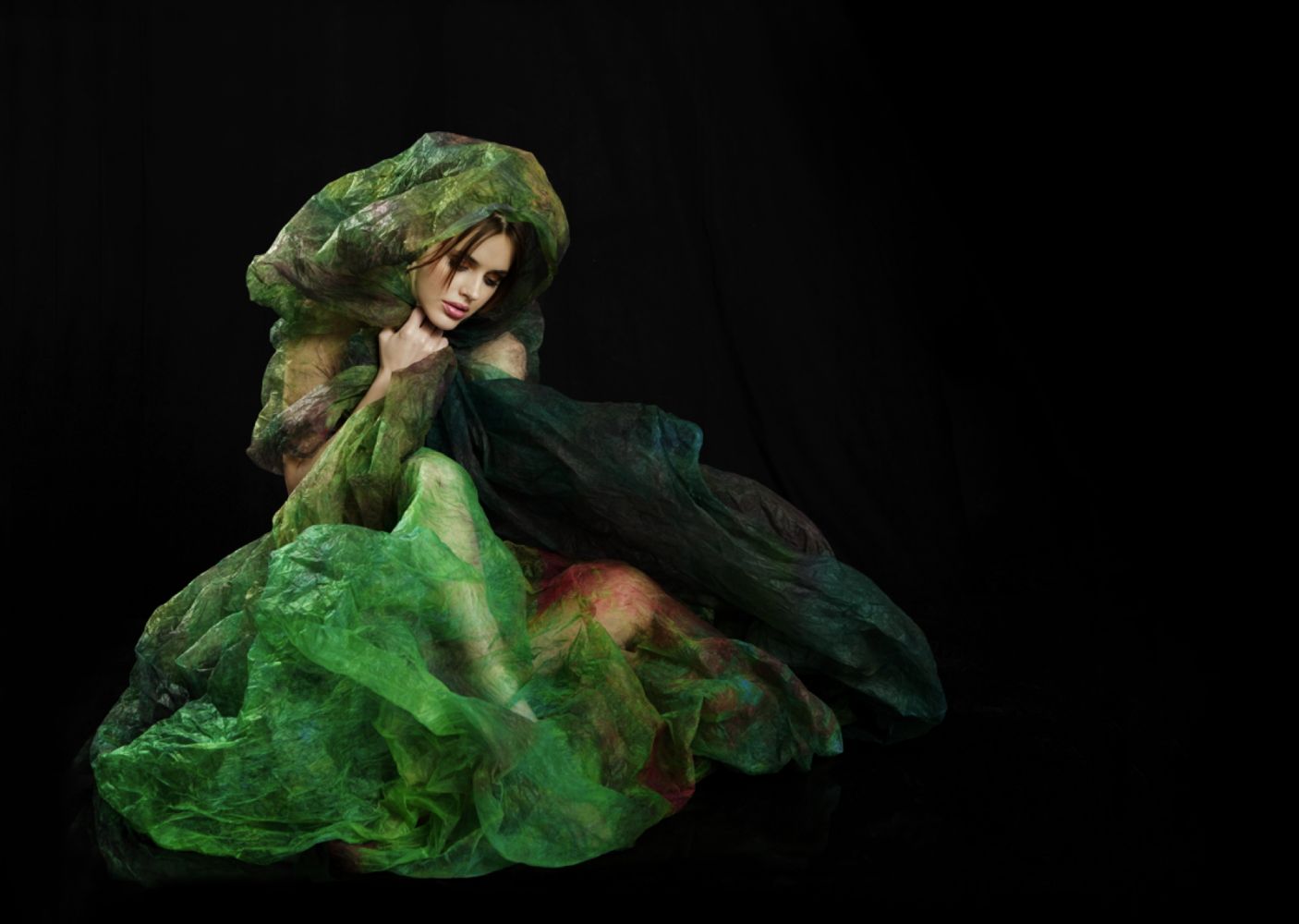
-
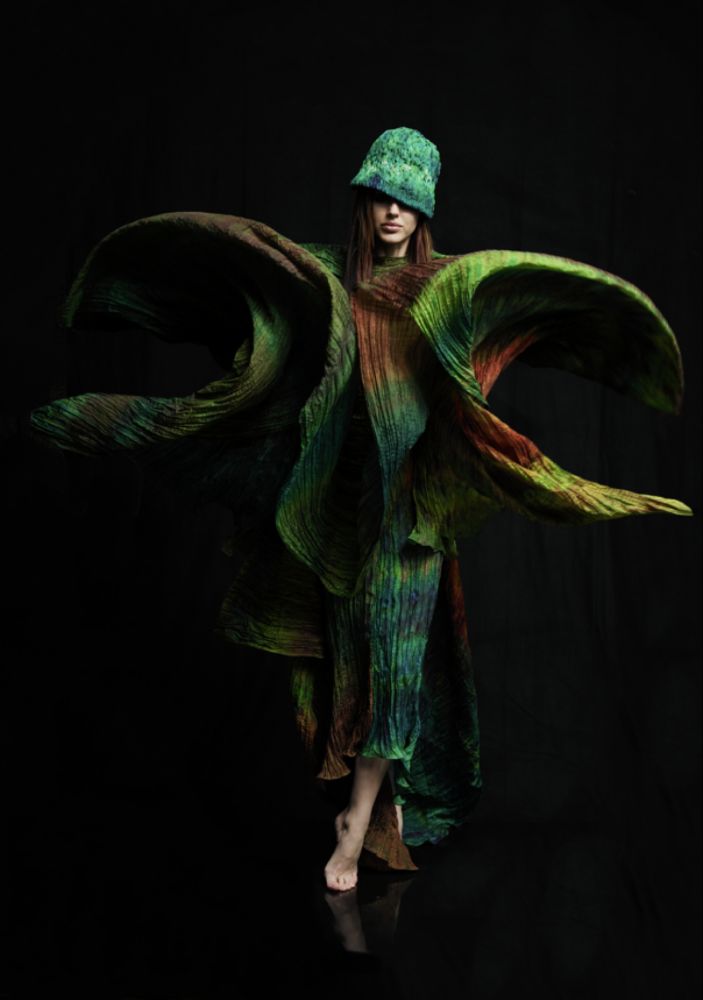
-

-
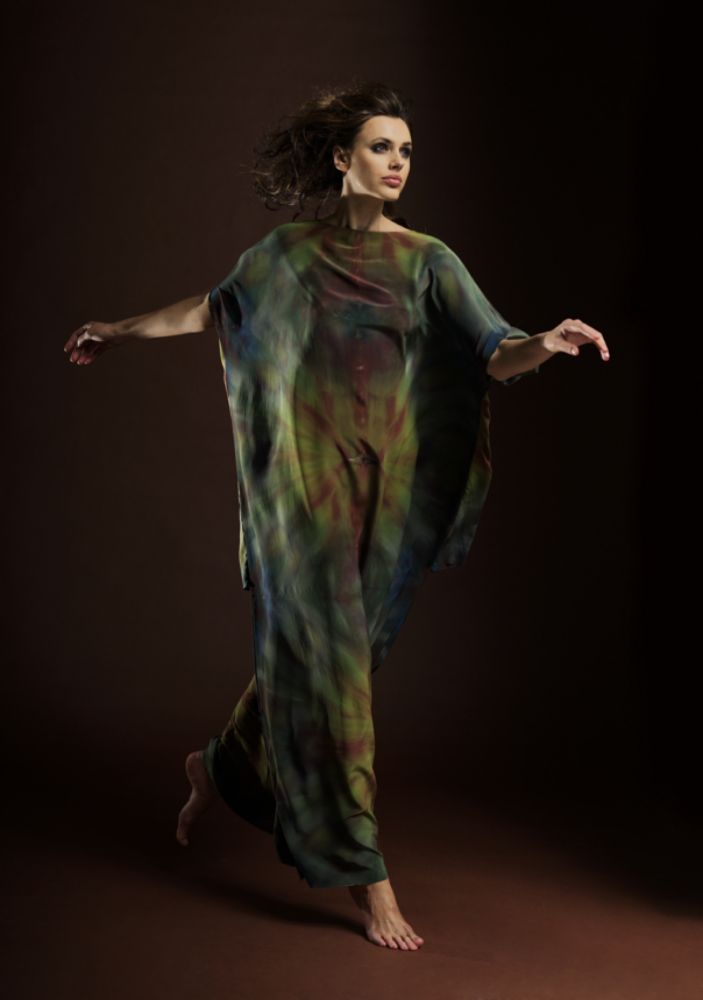
-
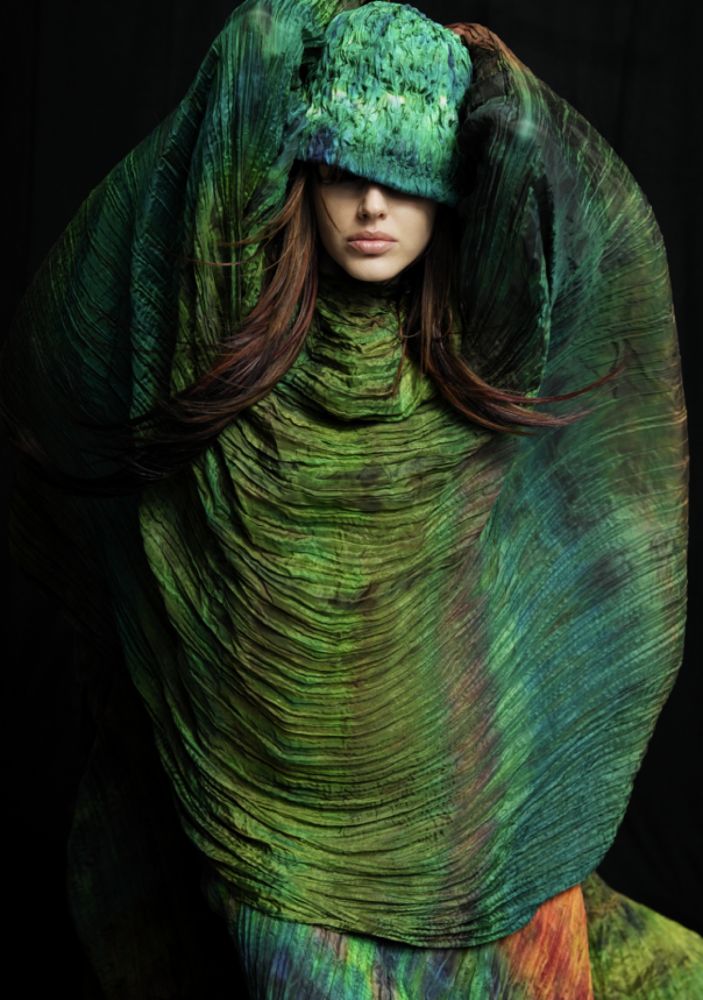
The Gordian Dress (2005)
Parachute silk, painted with Dupont paint, crinkled, steam set, folded longitudinal and transverse
Hat: Same material as dress, quiltet on hat form
Foto © Asy Asendorf, Zurich
-
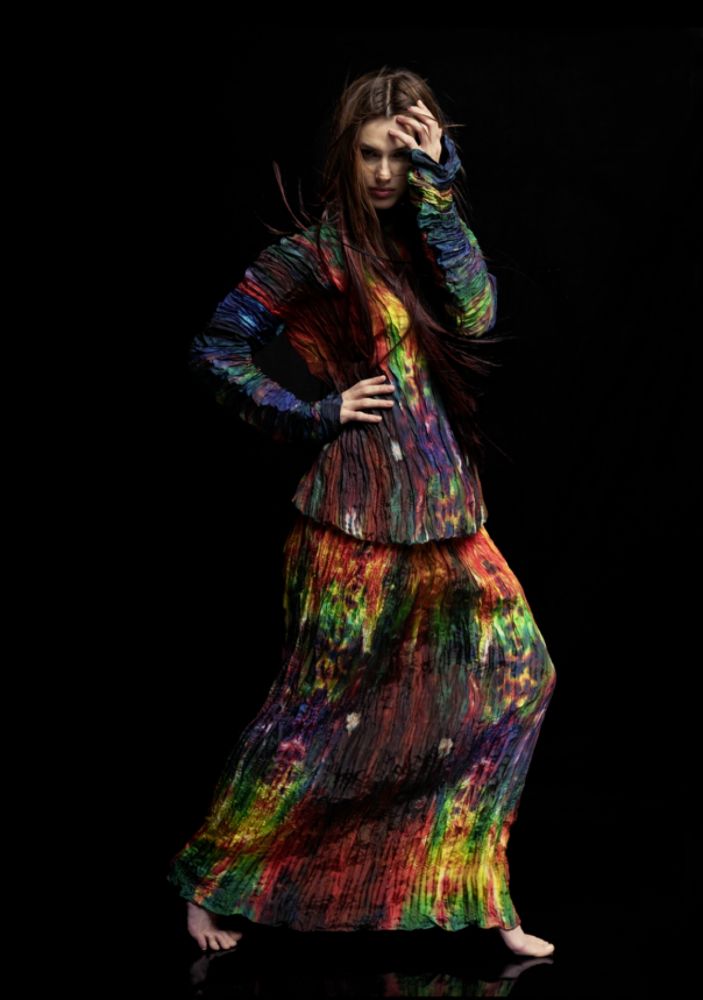
From the series Mussaii (2004)
2004: Seven art students interpreted the Mussaii dresses in a dance at the 5th International Shibori Symposium in Melbourne
2004: Performance and videodocumentation "Was ist er...?" ("Who is he...?") by the dance company Irene K. in a dress of the Mussaii-series in Winterspelt, Germany
http://maschamioni.ch/en/art/art-wear-performances#a446
Foto © Asy Asendorf, Zürich
-

From the series Mussaii (2004)
Silk painted with Dupont paint, crinkled, steam set
Seven modular parts, to be combined as preferred and worn on top of each other
Foto © Asy Asendorf, Zurich
-
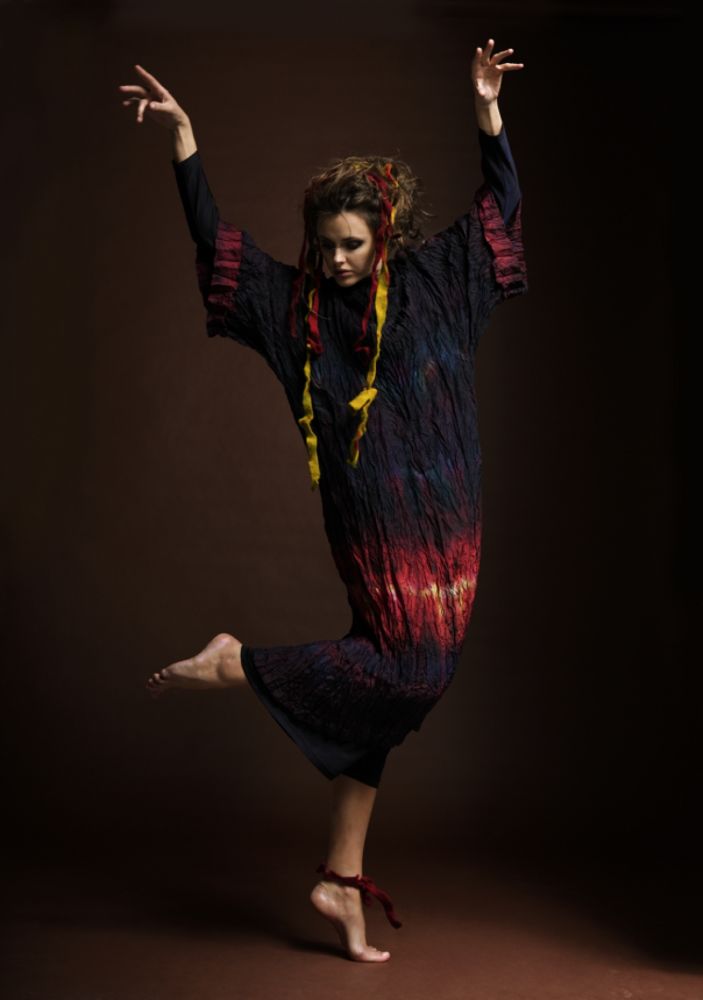
Born from the Ashes (2002-3)
Dress: Silk painted with Dupont paint, steam set, with 1mm wide, quilted cording
Head dress: Felt, painted in the same colors
Foto © Asy Asendorf, Zurich
-

Star Wars (2003-4)
Dress: Heavy Jersey silk, painted with natural dyes, steam set
Adornment: Silk ribbon, painted with Dupont paint, sewn to form a tube, put over a cord and nested
Foto © Asy Asendorf, Zurich
-
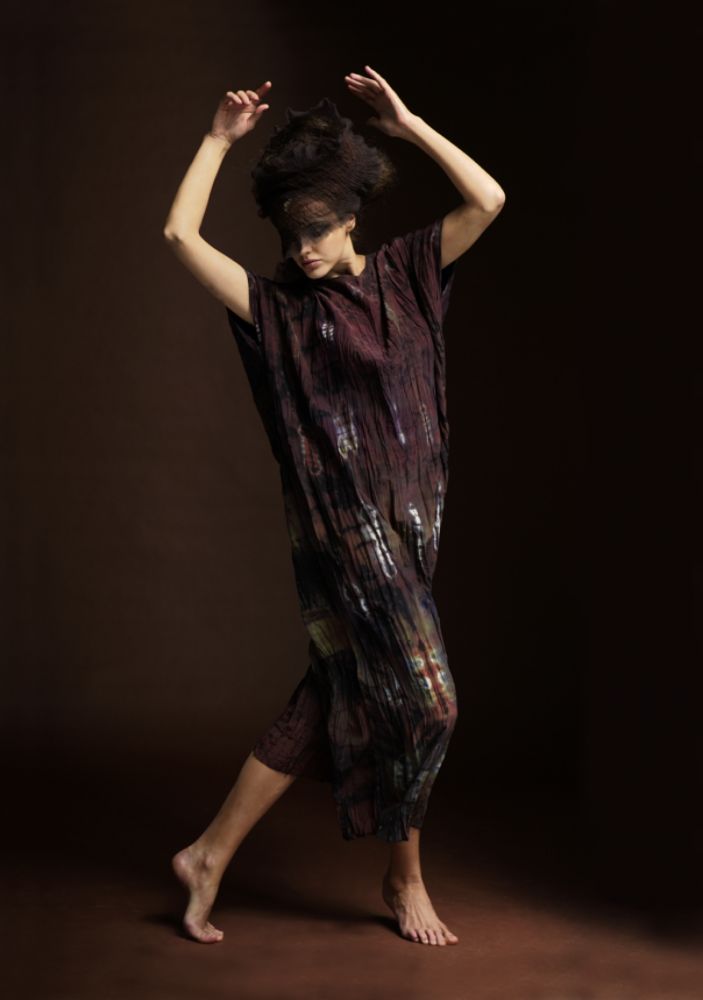
Africana I
Headdress: Gunma silk, painted with Dupont paint, heated, complemented with oil paint
Foto © Asy Asendorf, Zurich
-
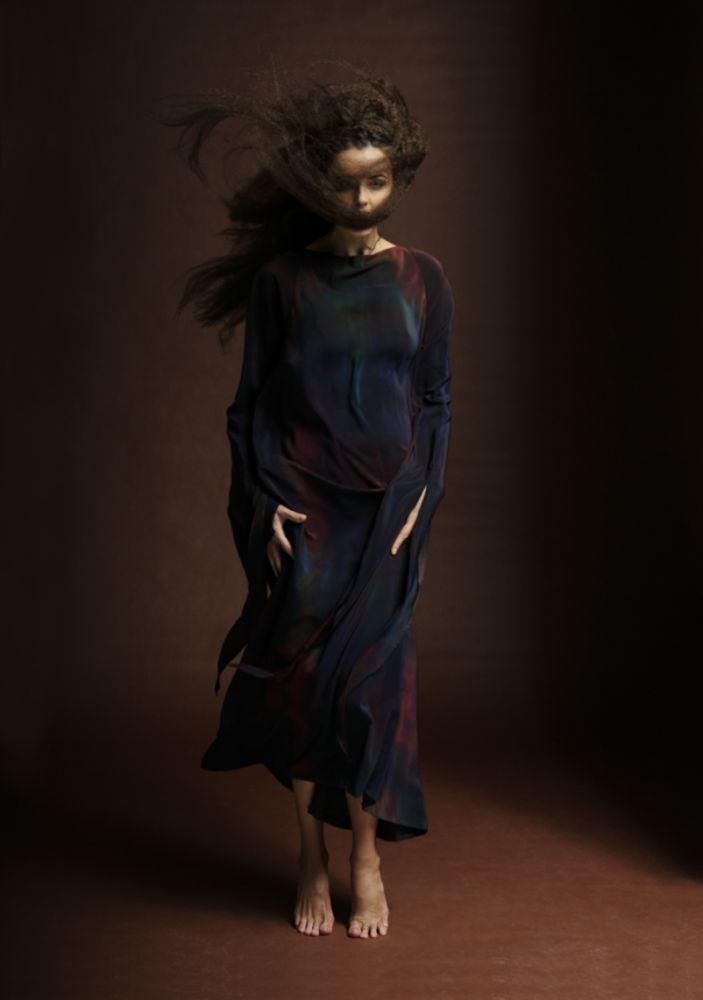
Derwisch (2002-5)
Crêpe de Chine, painted in dark shades of Dupont paint, steam set, with overlong, pointed raglan sleeves
Foto © Asy Asendorf, Zurich
-
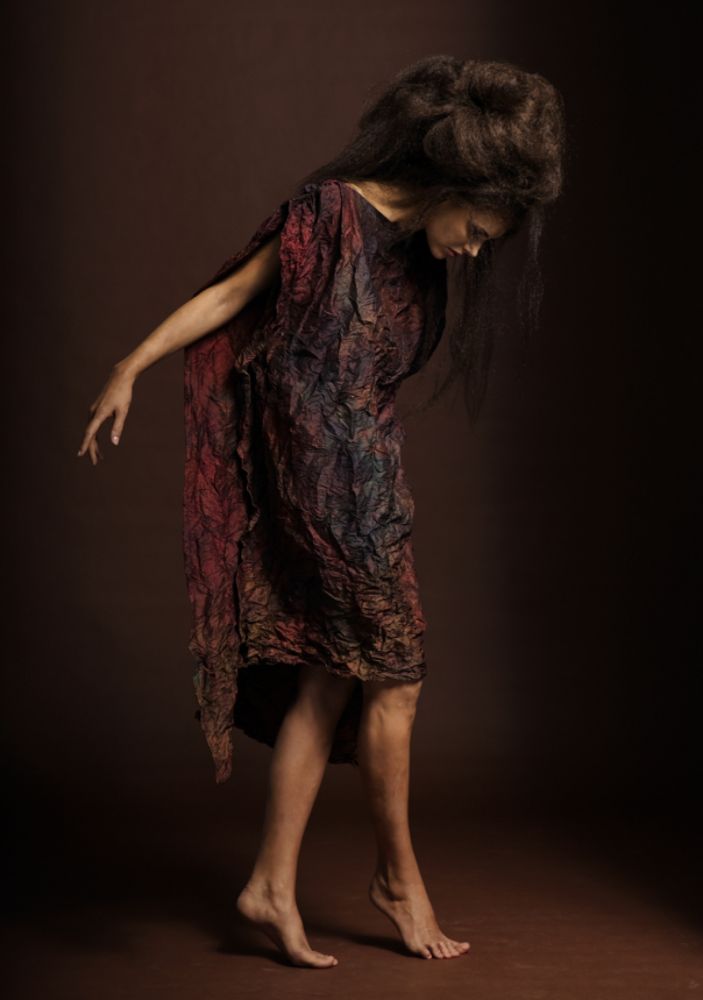
Africana II (2002-5)
Thai silk, painted with Dupont paint, crinkled, steam set
Foto © Asy Asendorf, Zurich
-
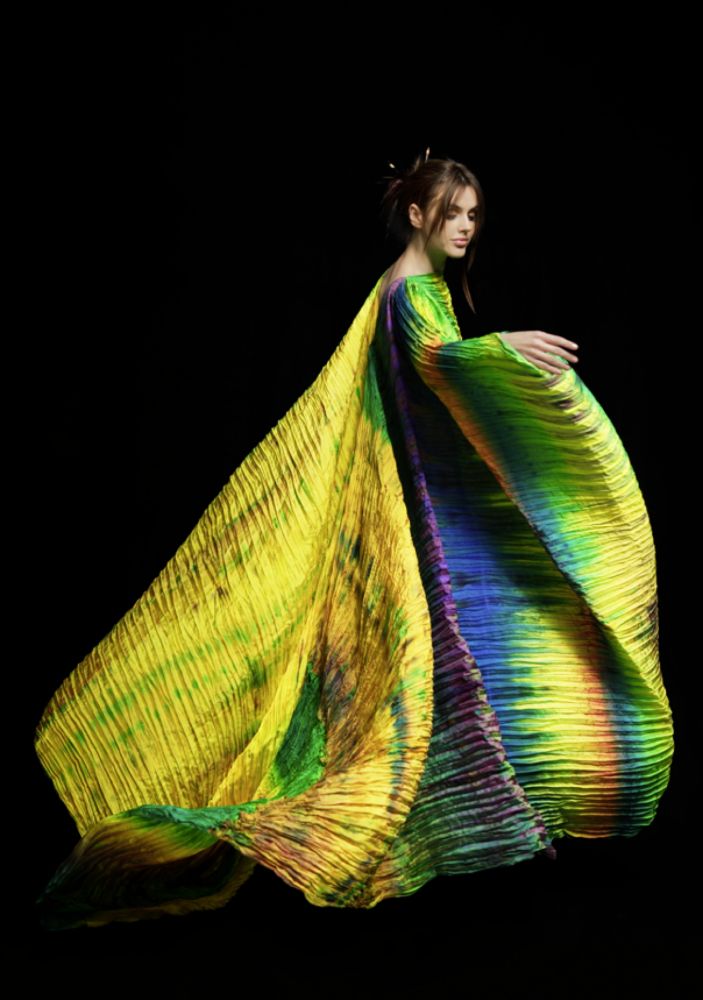
From the series Magic Dragon (2002)
Three dresses, 50 meters Pongée silk, painted with Dupont paint, crinkled, steam set
Designed for the show "Fashionation" 2002 at the Swiss National Museum, staged by Raphael Brand and his dance cast
Foto © Asy Asendorf, Zurich
-

Africana III (2003-5)
Silk, in shibori-tecnique bound lappets, painted with Dupont paint, crinkled, steam set
Foto © Asy Asendorf, Zurich
-
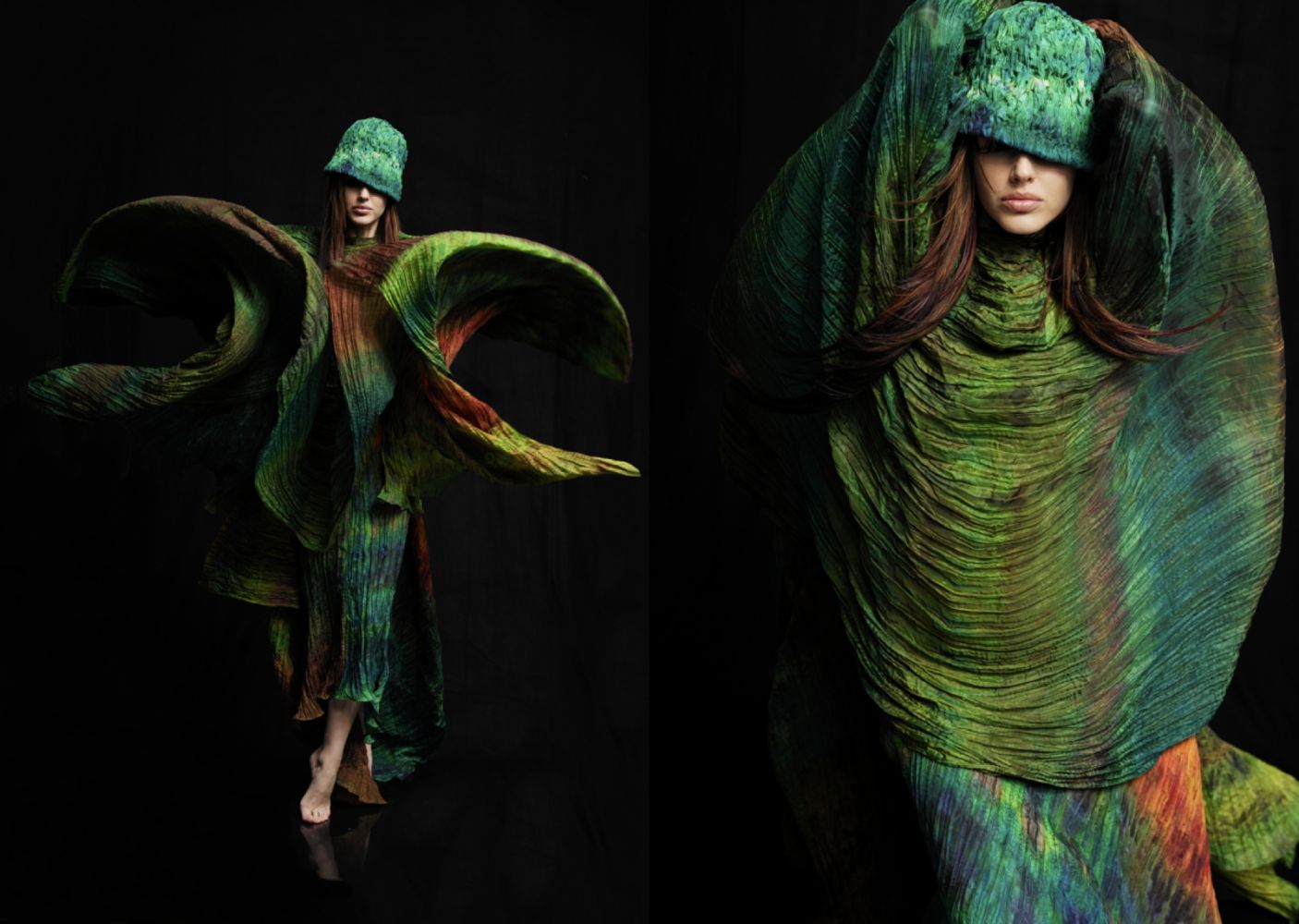
The Gordian Dress (2005)
Parachute silk, painted with Dupont paint, crinkled, steam set, folded longitudinal and transverse
Hat: Same material as dress, quiltet on hat form
Foto © Asy Asendorf, Zurich
-
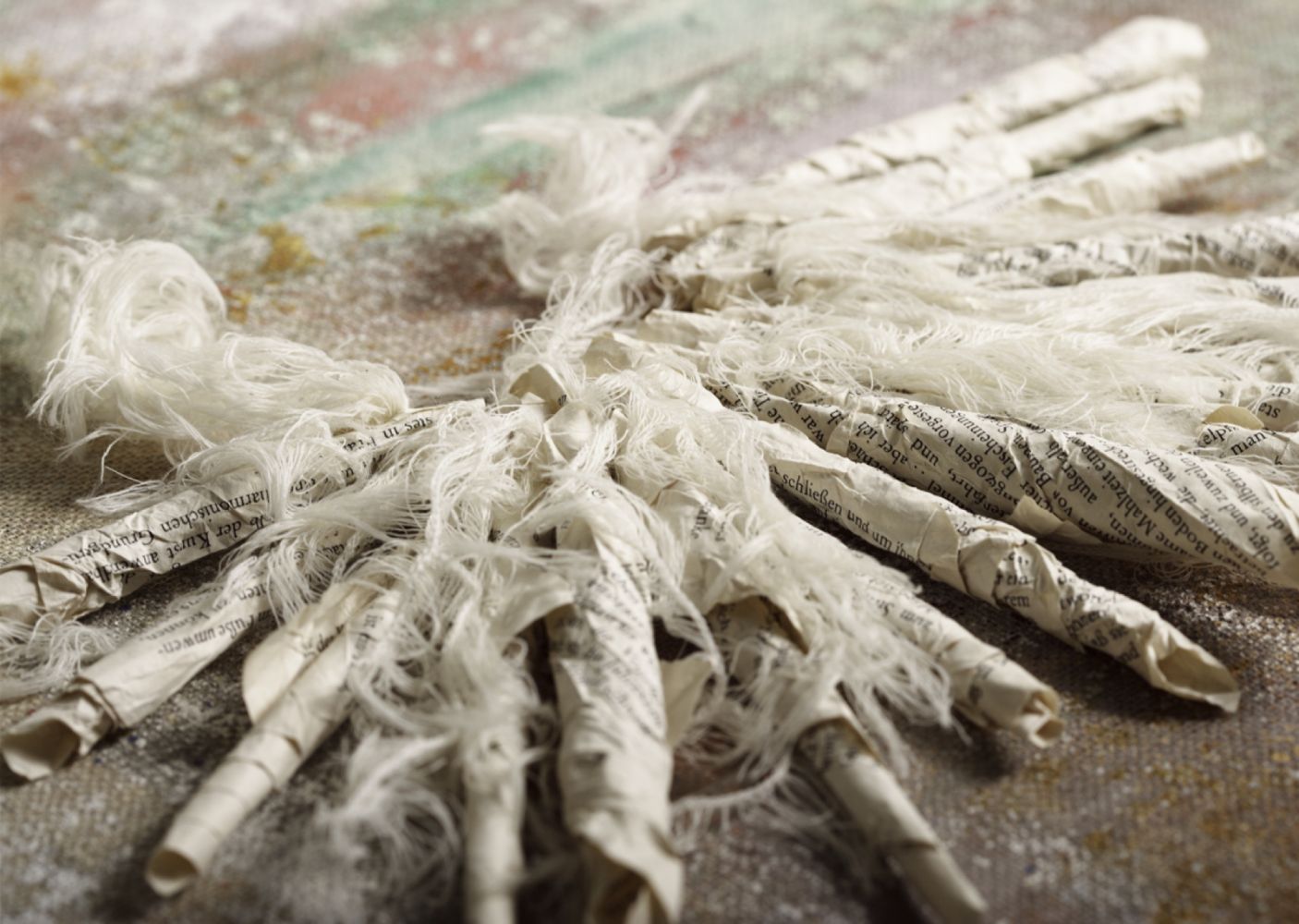
Adornment: wet rolled pages of a book with natural cotton threads
Foto © Asy Asendorf, Zurich -
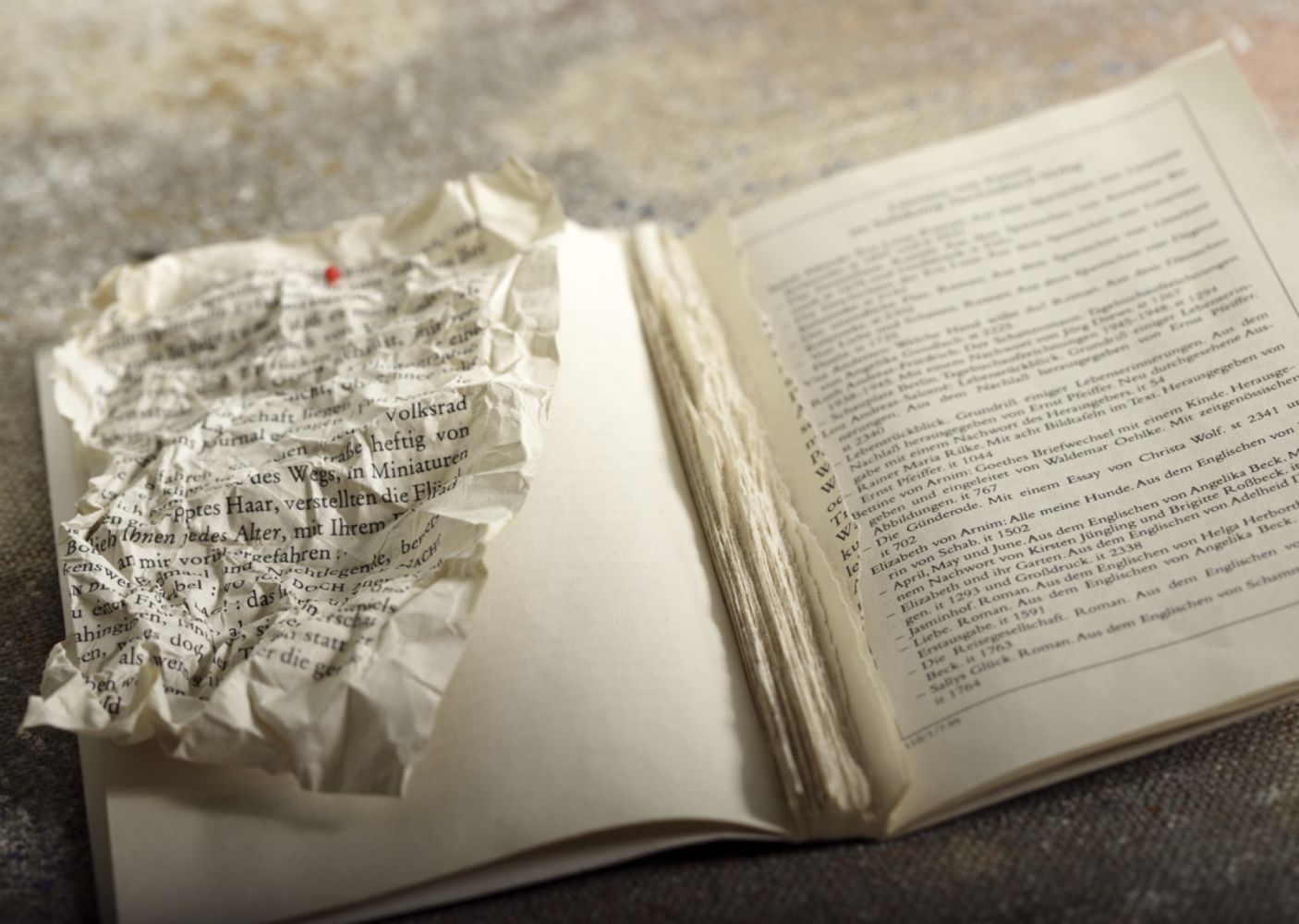
Last page of the completely recycled novel "Die Abschiede" ("The Farewells") by Friederike Mayröcker
Foto © Asy Asendorf, Zurich
-
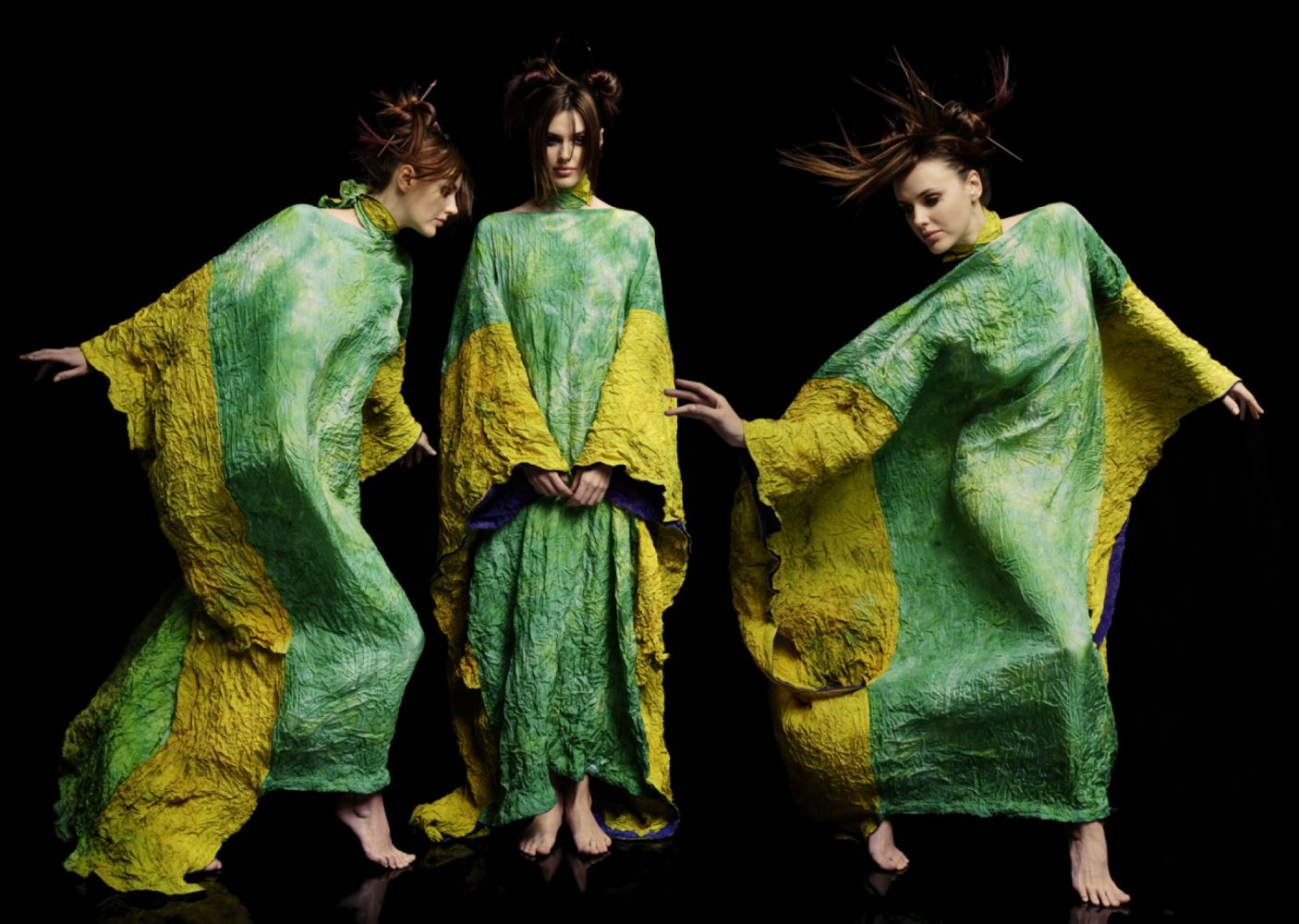
Madame Butterfly (2002-4)
Silk painted with Dupont paint, crinkled, steam set
Foto © Asy Asendorf, Zurich
-
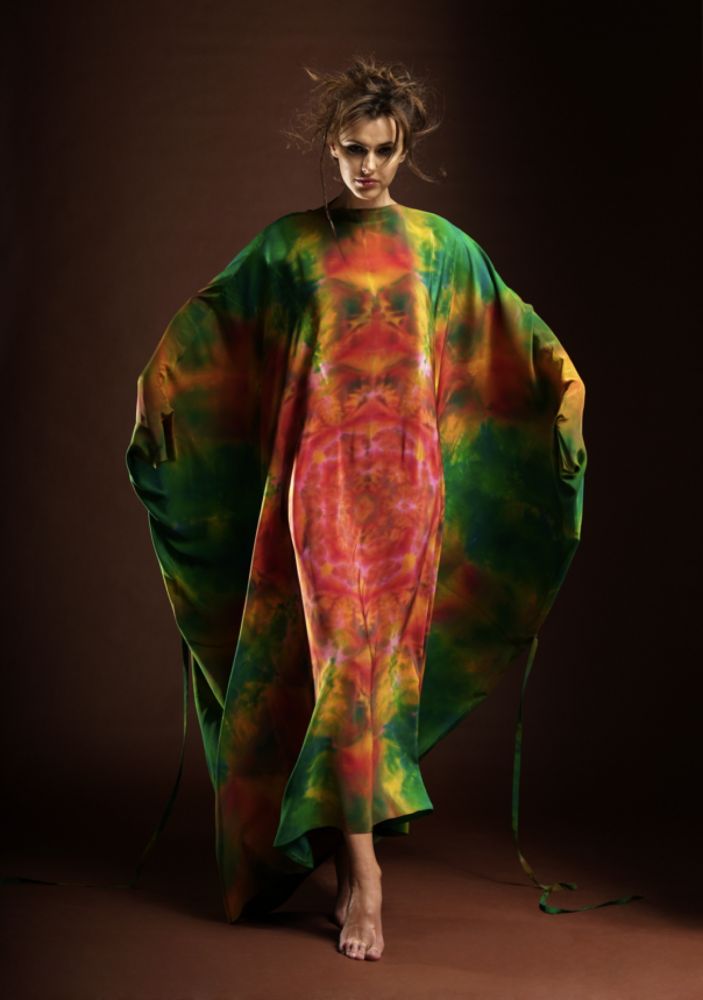
Flower Garden (2004-5)
Crêpe de Chine, double layered, painted with Dupont paint, steam set
Foto © Asy Asendorf, Zurich
-

Adornment of the Librarian: Wet pages from a book, circularly torn and stringed on silver wire
Foto © Asy Asendorf, Zürich
-

The Farewells (2004)
Dress: Acryl paint on canvas
Adornment: Pages from a book and canvas painted with acryl, cut circular, pleated and sewn on silver wire
Foto © Asy Asendorf, Zurich
-

Africana I
Headdress: Gunma silk, painted with Dupont paint, heated, complemented with oil paint
Foto © Asy Asendorf, Zurich
-
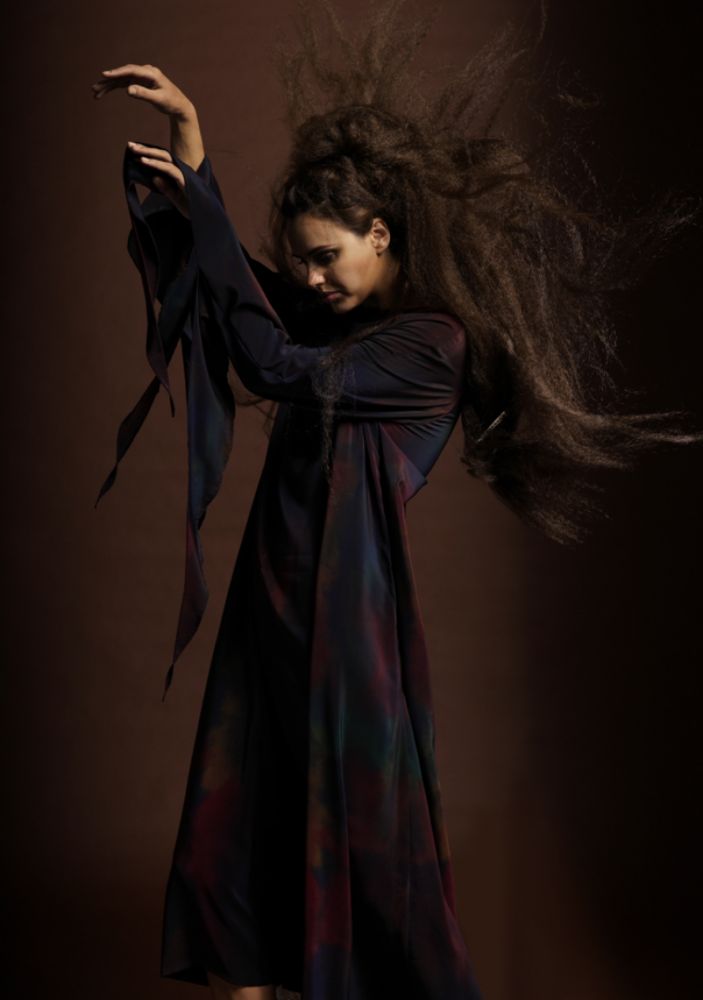
Derwisch (2002-5)
Crêpe de Chine, painted in dark shades of Dupont paint, steam set, with overlong, pointed raglan sleeves
Foto © Asy Asendorf, Zurich
2005 Art to Wear 3
In this book photographer Asy Asendorf interpretes and stages my Art to Wear creations of 2001 to 2005.
The textile creations of Art to Wear are autonomous works, which get their meaning and content from the human body, its movements and the individual interpretation of the Art to Wear dress by its wearer.
In this book photographer Asy Asendorf interpretes and stages my Art to Wear creations of 2001 to 2005.
The textile creations of Art to Wear are autonomous works, which get their meaning and content from the human body, its movements and the individual interpretation of the Art to Wear dress by its wearer.
go to post
-
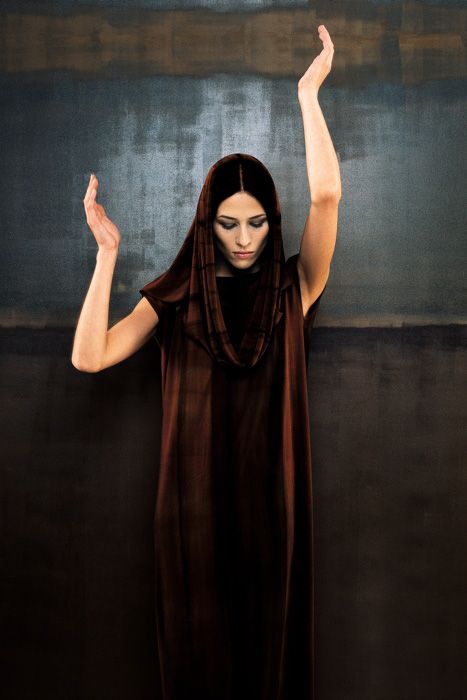
Sérail -- painted on silk jersey
-

Phoenix, Born from the Ashes -- Pongee, painted, shibori, pleated
-
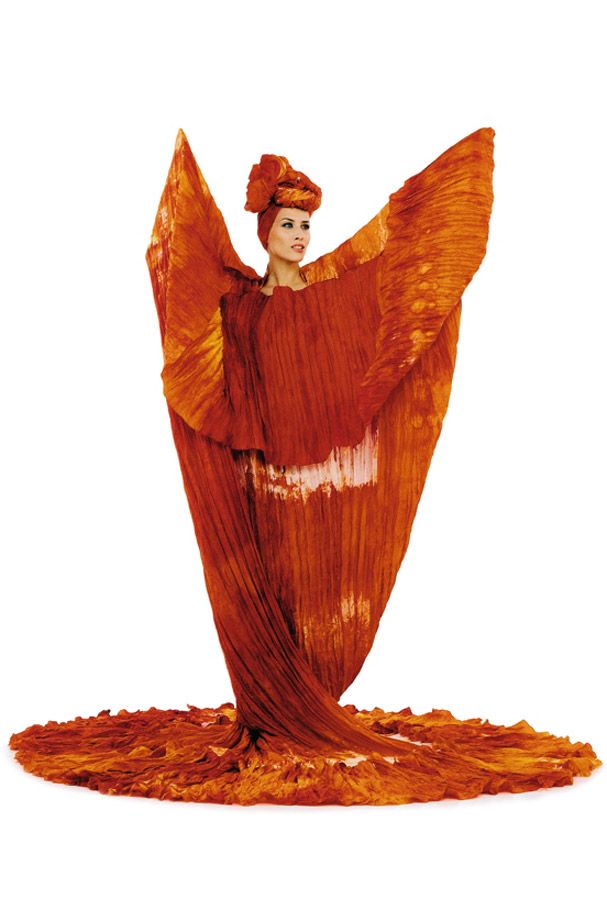
In the Ring of Fire -- painted on silk, pleated
-
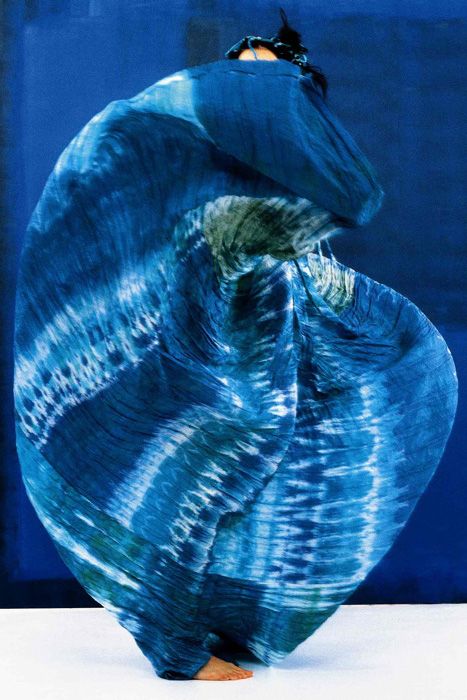
Blue Bird -- painted on silk, shibori, pleated
2000 Art to Wear 2
In America of the sixities a new art movement developed, it called itself Art to Wear or Wearable Art.
In America of the sixities a new art movement developed, it called itself Art to Wear or Wearable Art.
go to post
-
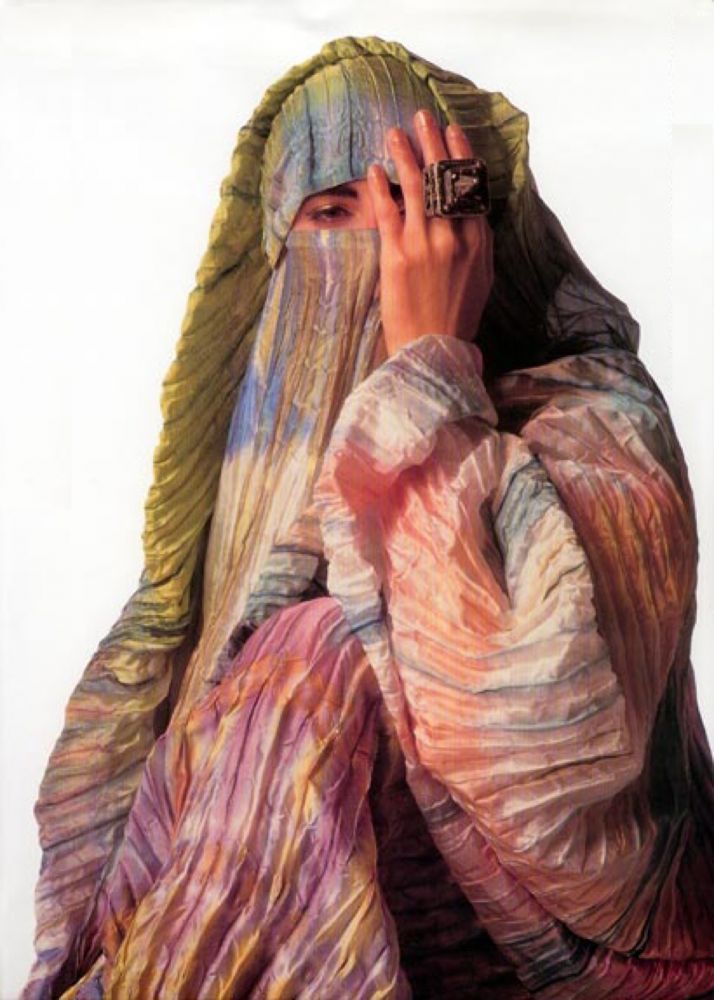
Dress with Burquah -- An Artist handles politics his own way. For me this dress is a symbol of a brigde between Islamism and Christianity. -- mm, 1995
-

Dress for Eternity - This is my personal favorite.
Worn as a dress or hanging from a wall it satisfies me in both ways, because it radiates the same meaning: Created for eternity.
-
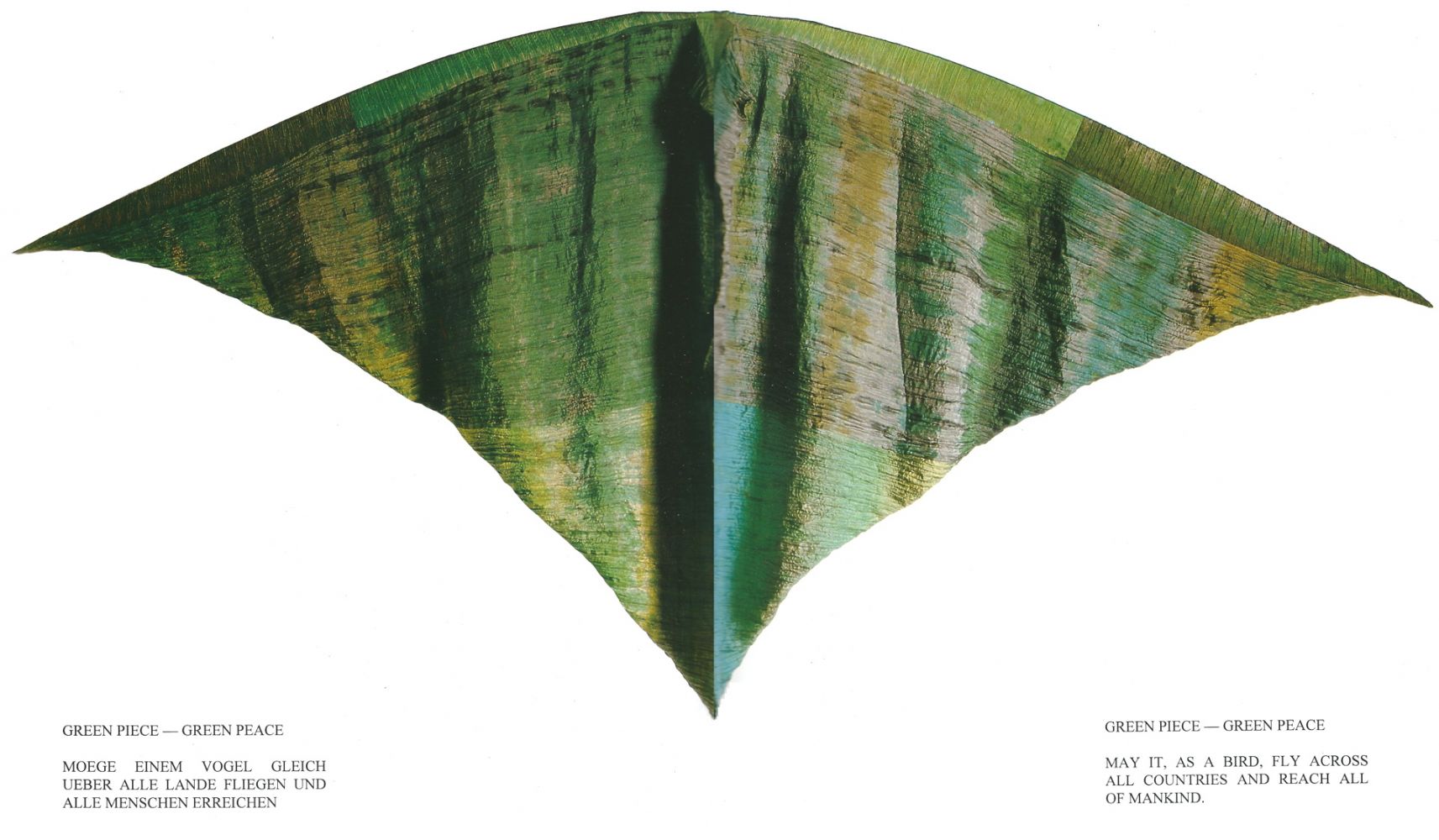
Green Piece - Green Peace
May it, as a bird, fly across all countries and reach all of mankind -
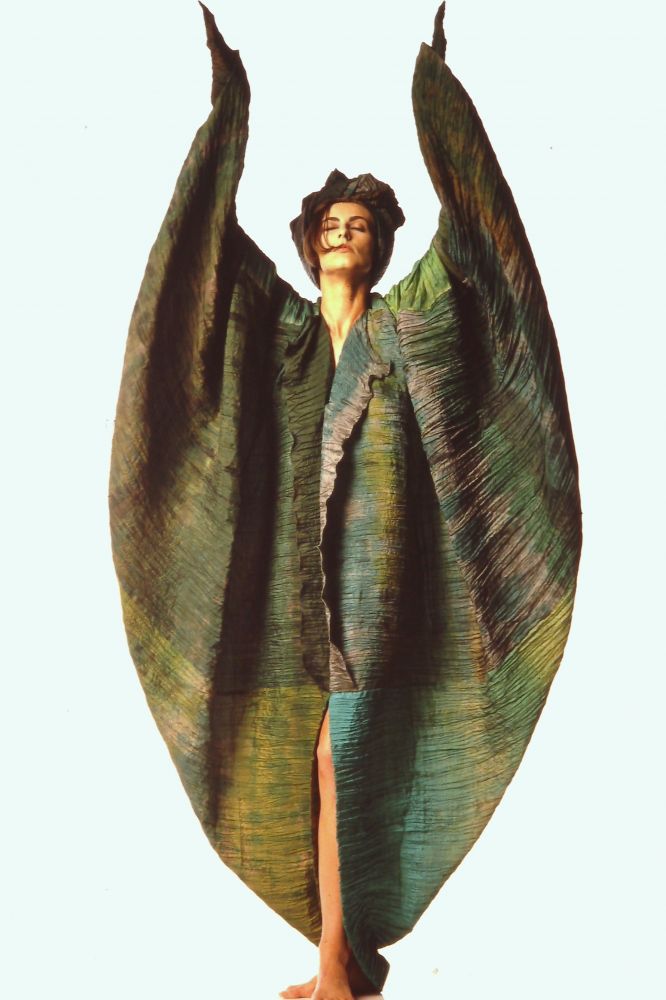
Green Piece - Green Piece -- Every dress is also an object of art which finds its place on a wall.
-

Fire Dress -- Tissue lies directly on our skin. it is intimately related with our sense of touch and our physical being, it forms our second, the outer skin -- Anne Wanner (translated from German)
1995 Art to Wear 1
Dress with Burquah
An Artist handles politics his own way. For me this dress is a symbol of a brigde between Islamism and Christianity.
mm, 1995
Dress with Burquah
An Artist handles politics his own way. For me this dress is a symbol of a brigde between Islamism and Christianity.
mm, 1995
go to post
1990/99 Art to Wear Switzerland
The ten artists:
Vreni Blatter
Lile Bürki
Ulrike Dittmann
Mirjam Huber Gerényi
Elise Kägi-Davis
Renate Meyer
Mascha Mioni
Sonja Rhiner
Rosemarie Stampfli
Betti Walt
created during 3333 days wearable artworks, which they presented together at seven galleries and museums in Switzerland, Germany and the USA.
Story of Art-to-Wear Switzerland:
The ten artists:
Vreni Blatter
Lile Bürki
Ulrike Dittmann
Mirjam Huber Gerényi
Elise Kägi-Davis
Renate Meyer
Mascha Mioni
Sonja Rhiner
Rosemarie Stampfli
Betti Walt
created during 3333 days wearable artworks, which they presented together at seven galleries and museums in Switzerland, Germany and the USA.
Story of Art-to-Wear Switzerland:
